Strategic Management GSBS6060 Assignment
VerifiedAdded on 2021/08/23
|41
|9657
|19
AI Summary
Contribute Materials
Your contribution can guide someone’s learning journey. Share your
documents today.
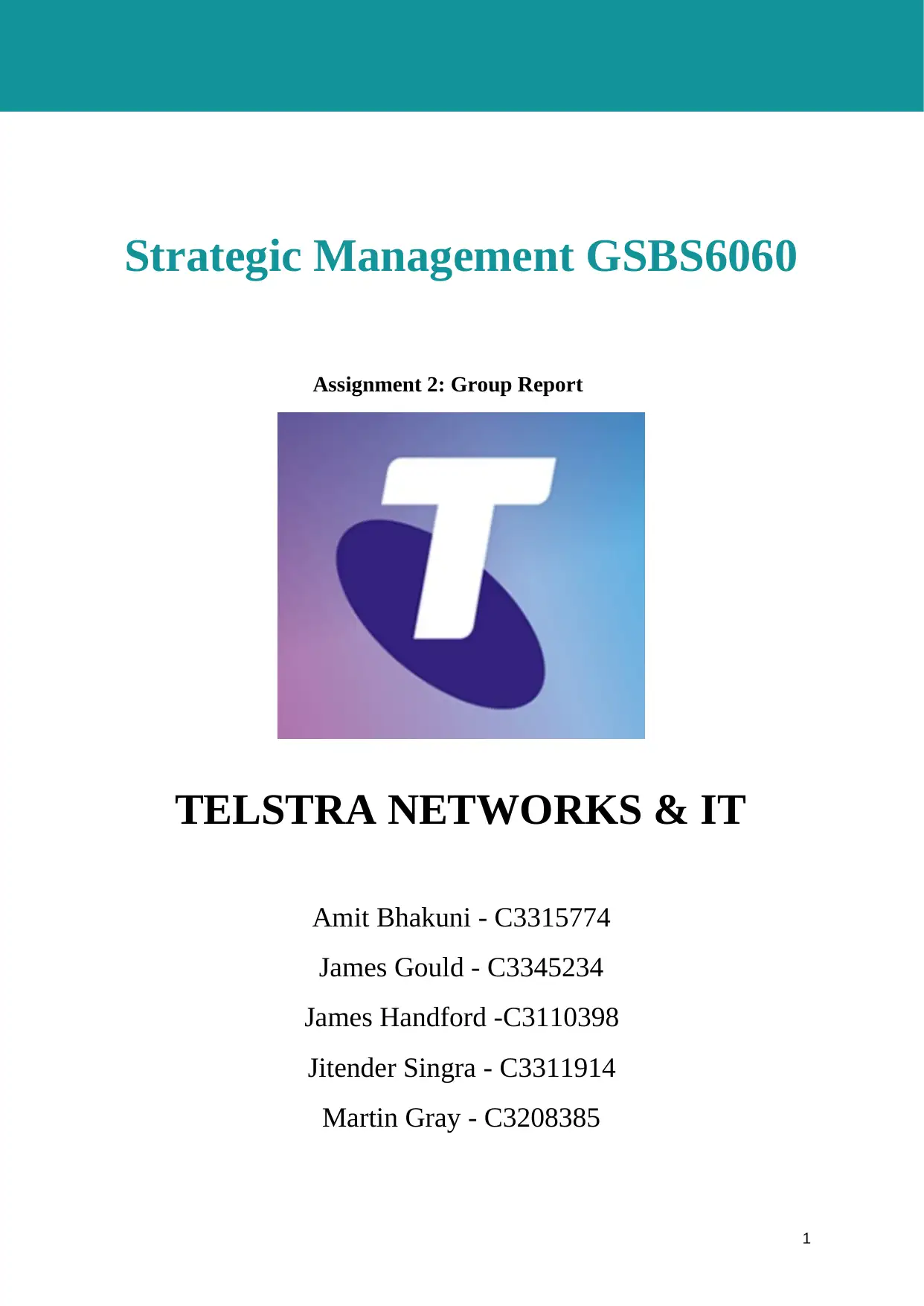
Strategic Management GSBS6060
Assignment 2: Group Report
TELSTRA NETWORKS & IT
Amit Bhakuni - C3315774
James Gould - C3345234
James Handford -C3110398
Jitender Singra - C3311914
Martin Gray - C3208385
1
Assignment 2: Group Report
TELSTRA NETWORKS & IT
Amit Bhakuni - C3315774
James Gould - C3345234
James Handford -C3110398
Jitender Singra - C3311914
Martin Gray - C3208385
1
Secure Best Marks with AI Grader
Need help grading? Try our AI Grader for instant feedback on your assignments.
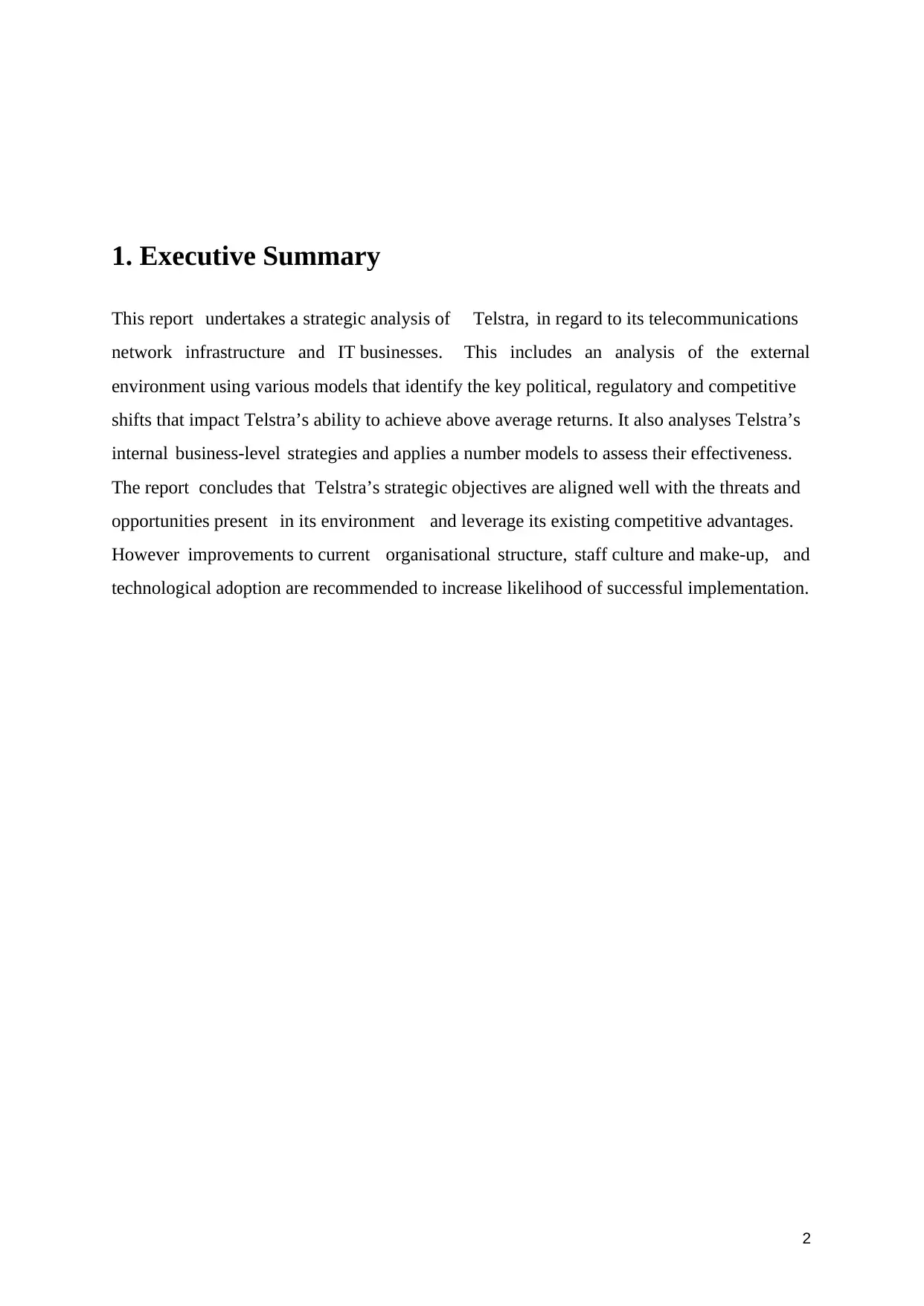
1. Executive Summary
This report undertakes a strategic analysis of Telstra, in regard to its telecommunications
network infrastructure and IT businesses. This includes an analysis of the external
environment using various models that identify the key political, regulatory and competitive
shifts that impact Telstra’s ability to achieve above average returns. It also analyses Telstra’s
internal business-level strategies and applies a number models to assess their effectiveness.
The report concludes that Telstra’s strategic objectives are aligned well with the threats and
opportunities present in its environment and leverage its existing competitive advantages.
However improvements to current organisational structure, staff culture and make-up, and
technological adoption are recommended to increase likelihood of successful implementation.
2
This report undertakes a strategic analysis of Telstra, in regard to its telecommunications
network infrastructure and IT businesses. This includes an analysis of the external
environment using various models that identify the key political, regulatory and competitive
shifts that impact Telstra’s ability to achieve above average returns. It also analyses Telstra’s
internal business-level strategies and applies a number models to assess their effectiveness.
The report concludes that Telstra’s strategic objectives are aligned well with the threats and
opportunities present in its environment and leverage its existing competitive advantages.
However improvements to current organisational structure, staff culture and make-up, and
technological adoption are recommended to increase likelihood of successful implementation.
2
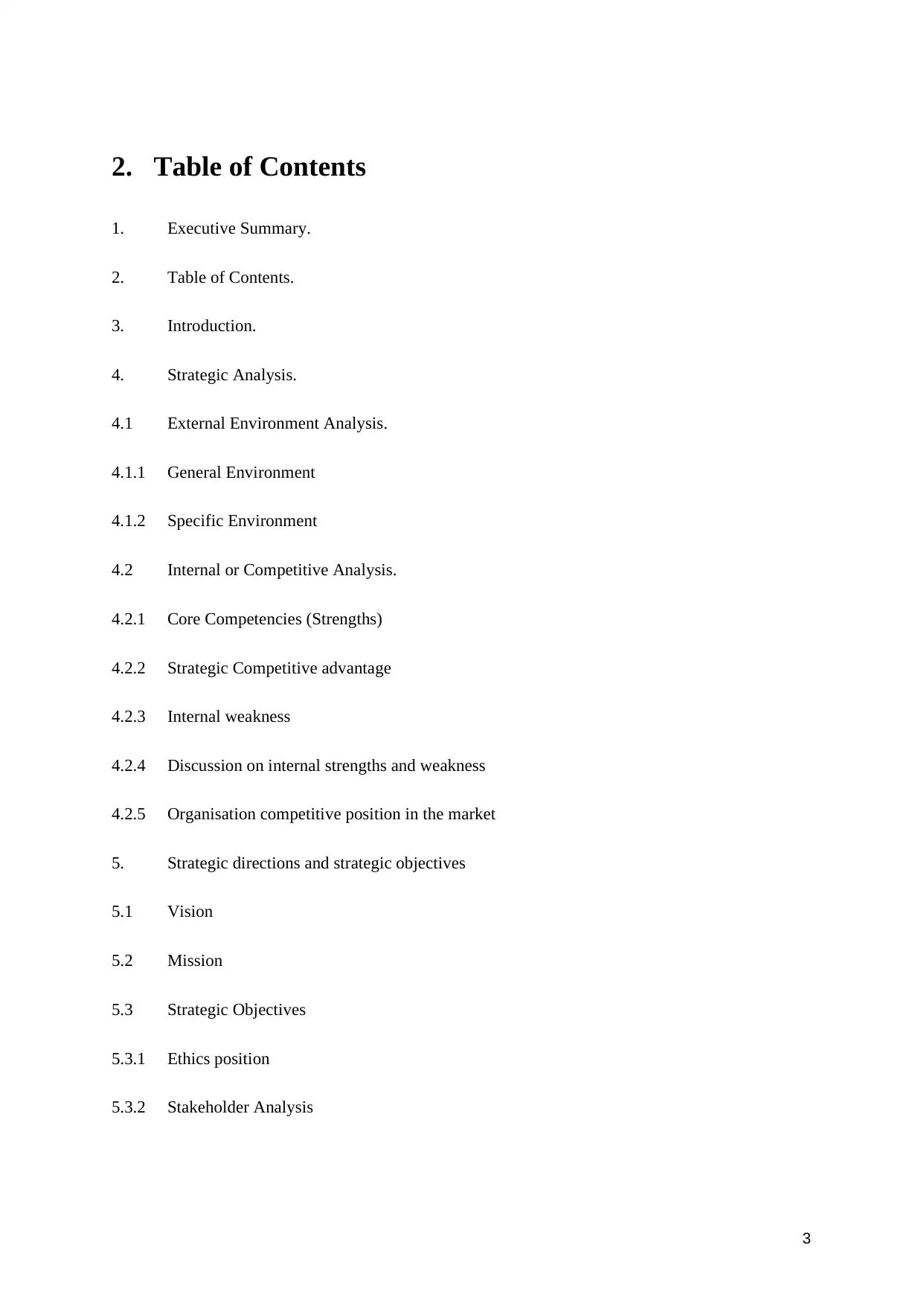
2. Table of Contents
1. Executive Summary.
2. Table of Contents.
3. Introduction.
4. Strategic Analysis.
4.1 External Environment Analysis.
4.1.1 General Environment
4.1.2 Specific Environment
4.2 Internal or Competitive Analysis.
4.2.1 Core Competencies (Strengths)
4.2.2 Strategic Competitive advantage
4.2.3 Internal weakness
4.2.4 Discussion on internal strengths and weakness
4.2.5 Organisation competitive position in the market
5. Strategic directions and strategic objectives
5.1 Vision
5.2 Mission
5.3 Strategic Objectives
5.3.1 Ethics position
5.3.2 Stakeholder Analysis
3
1. Executive Summary.
2. Table of Contents.
3. Introduction.
4. Strategic Analysis.
4.1 External Environment Analysis.
4.1.1 General Environment
4.1.2 Specific Environment
4.2 Internal or Competitive Analysis.
4.2.1 Core Competencies (Strengths)
4.2.2 Strategic Competitive advantage
4.2.3 Internal weakness
4.2.4 Discussion on internal strengths and weakness
4.2.5 Organisation competitive position in the market
5. Strategic directions and strategic objectives
5.1 Vision
5.2 Mission
5.3 Strategic Objectives
5.3.1 Ethics position
5.3.2 Stakeholder Analysis
3
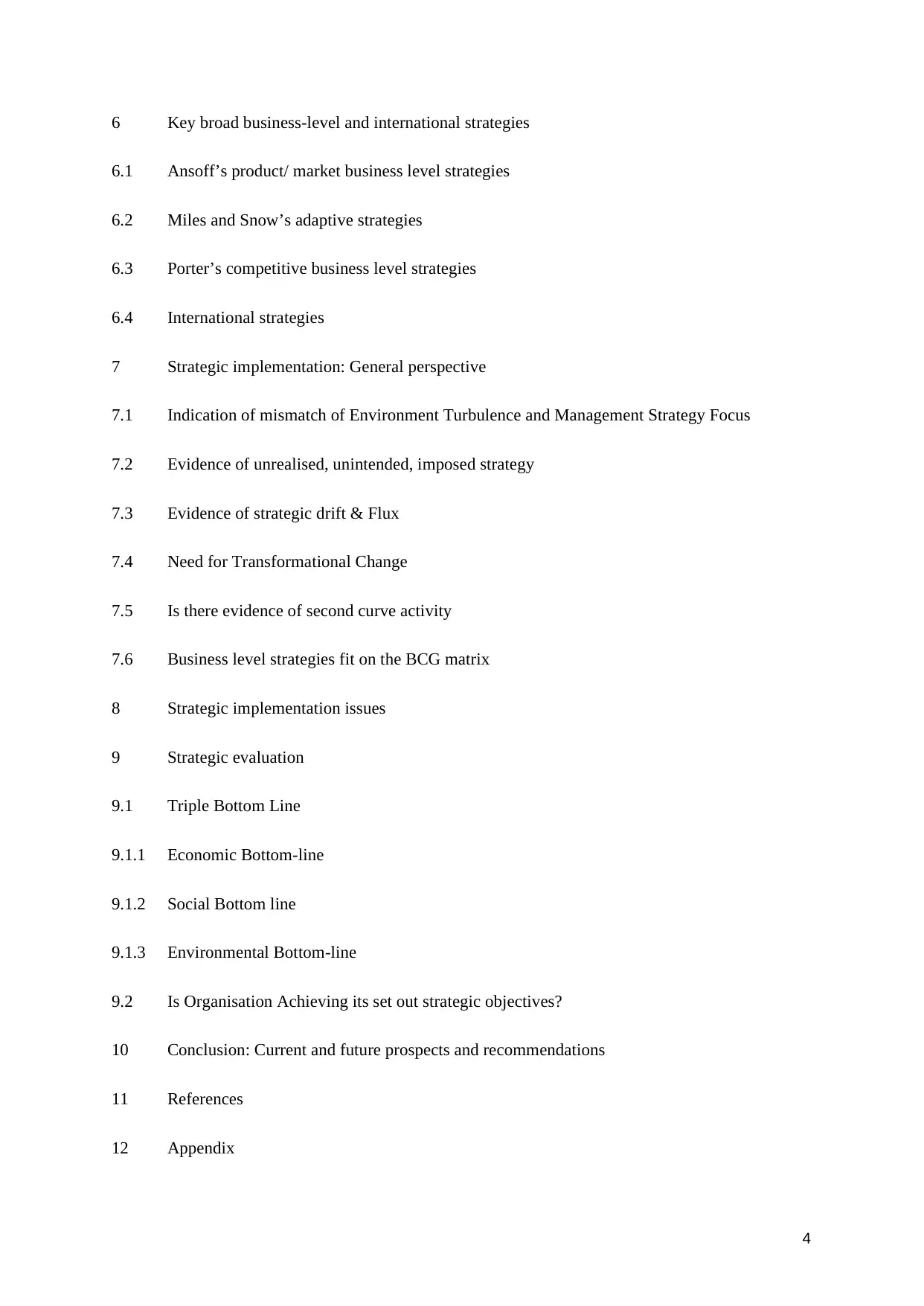
6 Key broad business-level and international strategies
6.1 Ansoff’s product/ market business level strategies
6.2 Miles and Snow’s adaptive strategies
6.3 Porter’s competitive business level strategies
6.4 International strategies
7 Strategic implementation: General perspective
7.1 Indication of mismatch of Environment Turbulence and Management Strategy Focus
7.2 Evidence of unrealised, unintended, imposed strategy
7.3 Evidence of strategic drift & Flux
7.4 Need for Transformational Change
7.5 Is there evidence of second curve activity
7.6 Business level strategies fit on the BCG matrix
8 Strategic implementation issues
9 Strategic evaluation
9.1 Triple Bottom Line
9.1.1 Economic Bottom-line
9.1.2 Social Bottom line
9.1.3 Environmental Bottom-line
9.2 Is Organisation Achieving its set out strategic objectives?
10 Conclusion: Current and future prospects and recommendations
11 References
12 Appendix
4
6.1 Ansoff’s product/ market business level strategies
6.2 Miles and Snow’s adaptive strategies
6.3 Porter’s competitive business level strategies
6.4 International strategies
7 Strategic implementation: General perspective
7.1 Indication of mismatch of Environment Turbulence and Management Strategy Focus
7.2 Evidence of unrealised, unintended, imposed strategy
7.3 Evidence of strategic drift & Flux
7.4 Need for Transformational Change
7.5 Is there evidence of second curve activity
7.6 Business level strategies fit on the BCG matrix
8 Strategic implementation issues
9 Strategic evaluation
9.1 Triple Bottom Line
9.1.1 Economic Bottom-line
9.1.2 Social Bottom line
9.1.3 Environmental Bottom-line
9.2 Is Organisation Achieving its set out strategic objectives?
10 Conclusion: Current and future prospects and recommendations
11 References
12 Appendix
4
Secure Best Marks with AI Grader
Need help grading? Try our AI Grader for instant feedback on your assignments.
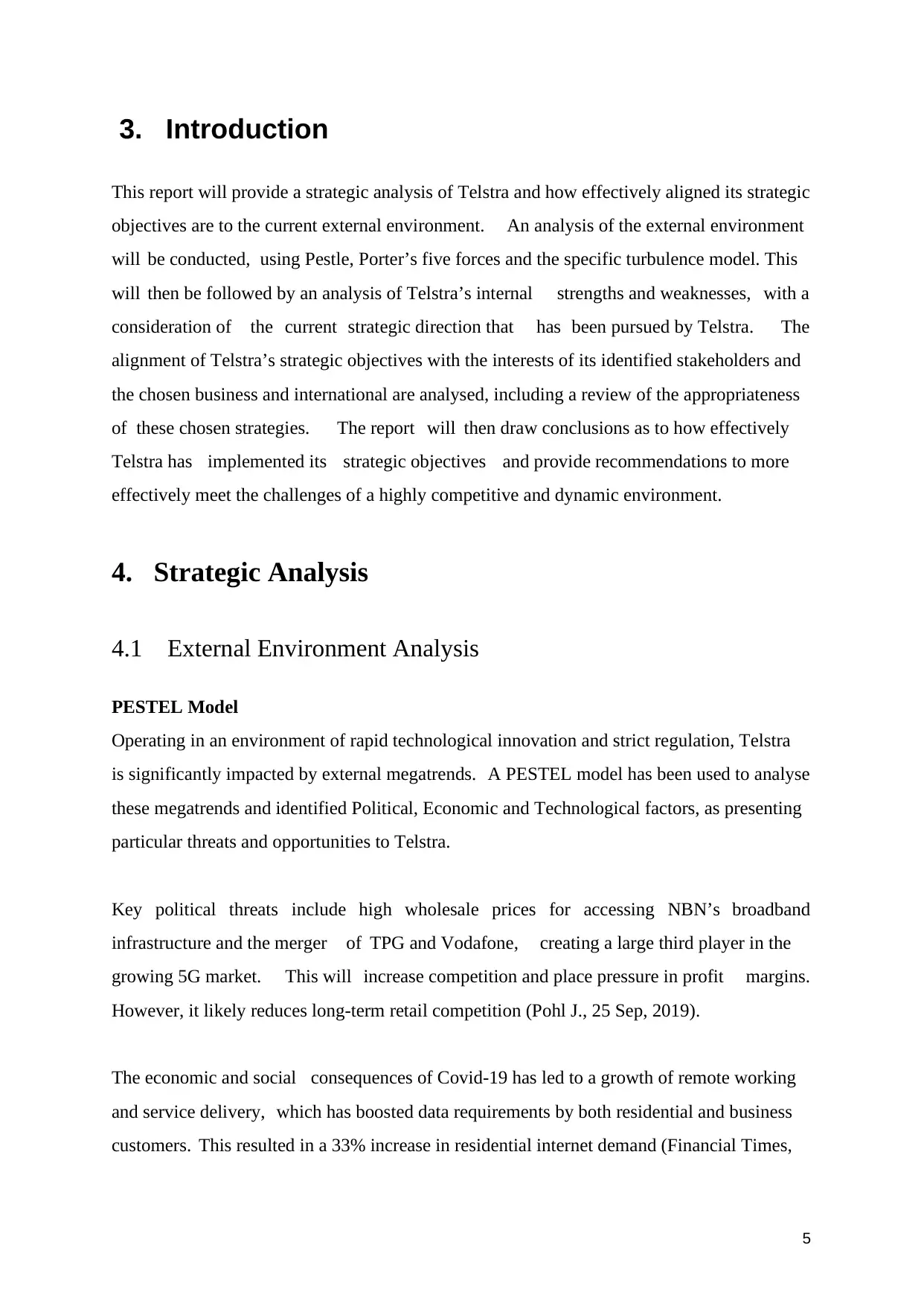
3. Introduction
This report will provide a strategic analysis of Telstra and how effectively aligned its strategic
objectives are to the current external environment. An analysis of the external environment
will be conducted, using Pestle, Porter’s five forces and the specific turbulence model. This
will then be followed by an analysis of Telstra’s internal strengths and weaknesses, with a
consideration of the current strategic direction that has been pursued by Telstra. The
alignment of Telstra’s strategic objectives with the interests of its identified stakeholders and
the chosen business and international are analysed, including a review of the appropriateness
of these chosen strategies. The report will then draw conclusions as to how effectively
Telstra has implemented its strategic objectives and provide recommendations to more
effectively meet the challenges of a highly competitive and dynamic environment.
4. Strategic Analysis
4.1 External Environment Analysis
PESTEL Model
Operating in an environment of rapid technological innovation and strict regulation, Telstra
is significantly impacted by external megatrends. A PESTEL model has been used to analyse
these megatrends and identified Political, Economic and Technological factors, as presenting
particular threats and opportunities to Telstra.
Key political threats include high wholesale prices for accessing NBN’s broadband
infrastructure and the merger of TPG and Vodafone, creating a large third player in the
growing 5G market. This will increase competition and place pressure in profit margins.
However, it likely reduces long-term retail competition (Pohl J., 25 Sep, 2019).
The economic and social consequences of Covid-19 has led to a growth of remote working
and service delivery, which has boosted data requirements by both residential and business
customers. This resulted in a 33% increase in residential internet demand (Financial Times,
5
This report will provide a strategic analysis of Telstra and how effectively aligned its strategic
objectives are to the current external environment. An analysis of the external environment
will be conducted, using Pestle, Porter’s five forces and the specific turbulence model. This
will then be followed by an analysis of Telstra’s internal strengths and weaknesses, with a
consideration of the current strategic direction that has been pursued by Telstra. The
alignment of Telstra’s strategic objectives with the interests of its identified stakeholders and
the chosen business and international are analysed, including a review of the appropriateness
of these chosen strategies. The report will then draw conclusions as to how effectively
Telstra has implemented its strategic objectives and provide recommendations to more
effectively meet the challenges of a highly competitive and dynamic environment.
4. Strategic Analysis
4.1 External Environment Analysis
PESTEL Model
Operating in an environment of rapid technological innovation and strict regulation, Telstra
is significantly impacted by external megatrends. A PESTEL model has been used to analyse
these megatrends and identified Political, Economic and Technological factors, as presenting
particular threats and opportunities to Telstra.
Key political threats include high wholesale prices for accessing NBN’s broadband
infrastructure and the merger of TPG and Vodafone, creating a large third player in the
growing 5G market. This will increase competition and place pressure in profit margins.
However, it likely reduces long-term retail competition (Pohl J., 25 Sep, 2019).
The economic and social consequences of Covid-19 has led to a growth of remote working
and service delivery, which has boosted data requirements by both residential and business
customers. This resulted in a 33% increase in residential internet demand (Financial Times,
5
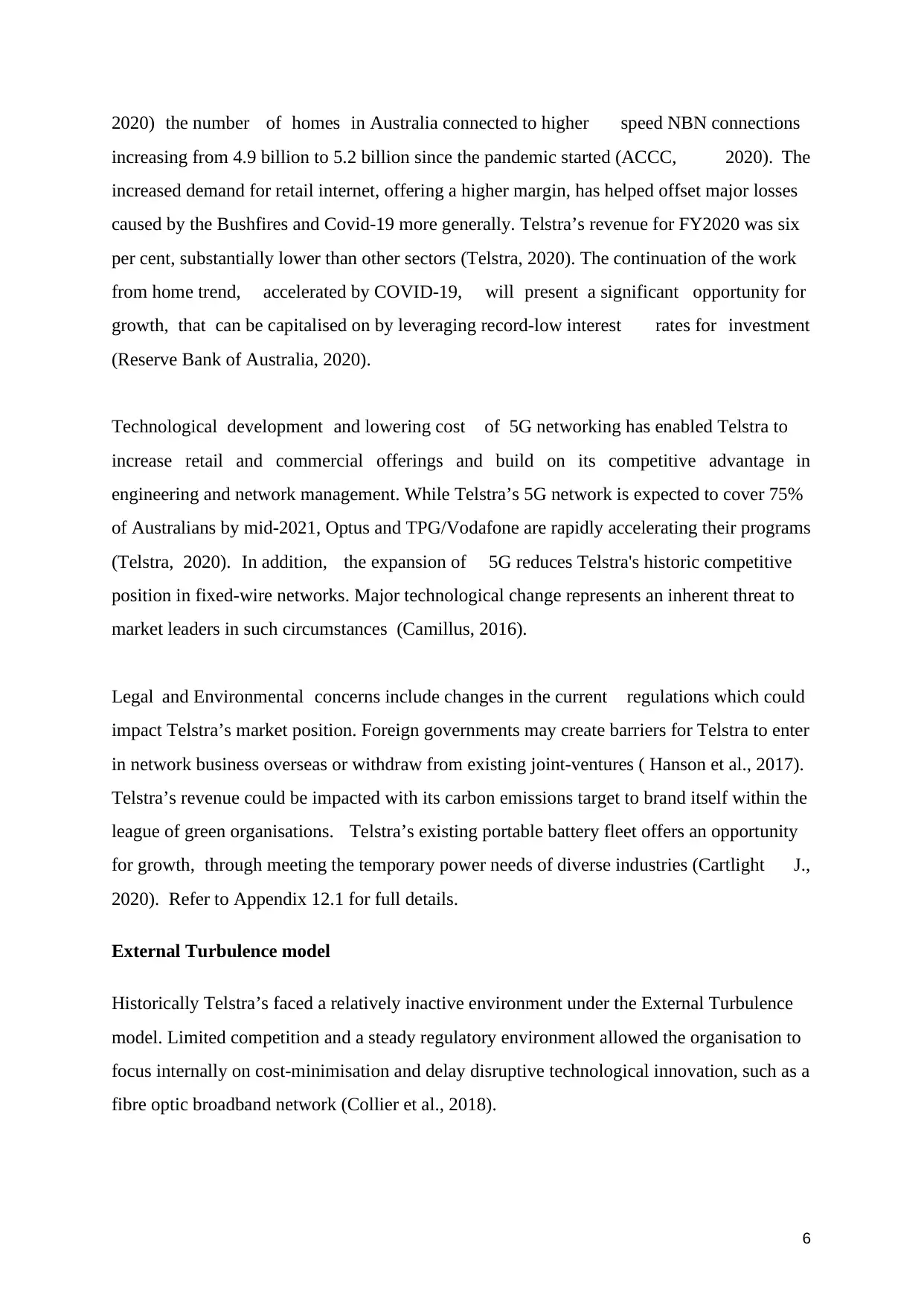
2020) the number of homes in Australia connected to higher speed NBN connections
increasing from 4.9 billion to 5.2 billion since the pandemic started (ACCC, 2020). The
increased demand for retail internet, offering a higher margin, has helped offset major losses
caused by the Bushfires and Covid-19 more generally. Telstra’s revenue for FY2020 was six
per cent, substantially lower than other sectors (Telstra, 2020). The continuation of the work
from home trend, accelerated by COVID-19, will present a significant opportunity for
growth, that can be capitalised on by leveraging record-low interest rates for investment
(Reserve Bank of Australia, 2020).
Technological development and lowering cost of 5G networking has enabled Telstra to
increase retail and commercial offerings and build on its competitive advantage in
engineering and network management. While Telstra’s 5G network is expected to cover 75%
of Australians by mid-2021, Optus and TPG/Vodafone are rapidly accelerating their programs
(Telstra, 2020). In addition, the expansion of 5G reduces Telstra's historic competitive
position in fixed-wire networks. Major technological change represents an inherent threat to
market leaders in such circumstances (Camillus, 2016).
Legal and Environmental concerns include changes in the current regulations which could
impact Telstra’s market position. Foreign governments may create barriers for Telstra to enter
in network business overseas or withdraw from existing joint-ventures ( Hanson et al., 2017).
Telstra’s revenue could be impacted with its carbon emissions target to brand itself within the
league of green organisations. Telstra’s existing portable battery fleet offers an opportunity
for growth, through meeting the temporary power needs of diverse industries (Cartlight J.,
2020). Refer to Appendix 12.1 for full details.
External Turbulence model
Historically Telstra’s faced a relatively inactive environment under the External Turbulence
model. Limited competition and a steady regulatory environment allowed the organisation to
focus internally on cost-minimisation and delay disruptive technological innovation, such as a
fibre optic broadband network (Collier et al., 2018).
6
increasing from 4.9 billion to 5.2 billion since the pandemic started (ACCC, 2020). The
increased demand for retail internet, offering a higher margin, has helped offset major losses
caused by the Bushfires and Covid-19 more generally. Telstra’s revenue for FY2020 was six
per cent, substantially lower than other sectors (Telstra, 2020). The continuation of the work
from home trend, accelerated by COVID-19, will present a significant opportunity for
growth, that can be capitalised on by leveraging record-low interest rates for investment
(Reserve Bank of Australia, 2020).
Technological development and lowering cost of 5G networking has enabled Telstra to
increase retail and commercial offerings and build on its competitive advantage in
engineering and network management. While Telstra’s 5G network is expected to cover 75%
of Australians by mid-2021, Optus and TPG/Vodafone are rapidly accelerating their programs
(Telstra, 2020). In addition, the expansion of 5G reduces Telstra's historic competitive
position in fixed-wire networks. Major technological change represents an inherent threat to
market leaders in such circumstances (Camillus, 2016).
Legal and Environmental concerns include changes in the current regulations which could
impact Telstra’s market position. Foreign governments may create barriers for Telstra to enter
in network business overseas or withdraw from existing joint-ventures ( Hanson et al., 2017).
Telstra’s revenue could be impacted with its carbon emissions target to brand itself within the
league of green organisations. Telstra’s existing portable battery fleet offers an opportunity
for growth, through meeting the temporary power needs of diverse industries (Cartlight J.,
2020). Refer to Appendix 12.1 for full details.
External Turbulence model
Historically Telstra’s faced a relatively inactive environment under the External Turbulence
model. Limited competition and a steady regulatory environment allowed the organisation to
focus internally on cost-minimisation and delay disruptive technological innovation, such as a
fibre optic broadband network (Collier et al., 2018).
6
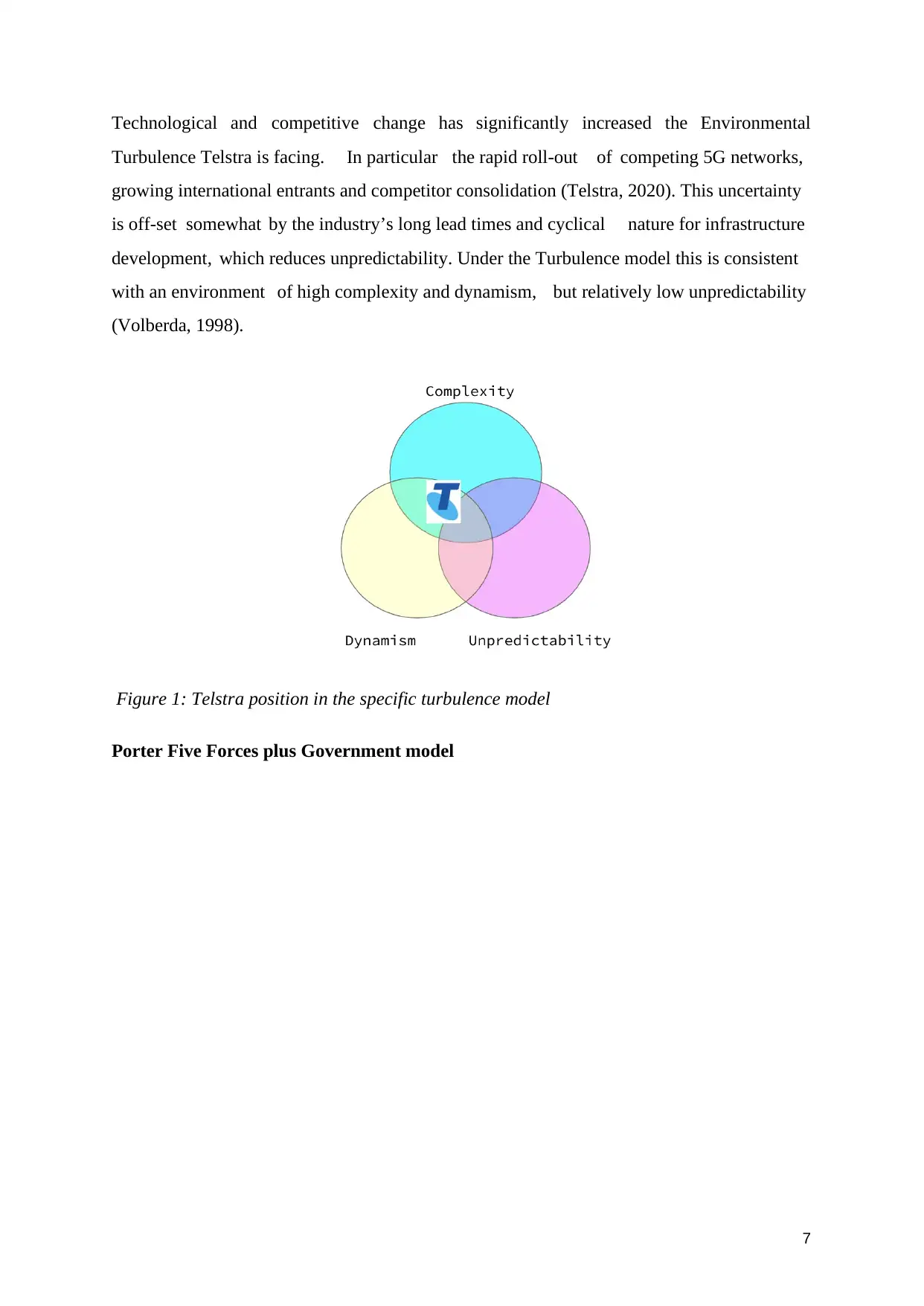
Technological and competitive change has significantly increased the Environmental
Turbulence Telstra is facing. In particular the rapid roll-out of competing 5G networks,
growing international entrants and competitor consolidation (Telstra, 2020). This uncertainty
is off-set somewhat by the industry’s long lead times and cyclical nature for infrastructure
development, which reduces unpredictability. Under the Turbulence model this is consistent
with an environment of high complexity and dynamism, but relatively low unpredictability
(Volberda, 1998).
Figure 1: Telstra position in the specific turbulence model
Porter Five Forces plus Government model
7
Turbulence Telstra is facing. In particular the rapid roll-out of competing 5G networks,
growing international entrants and competitor consolidation (Telstra, 2020). This uncertainty
is off-set somewhat by the industry’s long lead times and cyclical nature for infrastructure
development, which reduces unpredictability. Under the Turbulence model this is consistent
with an environment of high complexity and dynamism, but relatively low unpredictability
(Volberda, 1998).
Figure 1: Telstra position in the specific turbulence model
Porter Five Forces plus Government model
7
Paraphrase This Document
Need a fresh take? Get an instant paraphrase of this document with our AI Paraphraser
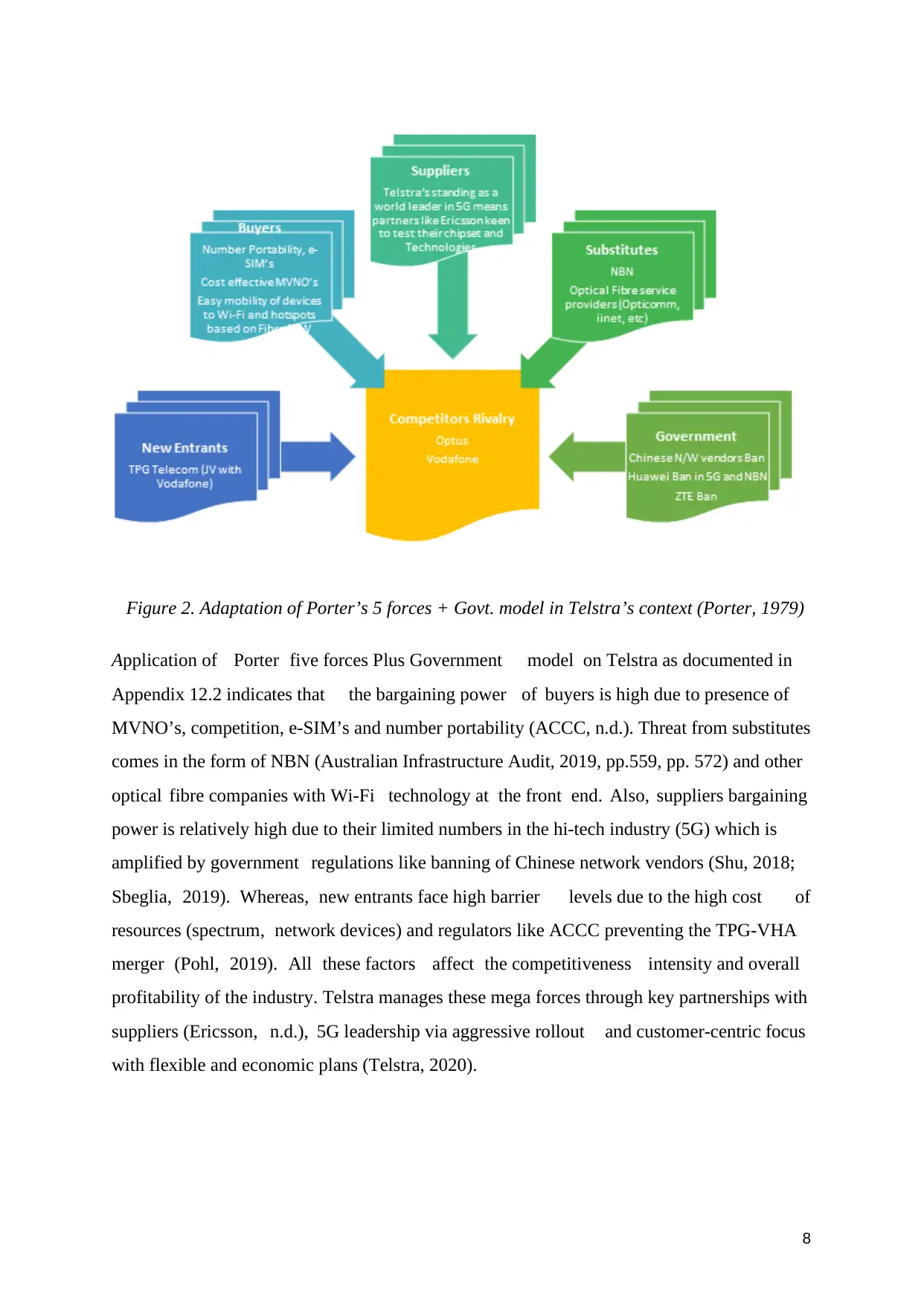
Figure 2. Adaptation of Porter’s 5 forces + Govt. model in Telstra’s context (Porter, 1979)
Application of Porter five forces Plus Government model on Telstra as documented in
Appendix 12.2 indicates that the bargaining power of buyers is high due to presence of
MVNO’s, competition, e-SIM’s and number portability (ACCC, n.d.). Threat from substitutes
comes in the form of NBN (Australian Infrastructure Audit, 2019, pp.559, pp. 572) and other
optical fibre companies with Wi-Fi technology at the front end. Also, suppliers bargaining
power is relatively high due to their limited numbers in the hi-tech industry (5G) which is
amplified by government regulations like banning of Chinese network vendors (Shu, 2018;
Sbeglia, 2019). Whereas, new entrants face high barrier levels due to the high cost of
resources (spectrum, network devices) and regulators like ACCC preventing the TPG-VHA
merger (Pohl, 2019). All these factors affect the competitiveness intensity and overall
profitability of the industry. Telstra manages these mega forces through key partnerships with
suppliers (Ericsson, n.d.), 5G leadership via aggressive rollout and customer-centric focus
with flexible and economic plans (Telstra, 2020).
8
Application of Porter five forces Plus Government model on Telstra as documented in
Appendix 12.2 indicates that the bargaining power of buyers is high due to presence of
MVNO’s, competition, e-SIM’s and number portability (ACCC, n.d.). Threat from substitutes
comes in the form of NBN (Australian Infrastructure Audit, 2019, pp.559, pp. 572) and other
optical fibre companies with Wi-Fi technology at the front end. Also, suppliers bargaining
power is relatively high due to their limited numbers in the hi-tech industry (5G) which is
amplified by government regulations like banning of Chinese network vendors (Shu, 2018;
Sbeglia, 2019). Whereas, new entrants face high barrier levels due to the high cost of
resources (spectrum, network devices) and regulators like ACCC preventing the TPG-VHA
merger (Pohl, 2019). All these factors affect the competitiveness intensity and overall
profitability of the industry. Telstra manages these mega forces through key partnerships with
suppliers (Ericsson, n.d.), 5G leadership via aggressive rollout and customer-centric focus
with flexible and economic plans (Telstra, 2020).
8
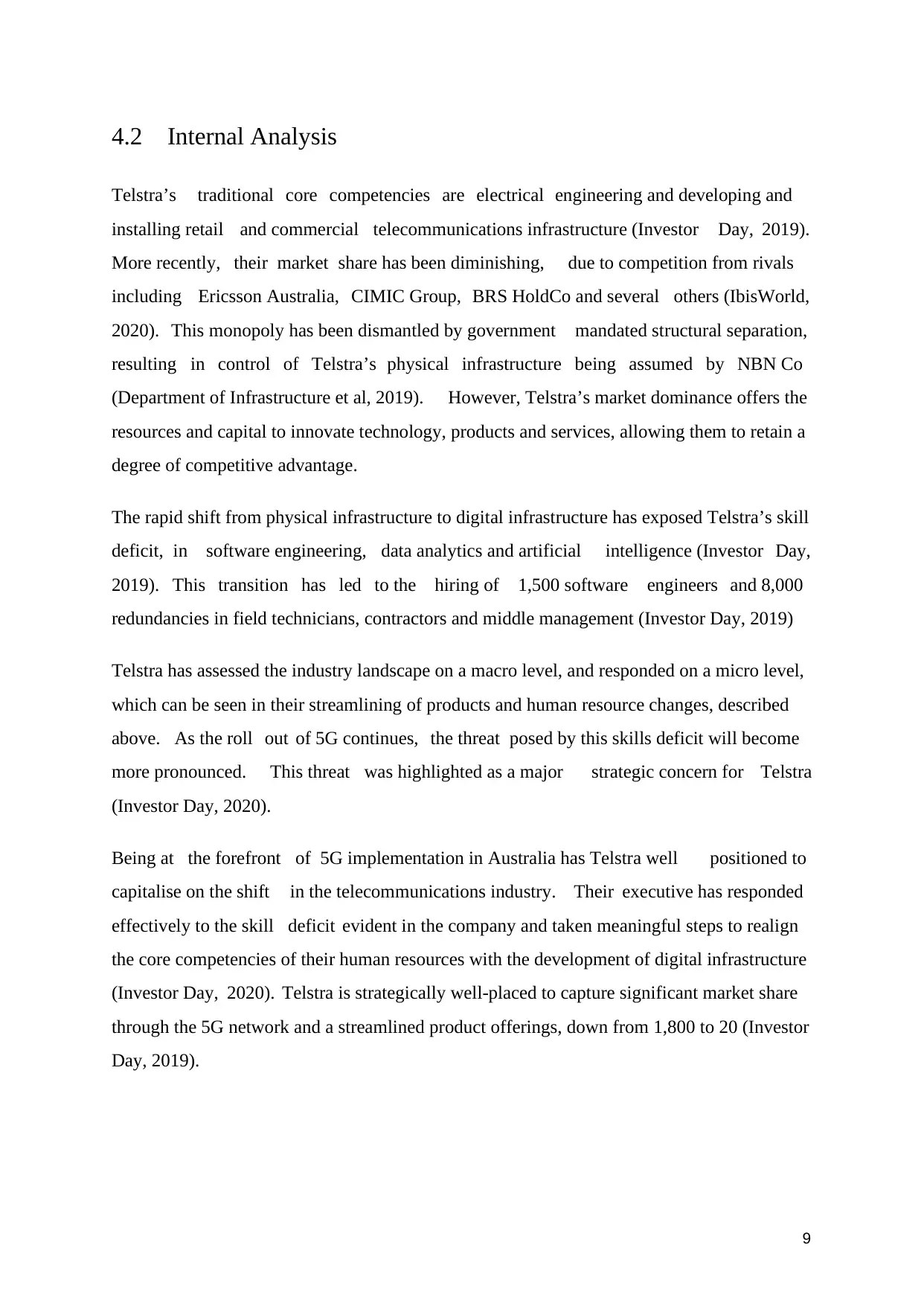
4.2 Internal Analysis
Telstra’s traditional core competencies are electrical engineering and developing and
installing retail and commercial telecommunications infrastructure (Investor Day, 2019).
More recently, their market share has been diminishing, due to competition from rivals
including Ericsson Australia, CIMIC Group, BRS HoldCo and several others (IbisWorld,
2020). This monopoly has been dismantled by government mandated structural separation,
resulting in control of Telstra’s physical infrastructure being assumed by NBN Co
(Department of Infrastructure et al, 2019). However, Telstra’s market dominance offers the
resources and capital to innovate technology, products and services, allowing them to retain a
degree of competitive advantage.
The rapid shift from physical infrastructure to digital infrastructure has exposed Telstra’s skill
deficit, in software engineering, data analytics and artificial intelligence (Investor Day,
2019). This transition has led to the hiring of 1,500 software engineers and 8,000
redundancies in field technicians, contractors and middle management (Investor Day, 2019)
Telstra has assessed the industry landscape on a macro level, and responded on a micro level,
which can be seen in their streamlining of products and human resource changes, described
above. As the roll out of 5G continues, the threat posed by this skills deficit will become
more pronounced. This threat was highlighted as a major strategic concern for Telstra
(Investor Day, 2020).
Being at the forefront of 5G implementation in Australia has Telstra well positioned to
capitalise on the shift in the telecommunications industry. Their executive has responded
effectively to the skill deficit evident in the company and taken meaningful steps to realign
the core competencies of their human resources with the development of digital infrastructure
(Investor Day, 2020). Telstra is strategically well-placed to capture significant market share
through the 5G network and a streamlined product offerings, down from 1,800 to 20 (Investor
Day, 2019).
9
Telstra’s traditional core competencies are electrical engineering and developing and
installing retail and commercial telecommunications infrastructure (Investor Day, 2019).
More recently, their market share has been diminishing, due to competition from rivals
including Ericsson Australia, CIMIC Group, BRS HoldCo and several others (IbisWorld,
2020). This monopoly has been dismantled by government mandated structural separation,
resulting in control of Telstra’s physical infrastructure being assumed by NBN Co
(Department of Infrastructure et al, 2019). However, Telstra’s market dominance offers the
resources and capital to innovate technology, products and services, allowing them to retain a
degree of competitive advantage.
The rapid shift from physical infrastructure to digital infrastructure has exposed Telstra’s skill
deficit, in software engineering, data analytics and artificial intelligence (Investor Day,
2019). This transition has led to the hiring of 1,500 software engineers and 8,000
redundancies in field technicians, contractors and middle management (Investor Day, 2019)
Telstra has assessed the industry landscape on a macro level, and responded on a micro level,
which can be seen in their streamlining of products and human resource changes, described
above. As the roll out of 5G continues, the threat posed by this skills deficit will become
more pronounced. This threat was highlighted as a major strategic concern for Telstra
(Investor Day, 2020).
Being at the forefront of 5G implementation in Australia has Telstra well positioned to
capitalise on the shift in the telecommunications industry. Their executive has responded
effectively to the skill deficit evident in the company and taken meaningful steps to realign
the core competencies of their human resources with the development of digital infrastructure
(Investor Day, 2020). Telstra is strategically well-placed to capture significant market share
through the 5G network and a streamlined product offerings, down from 1,800 to 20 (Investor
Day, 2019).
9
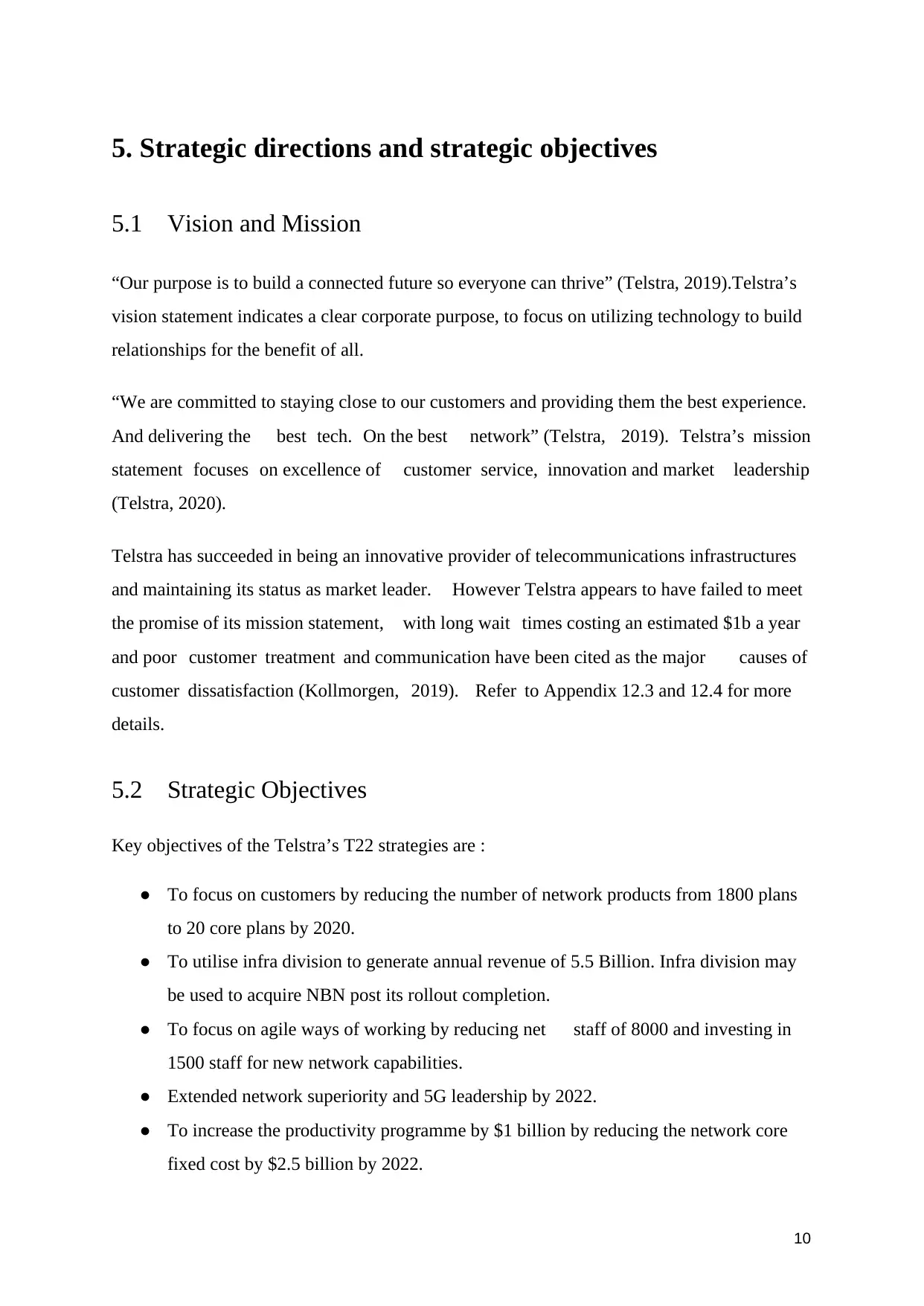
5. Strategic directions and strategic objectives
5.1 Vision and Mission
“Our purpose is to build a connected future so everyone can thrive” (Telstra, 2019).Telstra’s
vision statement indicates a clear corporate purpose, to focus on utilizing technology to build
relationships for the benefit of all.
“We are committed to staying close to our customers and providing them the best experience.
And delivering the best tech. On the best network” (Telstra, 2019). Telstra’s mission
statement focuses on excellence of customer service, innovation and market leadership
(Telstra, 2020).
Telstra has succeeded in being an innovative provider of telecommunications infrastructures
and maintaining its status as market leader. However Telstra appears to have failed to meet
the promise of its mission statement, with long wait times costing an estimated $1b a year
and poor customer treatment and communication have been cited as the major causes of
customer dissatisfaction (Kollmorgen, 2019). Refer to Appendix 12.3 and 12.4 for more
details.
5.2 Strategic Objectives
Key objectives of the Telstra’s T22 strategies are :
● To focus on customers by reducing the number of network products from 1800 plans
to 20 core plans by 2020.
● To utilise infra division to generate annual revenue of 5.5 Billion. Infra division may
be used to acquire NBN post its rollout completion.
● To focus on agile ways of working by reducing net staff of 8000 and investing in
1500 staff for new network capabilities.
● Extended network superiority and 5G leadership by 2022.
● To increase the productivity programme by $1 billion by reducing the network core
fixed cost by $2.5 billion by 2022.
10
5.1 Vision and Mission
“Our purpose is to build a connected future so everyone can thrive” (Telstra, 2019).Telstra’s
vision statement indicates a clear corporate purpose, to focus on utilizing technology to build
relationships for the benefit of all.
“We are committed to staying close to our customers and providing them the best experience.
And delivering the best tech. On the best network” (Telstra, 2019). Telstra’s mission
statement focuses on excellence of customer service, innovation and market leadership
(Telstra, 2020).
Telstra has succeeded in being an innovative provider of telecommunications infrastructures
and maintaining its status as market leader. However Telstra appears to have failed to meet
the promise of its mission statement, with long wait times costing an estimated $1b a year
and poor customer treatment and communication have been cited as the major causes of
customer dissatisfaction (Kollmorgen, 2019). Refer to Appendix 12.3 and 12.4 for more
details.
5.2 Strategic Objectives
Key objectives of the Telstra’s T22 strategies are :
● To focus on customers by reducing the number of network products from 1800 plans
to 20 core plans by 2020.
● To utilise infra division to generate annual revenue of 5.5 Billion. Infra division may
be used to acquire NBN post its rollout completion.
● To focus on agile ways of working by reducing net staff of 8000 and investing in
1500 staff for new network capabilities.
● Extended network superiority and 5G leadership by 2022.
● To increase the productivity programme by $1 billion by reducing the network core
fixed cost by $2.5 billion by 2022.
10
Secure Best Marks with AI Grader
Need help grading? Try our AI Grader for instant feedback on your assignments.
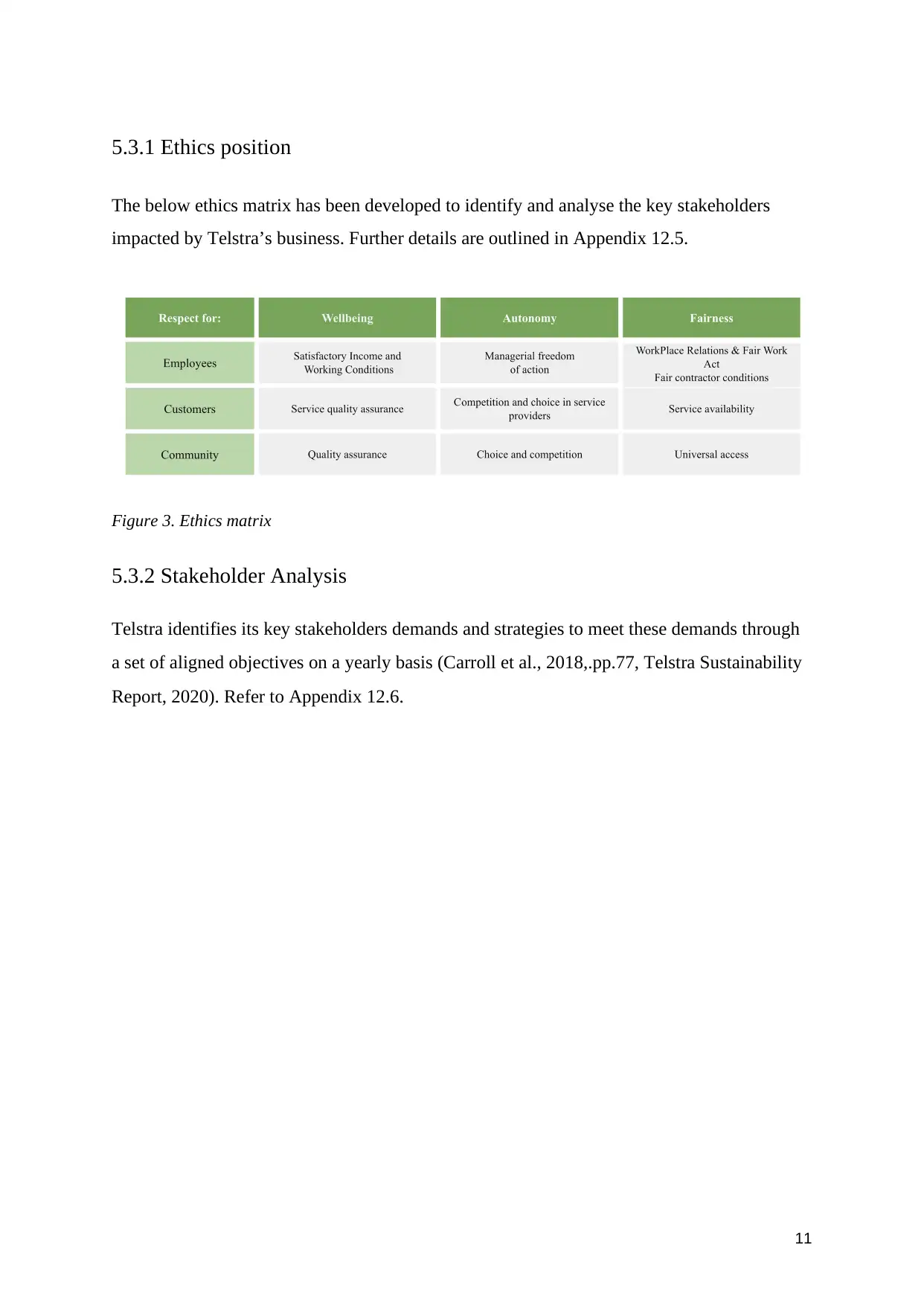
5.3.1 Ethics position
The below ethics matrix has been developed to identify and analyse the key stakeholders
impacted by Telstra’s business. Further details are outlined in Appendix 12.5.
Figure 3. Ethics matrix
5.3.2 Stakeholder Analysis
Telstra identifies its key stakeholders demands and strategies to meet these demands through
a set of aligned objectives on a yearly basis (Carroll et al., 2018,.pp.77, Telstra Sustainability
Report, 2020). Refer to Appendix 12.6.
11
The below ethics matrix has been developed to identify and analyse the key stakeholders
impacted by Telstra’s business. Further details are outlined in Appendix 12.5.
Figure 3. Ethics matrix
5.3.2 Stakeholder Analysis
Telstra identifies its key stakeholders demands and strategies to meet these demands through
a set of aligned objectives on a yearly basis (Carroll et al., 2018,.pp.77, Telstra Sustainability
Report, 2020). Refer to Appendix 12.6.
11
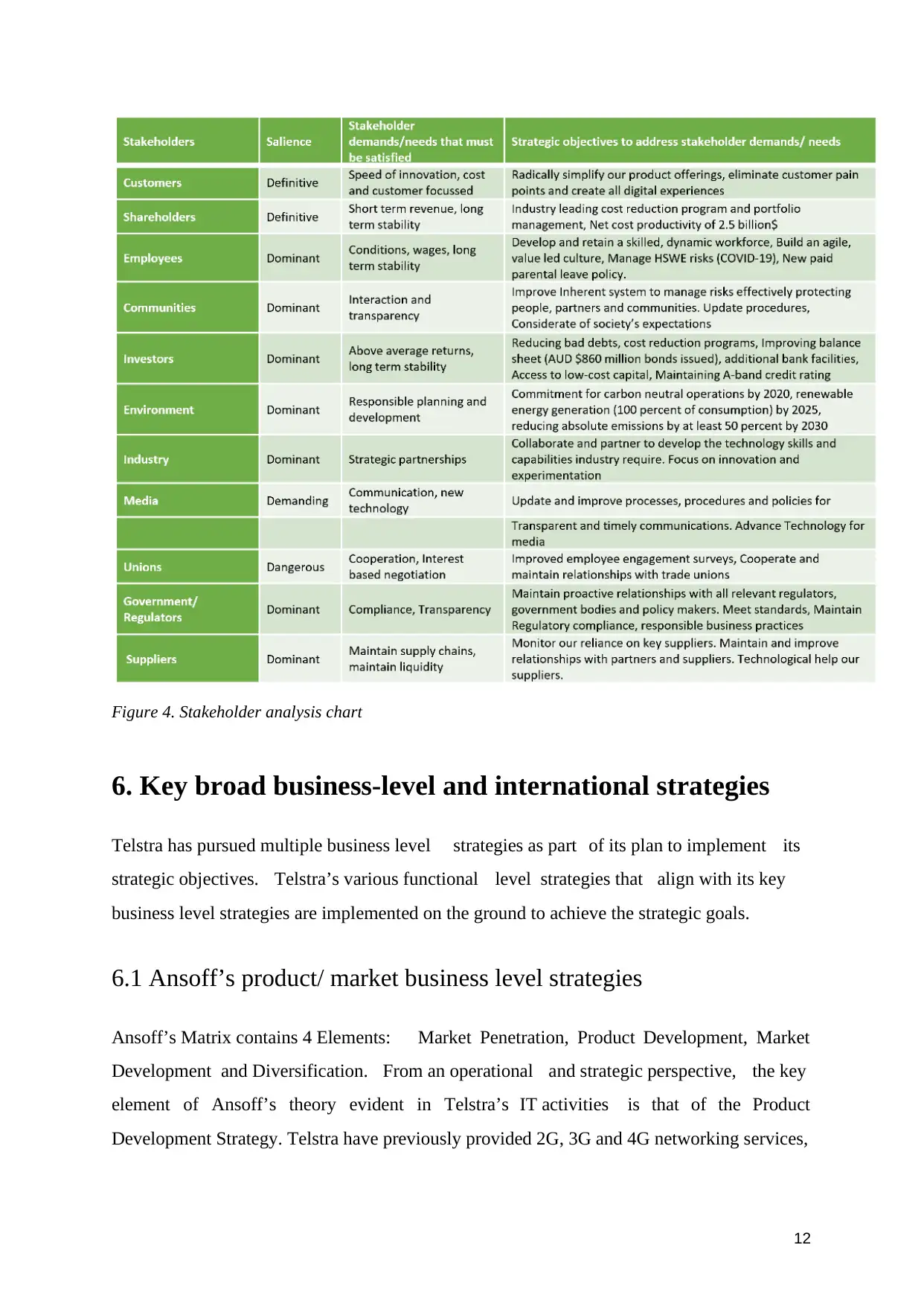
Figure 4. Stakeholder analysis chart
6. Key broad business-level and international strategies
Telstra has pursued multiple business level strategies as part of its plan to implement its
strategic objectives. Telstra’s various functional level strategies that align with its key
business level strategies are implemented on the ground to achieve the strategic goals.
6.1 Ansoff’s product/ market business level strategies
Ansoff’s Matrix contains 4 Elements: Market Penetration, Product Development, Market
Development and Diversification. From an operational and strategic perspective, the key
element of Ansoff’s theory evident in Telstra’s IT activities is that of the Product
Development Strategy. Telstra have previously provided 2G, 3G and 4G networking services,
12
6. Key broad business-level and international strategies
Telstra has pursued multiple business level strategies as part of its plan to implement its
strategic objectives. Telstra’s various functional level strategies that align with its key
business level strategies are implemented on the ground to achieve the strategic goals.
6.1 Ansoff’s product/ market business level strategies
Ansoff’s Matrix contains 4 Elements: Market Penetration, Product Development, Market
Development and Diversification. From an operational and strategic perspective, the key
element of Ansoff’s theory evident in Telstra’s IT activities is that of the Product
Development Strategy. Telstra have previously provided 2G, 3G and 4G networking services,
12
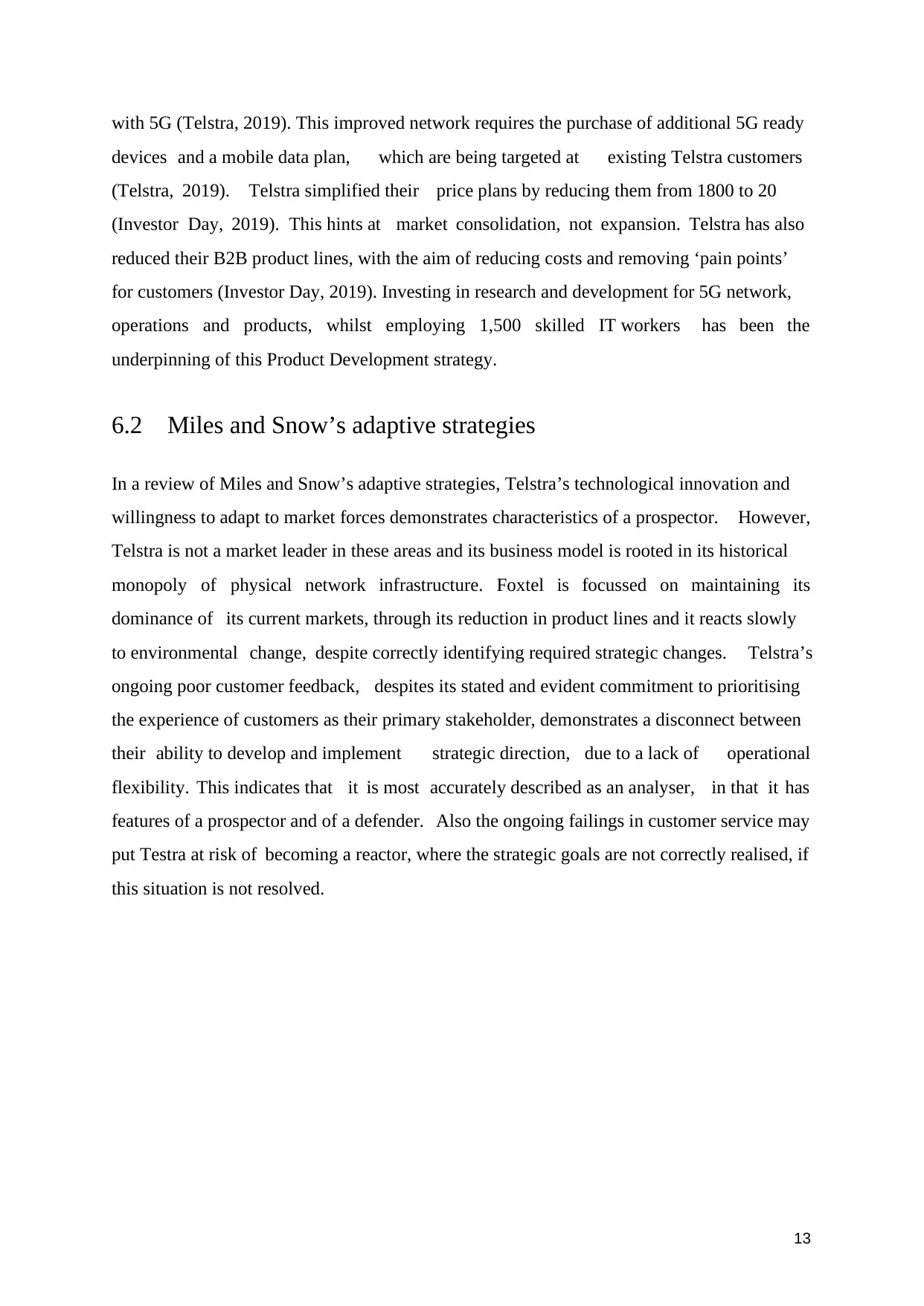
with 5G (Telstra, 2019). This improved network requires the purchase of additional 5G ready
devices and a mobile data plan, which are being targeted at existing Telstra customers
(Telstra, 2019). Telstra simplified their price plans by reducing them from 1800 to 20
(Investor Day, 2019). This hints at market consolidation, not expansion. Telstra has also
reduced their B2B product lines, with the aim of reducing costs and removing ‘pain points’
for customers (Investor Day, 2019). Investing in research and development for 5G network,
operations and products, whilst employing 1,500 skilled IT workers has been the
underpinning of this Product Development strategy.
6.2 Miles and Snow’s adaptive strategies
In a review of Miles and Snow’s adaptive strategies, Telstra’s technological innovation and
willingness to adapt to market forces demonstrates characteristics of a prospector. However,
Telstra is not a market leader in these areas and its business model is rooted in its historical
monopoly of physical network infrastructure. Foxtel is focussed on maintaining its
dominance of its current markets, through its reduction in product lines and it reacts slowly
to environmental change, despite correctly identifying required strategic changes. Telstra’s
ongoing poor customer feedback, despites its stated and evident commitment to prioritising
the experience of customers as their primary stakeholder, demonstrates a disconnect between
their ability to develop and implement strategic direction, due to a lack of operational
flexibility. This indicates that it is most accurately described as an analyser, in that it has
features of a prospector and of a defender. Also the ongoing failings in customer service may
put Testra at risk of becoming a reactor, where the strategic goals are not correctly realised, if
this situation is not resolved.
13
devices and a mobile data plan, which are being targeted at existing Telstra customers
(Telstra, 2019). Telstra simplified their price plans by reducing them from 1800 to 20
(Investor Day, 2019). This hints at market consolidation, not expansion. Telstra has also
reduced their B2B product lines, with the aim of reducing costs and removing ‘pain points’
for customers (Investor Day, 2019). Investing in research and development for 5G network,
operations and products, whilst employing 1,500 skilled IT workers has been the
underpinning of this Product Development strategy.
6.2 Miles and Snow’s adaptive strategies
In a review of Miles and Snow’s adaptive strategies, Telstra’s technological innovation and
willingness to adapt to market forces demonstrates characteristics of a prospector. However,
Telstra is not a market leader in these areas and its business model is rooted in its historical
monopoly of physical network infrastructure. Foxtel is focussed on maintaining its
dominance of its current markets, through its reduction in product lines and it reacts slowly
to environmental change, despite correctly identifying required strategic changes. Telstra’s
ongoing poor customer feedback, despites its stated and evident commitment to prioritising
the experience of customers as their primary stakeholder, demonstrates a disconnect between
their ability to develop and implement strategic direction, due to a lack of operational
flexibility. This indicates that it is most accurately described as an analyser, in that it has
features of a prospector and of a defender. Also the ongoing failings in customer service may
put Testra at risk of becoming a reactor, where the strategic goals are not correctly realised, if
this situation is not resolved.
13
Paraphrase This Document
Need a fresh take? Get an instant paraphrase of this document with our AI Paraphraser
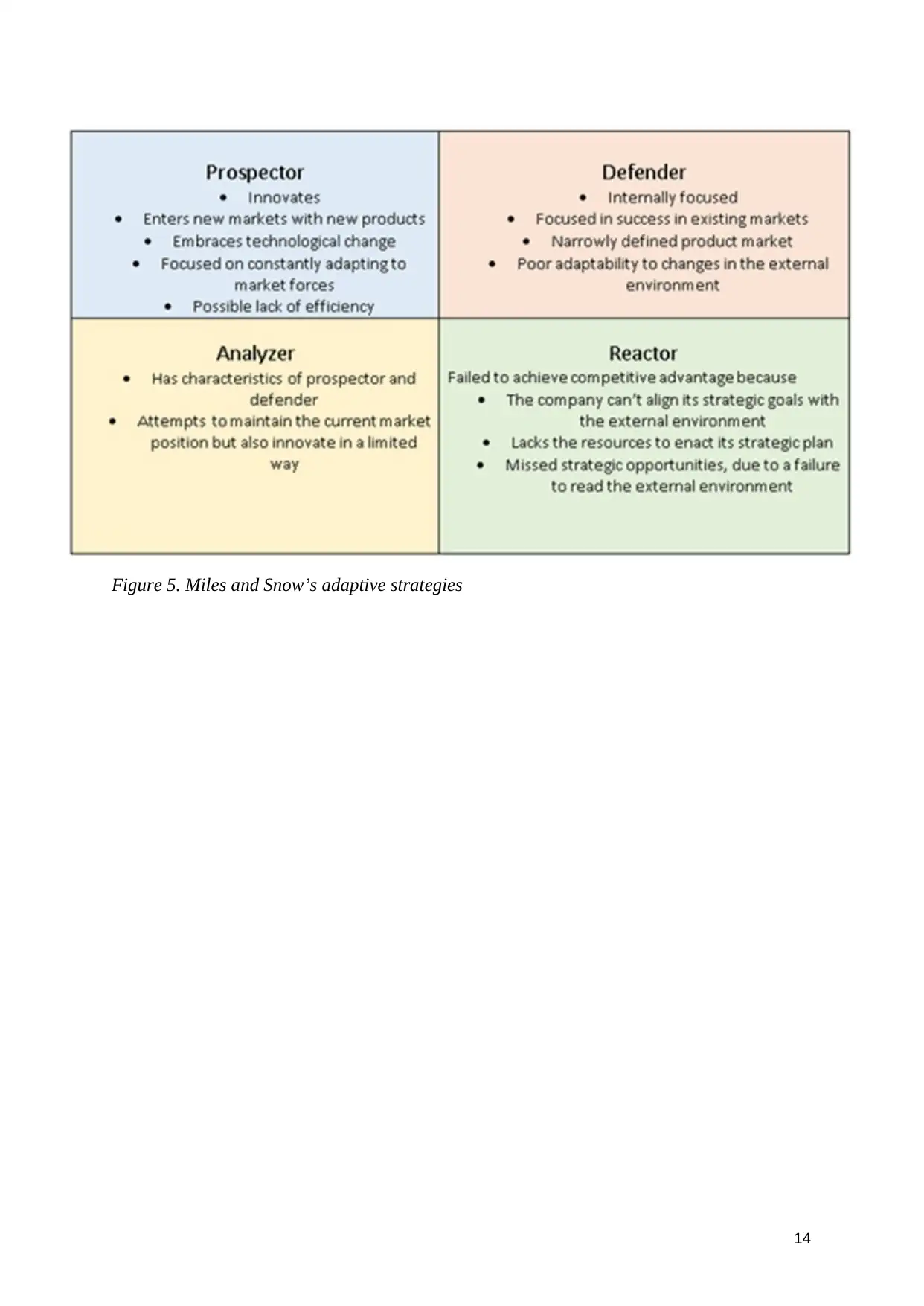
Figure 5. Miles and Snow’s adaptive strategies
14
14
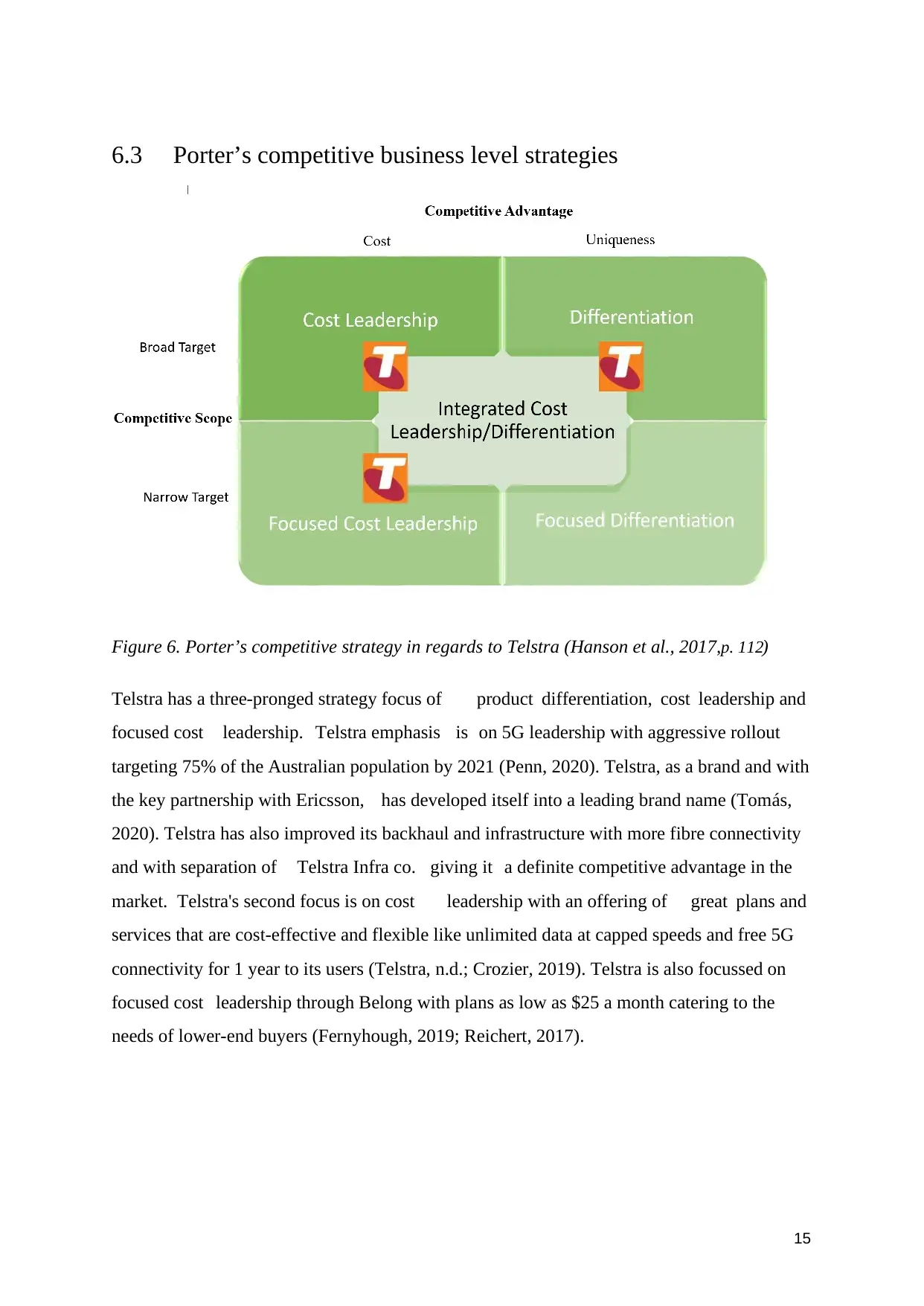
6.3 Porter’s competitive business level strategies
Figure 6. Porter’s competitive strategy in regards to Telstra (Hanson et al., 2017,p. 112)
Telstra has a three-pronged strategy focus of product differentiation, cost leadership and
focused cost leadership. Telstra emphasis is on 5G leadership with aggressive rollout
targeting 75% of the Australian population by 2021 (Penn, 2020). Telstra, as a brand and with
the key partnership with Ericsson, has developed itself into a leading brand name (Tomás,
2020). Telstra has also improved its backhaul and infrastructure with more fibre connectivity
and with separation of Telstra Infra co. giving it a definite competitive advantage in the
market. Telstra's second focus is on cost leadership with an offering of great plans and
services that are cost-effective and flexible like unlimited data at capped speeds and free 5G
connectivity for 1 year to its users (Telstra, n.d.; Crozier, 2019). Telstra is also focussed on
focused cost leadership through Belong with plans as low as $25 a month catering to the
needs of lower-end buyers (Fernyhough, 2019; Reichert, 2017).
15
Figure 6. Porter’s competitive strategy in regards to Telstra (Hanson et al., 2017,p. 112)
Telstra has a three-pronged strategy focus of product differentiation, cost leadership and
focused cost leadership. Telstra emphasis is on 5G leadership with aggressive rollout
targeting 75% of the Australian population by 2021 (Penn, 2020). Telstra, as a brand and with
the key partnership with Ericsson, has developed itself into a leading brand name (Tomás,
2020). Telstra has also improved its backhaul and infrastructure with more fibre connectivity
and with separation of Telstra Infra co. giving it a definite competitive advantage in the
market. Telstra's second focus is on cost leadership with an offering of great plans and
services that are cost-effective and flexible like unlimited data at capped speeds and free 5G
connectivity for 1 year to its users (Telstra, n.d.; Crozier, 2019). Telstra is also focussed on
focused cost leadership through Belong with plans as low as $25 a month catering to the
needs of lower-end buyers (Fernyhough, 2019; Reichert, 2017).
15
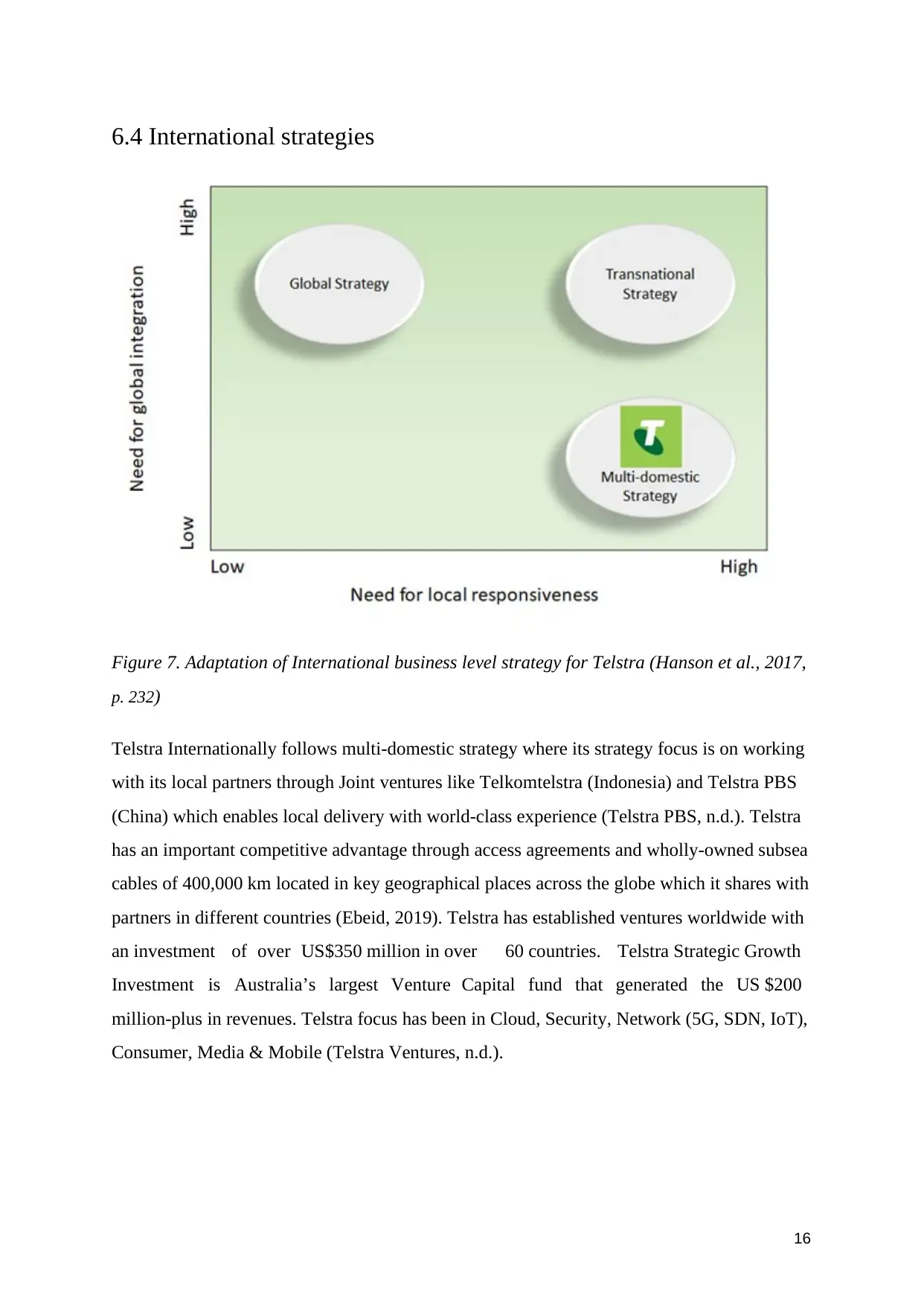
6.4 International strategies
Figure 7. Adaptation of International business level strategy for Telstra (Hanson et al., 2017,
p. 232)
Telstra Internationally follows multi-domestic strategy where its strategy focus is on working
with its local partners through Joint ventures like Telkomtelstra (Indonesia) and Telstra PBS
(China) which enables local delivery with world-class experience (Telstra PBS, n.d.). Telstra
has an important competitive advantage through access agreements and wholly-owned subsea
cables of 400,000 km located in key geographical places across the globe which it shares with
partners in different countries (Ebeid, 2019). Telstra has established ventures worldwide with
an investment of over US$350 million in over 60 countries. Telstra Strategic Growth
Investment is Australia’s largest Venture Capital fund that generated the US $200
million-plus in revenues. Telstra focus has been in Cloud, Security, Network (5G, SDN, IoT),
Consumer, Media & Mobile (Telstra Ventures, n.d.).
16
Figure 7. Adaptation of International business level strategy for Telstra (Hanson et al., 2017,
p. 232)
Telstra Internationally follows multi-domestic strategy where its strategy focus is on working
with its local partners through Joint ventures like Telkomtelstra (Indonesia) and Telstra PBS
(China) which enables local delivery with world-class experience (Telstra PBS, n.d.). Telstra
has an important competitive advantage through access agreements and wholly-owned subsea
cables of 400,000 km located in key geographical places across the globe which it shares with
partners in different countries (Ebeid, 2019). Telstra has established ventures worldwide with
an investment of over US$350 million in over 60 countries. Telstra Strategic Growth
Investment is Australia’s largest Venture Capital fund that generated the US $200
million-plus in revenues. Telstra focus has been in Cloud, Security, Network (5G, SDN, IoT),
Consumer, Media & Mobile (Telstra Ventures, n.d.).
16
Secure Best Marks with AI Grader
Need help grading? Try our AI Grader for instant feedback on your assignments.
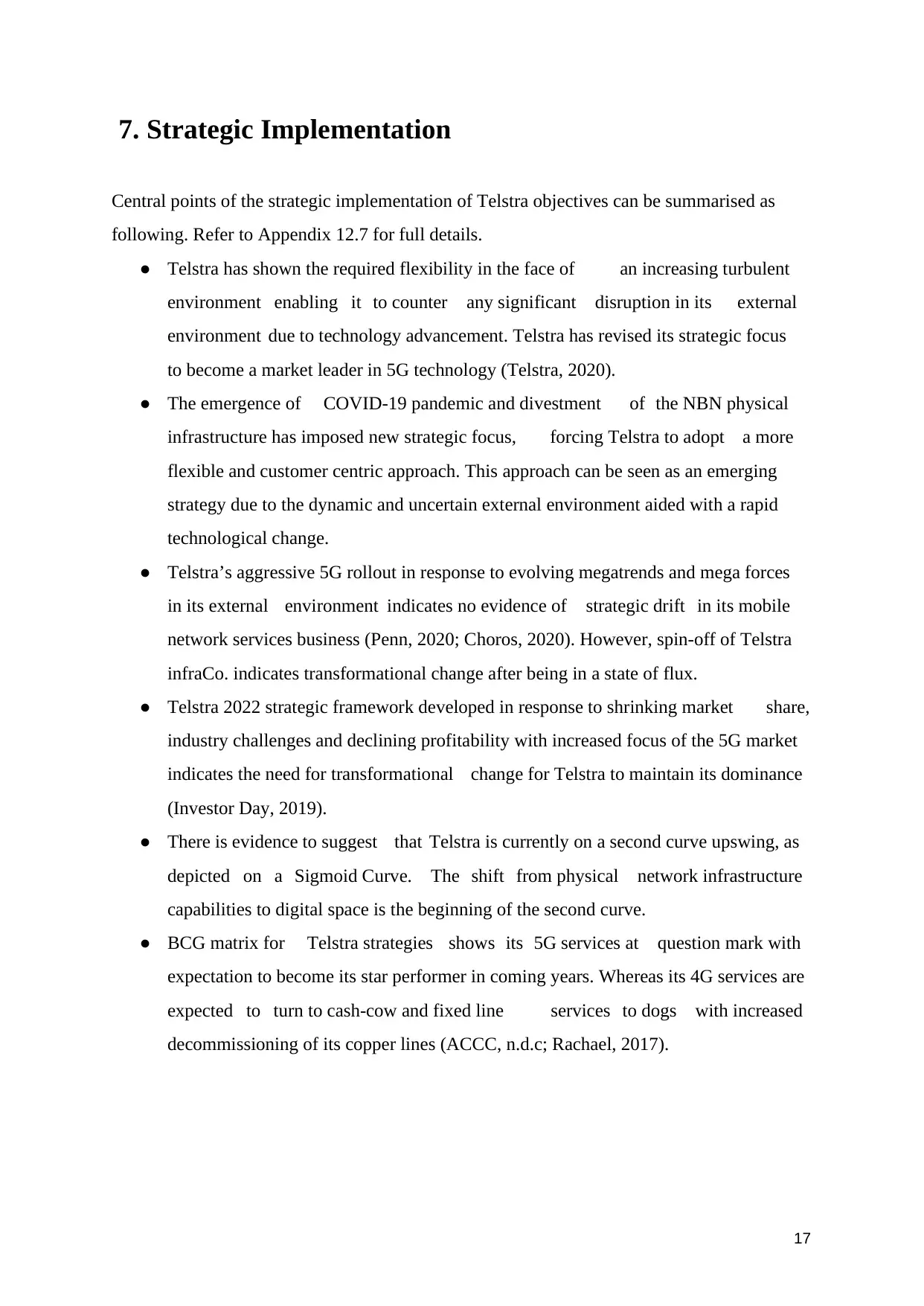
7. Strategic Implementation
Central points of the strategic implementation of Telstra objectives can be summarised as
following. Refer to Appendix 12.7 for full details.
● Telstra has shown the required flexibility in the face of an increasing turbulent
environment enabling it to counter any significant disruption in its external
environment due to technology advancement. Telstra has revised its strategic focus
to become a market leader in 5G technology (Telstra, 2020).
● The emergence of COVID-19 pandemic and divestment of the NBN physical
infrastructure has imposed new strategic focus, forcing Telstra to adopt a more
flexible and customer centric approach. This approach can be seen as an emerging
strategy due to the dynamic and uncertain external environment aided with a rapid
technological change.
● Telstra’s aggressive 5G rollout in response to evolving megatrends and mega forces
in its external environment indicates no evidence of strategic drift in its mobile
network services business (Penn, 2020; Choros, 2020). However, spin-off of Telstra
infraCo. indicates transformational change after being in a state of flux.
● Telstra 2022 strategic framework developed in response to shrinking market share,
industry challenges and declining profitability with increased focus of the 5G market
indicates the need for transformational change for Telstra to maintain its dominance
(Investor Day, 2019).
● There is evidence to suggest that Telstra is currently on a second curve upswing, as
depicted on a Sigmoid Curve. The shift from physical network infrastructure
capabilities to digital space is the beginning of the second curve.
● BCG matrix for Telstra strategies shows its 5G services at question mark with
expectation to become its star performer in coming years. Whereas its 4G services are
expected to turn to cash-cow and fixed line services to dogs with increased
decommissioning of its copper lines (ACCC, n.d.c; Rachael, 2017).
17
Central points of the strategic implementation of Telstra objectives can be summarised as
following. Refer to Appendix 12.7 for full details.
● Telstra has shown the required flexibility in the face of an increasing turbulent
environment enabling it to counter any significant disruption in its external
environment due to technology advancement. Telstra has revised its strategic focus
to become a market leader in 5G technology (Telstra, 2020).
● The emergence of COVID-19 pandemic and divestment of the NBN physical
infrastructure has imposed new strategic focus, forcing Telstra to adopt a more
flexible and customer centric approach. This approach can be seen as an emerging
strategy due to the dynamic and uncertain external environment aided with a rapid
technological change.
● Telstra’s aggressive 5G rollout in response to evolving megatrends and mega forces
in its external environment indicates no evidence of strategic drift in its mobile
network services business (Penn, 2020; Choros, 2020). However, spin-off of Telstra
infraCo. indicates transformational change after being in a state of flux.
● Telstra 2022 strategic framework developed in response to shrinking market share,
industry challenges and declining profitability with increased focus of the 5G market
indicates the need for transformational change for Telstra to maintain its dominance
(Investor Day, 2019).
● There is evidence to suggest that Telstra is currently on a second curve upswing, as
depicted on a Sigmoid Curve. The shift from physical network infrastructure
capabilities to digital space is the beginning of the second curve.
● BCG matrix for Telstra strategies shows its 5G services at question mark with
expectation to become its star performer in coming years. Whereas its 4G services are
expected to turn to cash-cow and fixed line services to dogs with increased
decommissioning of its copper lines (ACCC, n.d.c; Rachael, 2017).
17
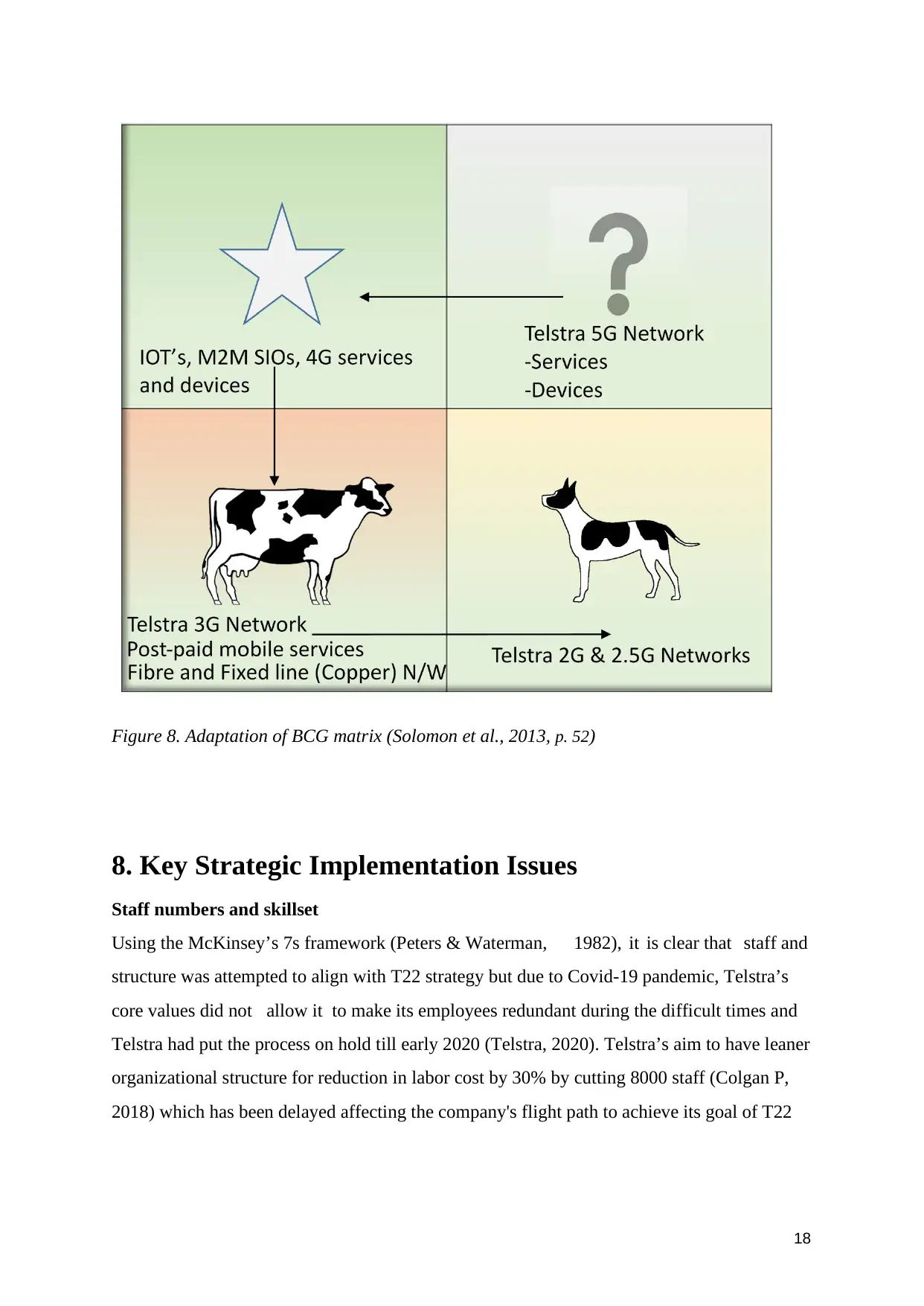
Figure 8. Adaptation of BCG matrix (Solomon et al., 2013, p. 52)
8. Key Strategic Implementation Issues
Staff numbers and skillset
Using the McKinsey’s 7s framework (Peters & Waterman, 1982), it is clear that staff and
structure was attempted to align with T22 strategy but due to Covid-19 pandemic, Telstra’s
core values did not allow it to make its employees redundant during the difficult times and
Telstra had put the process on hold till early 2020 (Telstra, 2020). Telstra’s aim to have leaner
organizational structure for reduction in labor cost by 30% by cutting 8000 staff (Colgan P,
2018) which has been delayed affecting the company's flight path to achieve its goal of T22
18
8. Key Strategic Implementation Issues
Staff numbers and skillset
Using the McKinsey’s 7s framework (Peters & Waterman, 1982), it is clear that staff and
structure was attempted to align with T22 strategy but due to Covid-19 pandemic, Telstra’s
core values did not allow it to make its employees redundant during the difficult times and
Telstra had put the process on hold till early 2020 (Telstra, 2020). Telstra’s aim to have leaner
organizational structure for reduction in labor cost by 30% by cutting 8000 staff (Colgan P,
2018) which has been delayed affecting the company's flight path to achieve its goal of T22
18
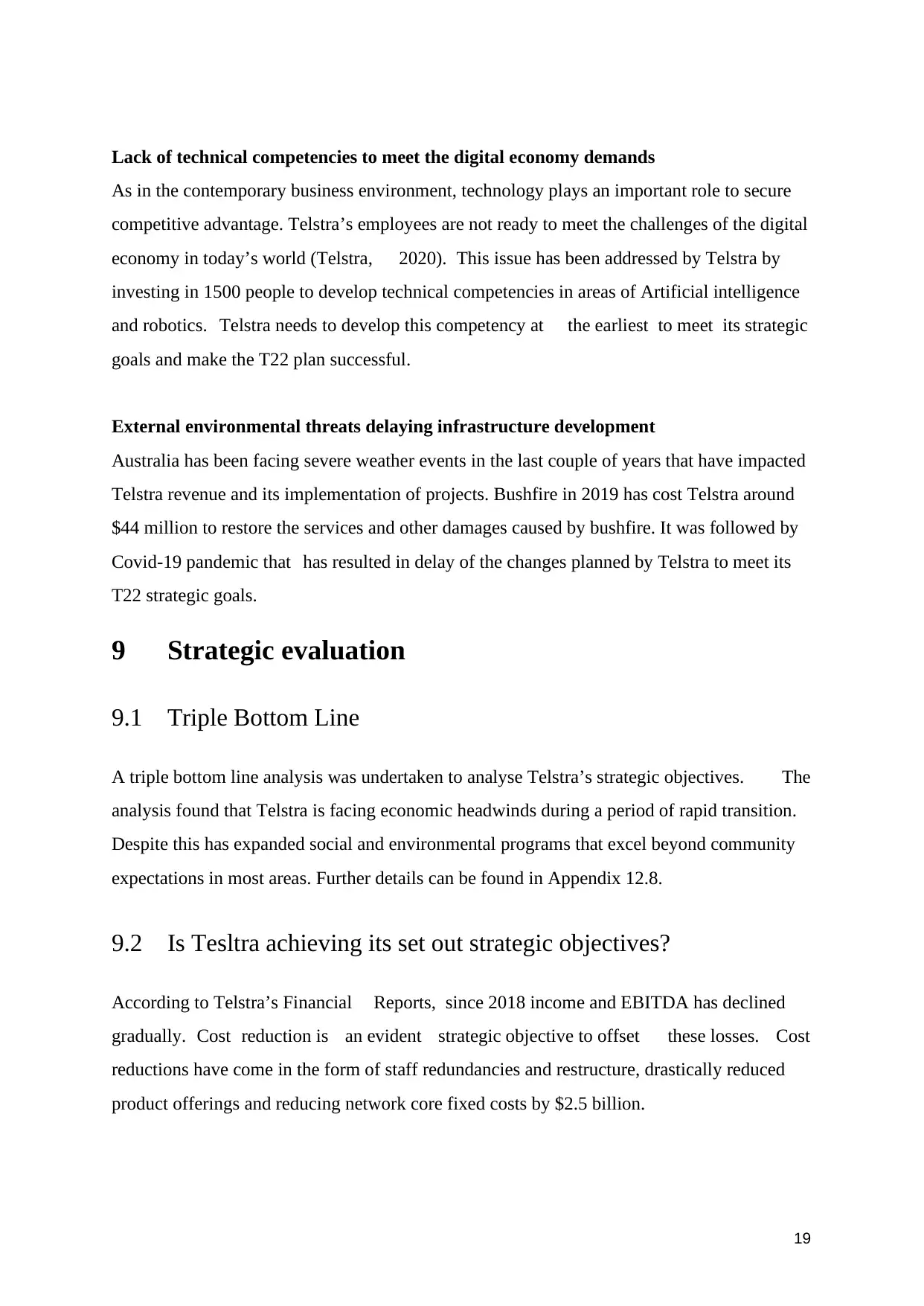
Lack of technical competencies to meet the digital economy demands
As in the contemporary business environment, technology plays an important role to secure
competitive advantage. Telstra’s employees are not ready to meet the challenges of the digital
economy in today’s world (Telstra, 2020). This issue has been addressed by Telstra by
investing in 1500 people to develop technical competencies in areas of Artificial intelligence
and robotics. Telstra needs to develop this competency at the earliest to meet its strategic
goals and make the T22 plan successful.
External environmental threats delaying infrastructure development
Australia has been facing severe weather events in the last couple of years that have impacted
Telstra revenue and its implementation of projects. Bushfire in 2019 has cost Telstra around
$44 million to restore the services and other damages caused by bushfire. It was followed by
Covid-19 pandemic that has resulted in delay of the changes planned by Telstra to meet its
T22 strategic goals.
9 Strategic evaluation
9.1 Triple Bottom Line
A triple bottom line analysis was undertaken to analyse Telstra’s strategic objectives. The
analysis found that Telstra is facing economic headwinds during a period of rapid transition.
Despite this has expanded social and environmental programs that excel beyond community
expectations in most areas. Further details can be found in Appendix 12.8.
9.2 Is Tesltra achieving its set out strategic objectives?
According to Telstra’s Financial Reports, since 2018 income and EBITDA has declined
gradually. Cost reduction is an evident strategic objective to offset these losses. Cost
reductions have come in the form of staff redundancies and restructure, drastically reduced
product offerings and reducing network core fixed costs by $2.5 billion.
19
As in the contemporary business environment, technology plays an important role to secure
competitive advantage. Telstra’s employees are not ready to meet the challenges of the digital
economy in today’s world (Telstra, 2020). This issue has been addressed by Telstra by
investing in 1500 people to develop technical competencies in areas of Artificial intelligence
and robotics. Telstra needs to develop this competency at the earliest to meet its strategic
goals and make the T22 plan successful.
External environmental threats delaying infrastructure development
Australia has been facing severe weather events in the last couple of years that have impacted
Telstra revenue and its implementation of projects. Bushfire in 2019 has cost Telstra around
$44 million to restore the services and other damages caused by bushfire. It was followed by
Covid-19 pandemic that has resulted in delay of the changes planned by Telstra to meet its
T22 strategic goals.
9 Strategic evaluation
9.1 Triple Bottom Line
A triple bottom line analysis was undertaken to analyse Telstra’s strategic objectives. The
analysis found that Telstra is facing economic headwinds during a period of rapid transition.
Despite this has expanded social and environmental programs that excel beyond community
expectations in most areas. Further details can be found in Appendix 12.8.
9.2 Is Tesltra achieving its set out strategic objectives?
According to Telstra’s Financial Reports, since 2018 income and EBITDA has declined
gradually. Cost reduction is an evident strategic objective to offset these losses. Cost
reductions have come in the form of staff redundancies and restructure, drastically reduced
product offerings and reducing network core fixed costs by $2.5 billion.
19
Paraphrase This Document
Need a fresh take? Get an instant paraphrase of this document with our AI Paraphraser
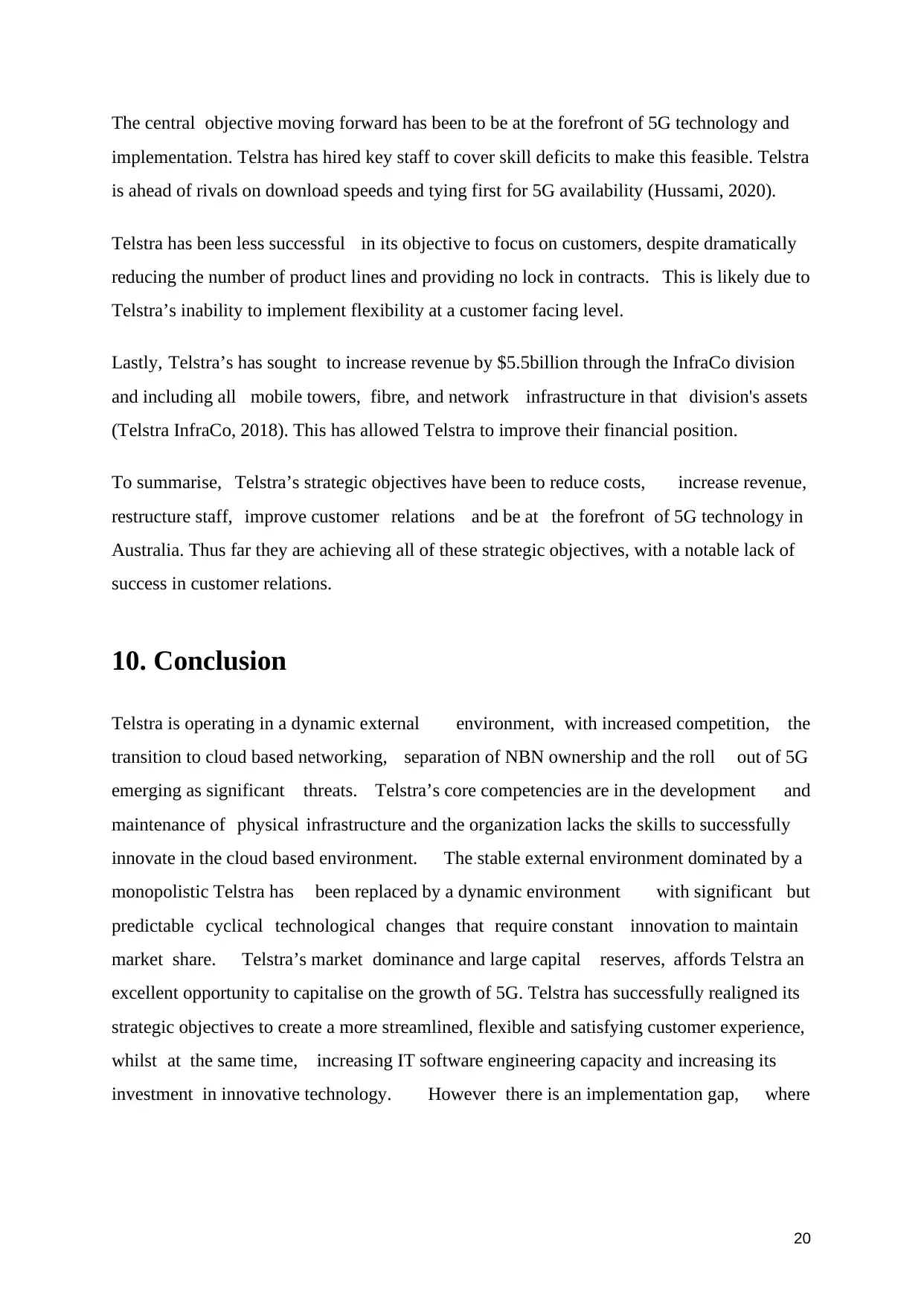
The central objective moving forward has been to be at the forefront of 5G technology and
implementation. Telstra has hired key staff to cover skill deficits to make this feasible. Telstra
is ahead of rivals on download speeds and tying first for 5G availability (Hussami, 2020).
Telstra has been less successful in its objective to focus on customers, despite dramatically
reducing the number of product lines and providing no lock in contracts. This is likely due to
Telstra’s inability to implement flexibility at a customer facing level.
Lastly, Telstra’s has sought to increase revenue by $5.5billion through the InfraCo division
and including all mobile towers, fibre, and network infrastructure in that division's assets
(Telstra InfraCo, 2018). This has allowed Telstra to improve their financial position.
To summarise, Telstra’s strategic objectives have been to reduce costs, increase revenue,
restructure staff, improve customer relations and be at the forefront of 5G technology in
Australia. Thus far they are achieving all of these strategic objectives, with a notable lack of
success in customer relations.
10. Conclusion
Telstra is operating in a dynamic external environment, with increased competition, the
transition to cloud based networking, separation of NBN ownership and the roll out of 5G
emerging as significant threats. Telstra’s core competencies are in the development and
maintenance of physical infrastructure and the organization lacks the skills to successfully
innovate in the cloud based environment. The stable external environment dominated by a
monopolistic Telstra has been replaced by a dynamic environment with significant but
predictable cyclical technological changes that require constant innovation to maintain
market share. Telstra’s market dominance and large capital reserves, affords Telstra an
excellent opportunity to capitalise on the growth of 5G. Telstra has successfully realigned its
strategic objectives to create a more streamlined, flexible and satisfying customer experience,
whilst at the same time, increasing IT software engineering capacity and increasing its
investment in innovative technology. However there is an implementation gap, where
20
implementation. Telstra has hired key staff to cover skill deficits to make this feasible. Telstra
is ahead of rivals on download speeds and tying first for 5G availability (Hussami, 2020).
Telstra has been less successful in its objective to focus on customers, despite dramatically
reducing the number of product lines and providing no lock in contracts. This is likely due to
Telstra’s inability to implement flexibility at a customer facing level.
Lastly, Telstra’s has sought to increase revenue by $5.5billion through the InfraCo division
and including all mobile towers, fibre, and network infrastructure in that division's assets
(Telstra InfraCo, 2018). This has allowed Telstra to improve their financial position.
To summarise, Telstra’s strategic objectives have been to reduce costs, increase revenue,
restructure staff, improve customer relations and be at the forefront of 5G technology in
Australia. Thus far they are achieving all of these strategic objectives, with a notable lack of
success in customer relations.
10. Conclusion
Telstra is operating in a dynamic external environment, with increased competition, the
transition to cloud based networking, separation of NBN ownership and the roll out of 5G
emerging as significant threats. Telstra’s core competencies are in the development and
maintenance of physical infrastructure and the organization lacks the skills to successfully
innovate in the cloud based environment. The stable external environment dominated by a
monopolistic Telstra has been replaced by a dynamic environment with significant but
predictable cyclical technological changes that require constant innovation to maintain
market share. Telstra’s market dominance and large capital reserves, affords Telstra an
excellent opportunity to capitalise on the growth of 5G. Telstra has successfully realigned its
strategic objectives to create a more streamlined, flexible and satisfying customer experience,
whilst at the same time, increasing IT software engineering capacity and increasing its
investment in innovative technology. However there is an implementation gap, where
20
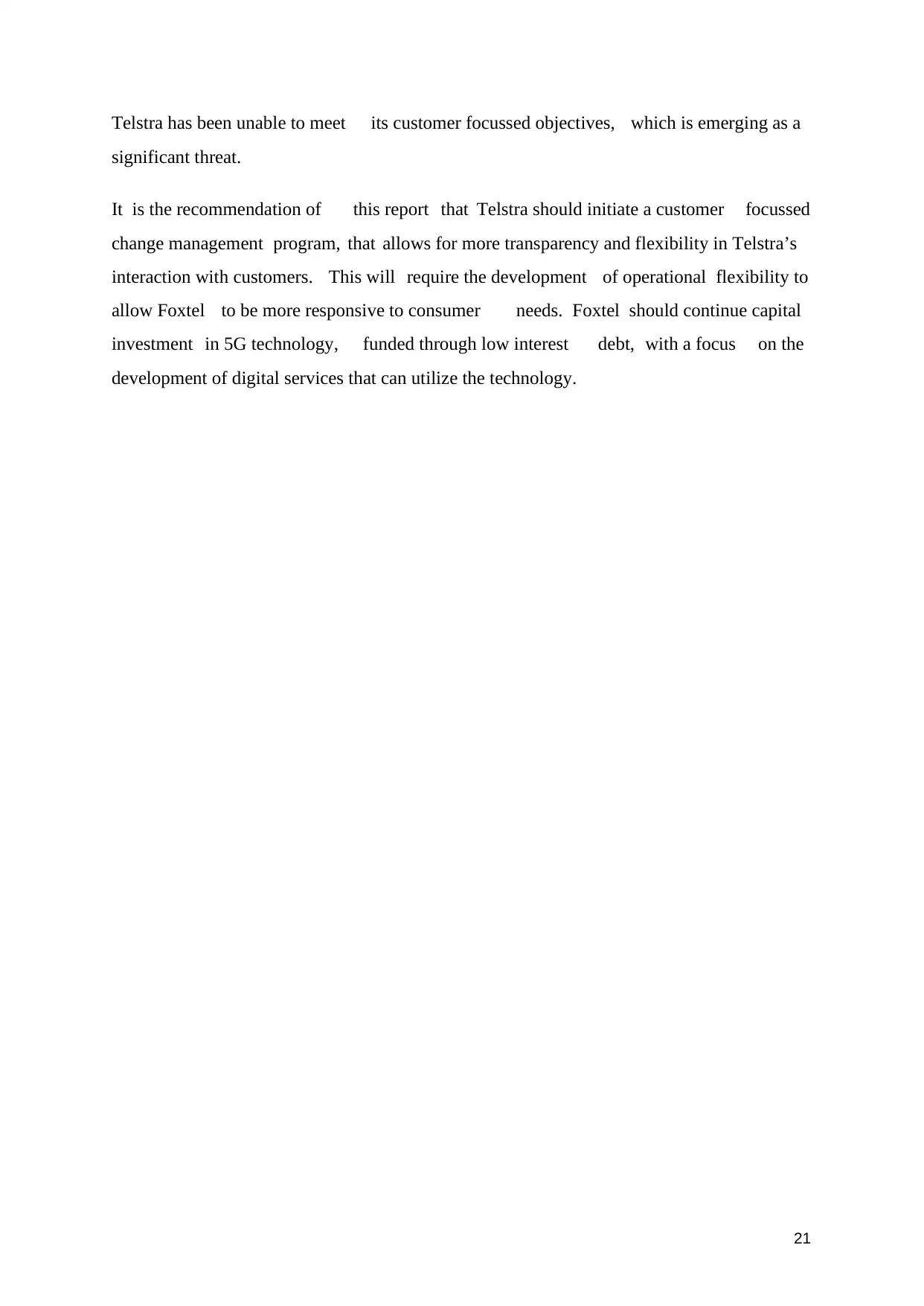
Telstra has been unable to meet its customer focussed objectives, which is emerging as a
significant threat.
It is the recommendation of this report that Telstra should initiate a customer focussed
change management program, that allows for more transparency and flexibility in Telstra’s
interaction with customers. This will require the development of operational flexibility to
allow Foxtel to be more responsive to consumer needs. Foxtel should continue capital
investment in 5G technology, funded through low interest debt, with a focus on the
development of digital services that can utilize the technology.
21
significant threat.
It is the recommendation of this report that Telstra should initiate a customer focussed
change management program, that allows for more transparency and flexibility in Telstra’s
interaction with customers. This will require the development of operational flexibility to
allow Foxtel to be more responsive to consumer needs. Foxtel should continue capital
investment in 5G technology, funded through low interest debt, with a focus on the
development of digital services that can utilize the technology.
21
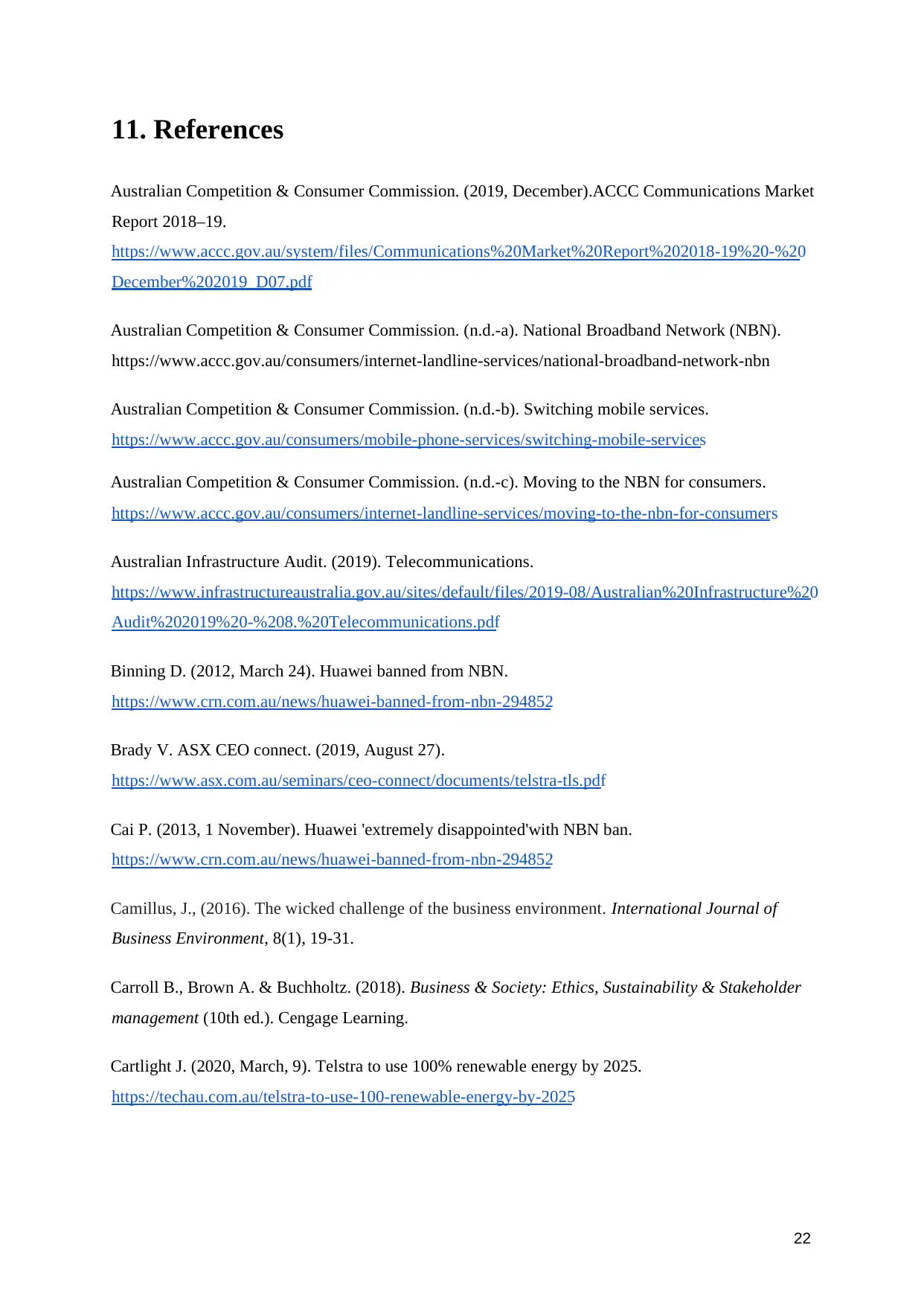
11. References
Australian Competition & Consumer Commission. (2019, December).ACCC Communications Market
Report 2018–19.
https://www.accc.gov.au/system/files/Communications%20Market%20Report%202018-19%20-%20
December%202019_D07.pdf
Australian Competition & Consumer Commission. (n.d.-a). National Broadband Network (NBN).
https://www.accc.gov.au/consumers/internet-landline-services/national-broadband-network-nbn
Australian Competition & Consumer Commission. (n.d.-b). Switching mobile services.
https://www.accc.gov.au/consumers/mobile-phone-services/switching-mobile-services
Australian Competition & Consumer Commission. (n.d.-c). Moving to the NBN for consumers.
https://www.accc.gov.au/consumers/internet-landline-services/moving-to-the-nbn-for-consumers
Australian Infrastructure Audit. (2019). Telecommunications.
https://www.infrastructureaustralia.gov.au/sites/default/files/2019-08/Australian%20Infrastructure%20
Audit%202019%20-%208.%20Telecommunications.pdf
Binning D. (2012, March 24). Huawei banned from NBN.
https://www.crn.com.au/news/huawei-banned-from-nbn-294852
Brady V. ASX CEO connect. (2019, August 27).
https://www.asx.com.au/seminars/ceo-connect/documents/telstra-tls.pdf
Cai P. (2013, 1 November). Huawei 'extremely disappointed'with NBN ban.
https://www.crn.com.au/news/huawei-banned-from-nbn-294852
Camillus, J., (2016). The wicked challenge of the business environment. International Journal of
Business Environment, 8(1), 19-31.
Carroll B., Brown A. & Buchholtz. (2018). Business & Society: Ethics, Sustainability & Stakeholder
management (10th ed.). Cengage Learning.
Cartlight J. (2020, March, 9). Telstra to use 100% renewable energy by 2025.
https://techau.com.au/telstra-to-use-100-renewable-energy-by-2025
22
Australian Competition & Consumer Commission. (2019, December).ACCC Communications Market
Report 2018–19.
https://www.accc.gov.au/system/files/Communications%20Market%20Report%202018-19%20-%20
December%202019_D07.pdf
Australian Competition & Consumer Commission. (n.d.-a). National Broadband Network (NBN).
https://www.accc.gov.au/consumers/internet-landline-services/national-broadband-network-nbn
Australian Competition & Consumer Commission. (n.d.-b). Switching mobile services.
https://www.accc.gov.au/consumers/mobile-phone-services/switching-mobile-services
Australian Competition & Consumer Commission. (n.d.-c). Moving to the NBN for consumers.
https://www.accc.gov.au/consumers/internet-landline-services/moving-to-the-nbn-for-consumers
Australian Infrastructure Audit. (2019). Telecommunications.
https://www.infrastructureaustralia.gov.au/sites/default/files/2019-08/Australian%20Infrastructure%20
Audit%202019%20-%208.%20Telecommunications.pdf
Binning D. (2012, March 24). Huawei banned from NBN.
https://www.crn.com.au/news/huawei-banned-from-nbn-294852
Brady V. ASX CEO connect. (2019, August 27).
https://www.asx.com.au/seminars/ceo-connect/documents/telstra-tls.pdf
Cai P. (2013, 1 November). Huawei 'extremely disappointed'with NBN ban.
https://www.crn.com.au/news/huawei-banned-from-nbn-294852
Camillus, J., (2016). The wicked challenge of the business environment. International Journal of
Business Environment, 8(1), 19-31.
Carroll B., Brown A. & Buchholtz. (2018). Business & Society: Ethics, Sustainability & Stakeholder
management (10th ed.). Cengage Learning.
Cartlight J. (2020, March, 9). Telstra to use 100% renewable energy by 2025.
https://techau.com.au/telstra-to-use-100-renewable-energy-by-2025
22
Secure Best Marks with AI Grader
Need help grading? Try our AI Grader for instant feedback on your assignments.
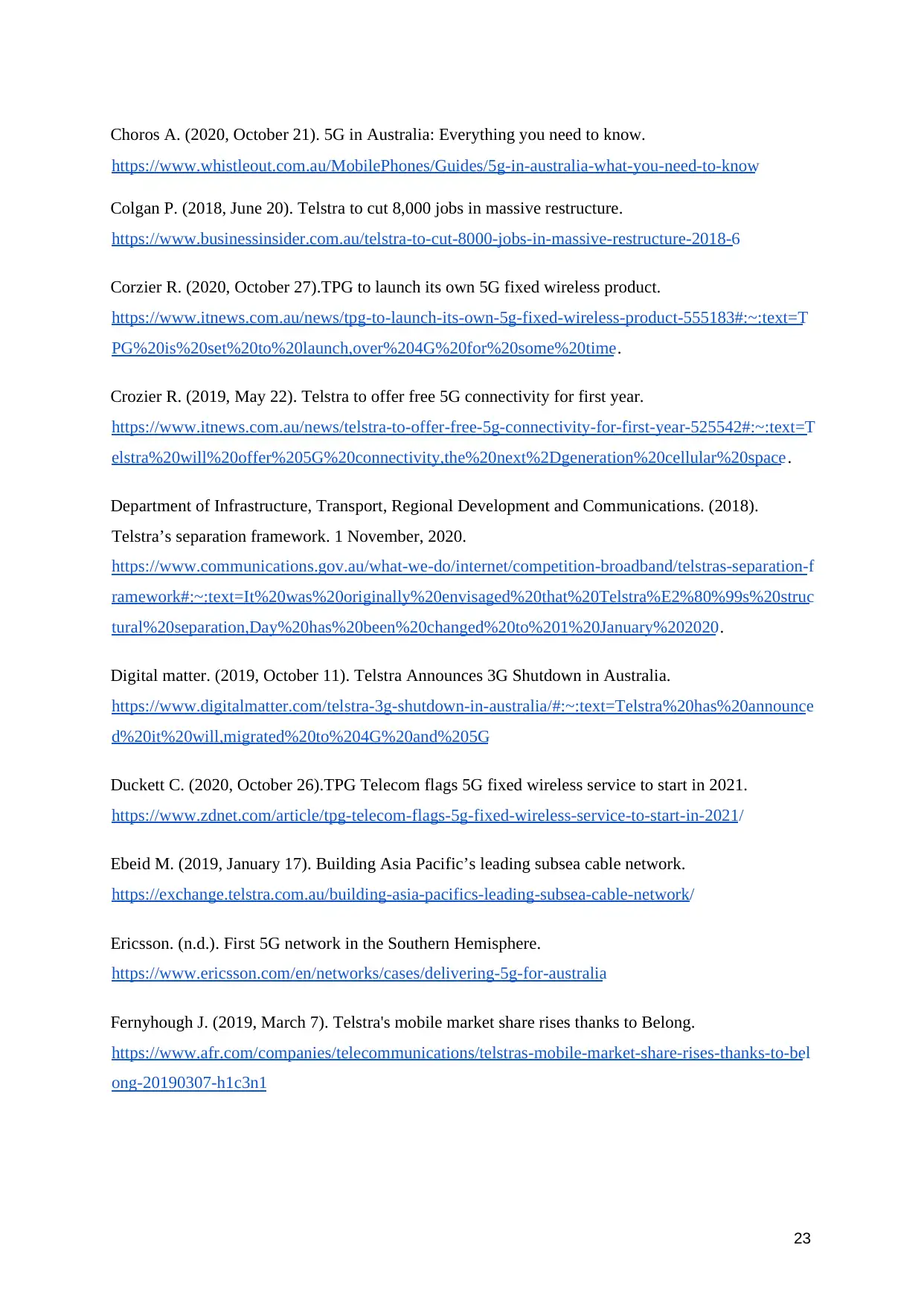
Choros A. (2020, October 21). 5G in Australia: Everything you need to know.
https://www.whistleout.com.au/MobilePhones/Guides/5g-in-australia-what-you-need-to-know
Colgan P. (2018, June 20). Telstra to cut 8,000 jobs in massive restructure.
https://www.businessinsider.com.au/telstra-to-cut-8000-jobs-in-massive-restructure-2018-6
Corzier R. (2020, October 27).TPG to launch its own 5G fixed wireless product.
https://www.itnews.com.au/news/tpg-to-launch-its-own-5g-fixed-wireless-product-555183#:~:text=T
PG%20is%20set%20to%20launch,over%204G%20for%20some%20time.
Crozier R. (2019, May 22). Telstra to offer free 5G connectivity for first year.
https://www.itnews.com.au/news/telstra-to-offer-free-5g-connectivity-for-first-year-525542#:~:text=T
elstra%20will%20offer%205G%20connectivity,the%20next%2Dgeneration%20cellular%20space.
Department of Infrastructure, Transport, Regional Development and Communications. (2018).
Telstra’s separation framework. 1 November, 2020.
https://www.communications.gov.au/what-we-do/internet/competition-broadband/telstras-separation-f
ramework#:~:text=It%20was%20originally%20envisaged%20that%20Telstra%E2%80%99s%20struc
tural%20separation,Day%20has%20been%20changed%20to%201%20January%202020.
Digital matter. (2019, October 11). Telstra Announces 3G Shutdown in Australia.
https://www.digitalmatter.com/telstra-3g-shutdown-in-australia/#:~:text=Telstra%20has%20announce
d%20it%20will,migrated%20to%204G%20and%205G
Duckett C. (2020, October 26).TPG Telecom flags 5G fixed wireless service to start in 2021.
https://www.zdnet.com/article/tpg-telecom-flags-5g-fixed-wireless-service-to-start-in-2021/
Ebeid M. (2019, January 17). Building Asia Pacific’s leading subsea cable network.
https://exchange.telstra.com.au/building-asia-pacifics-leading-subsea-cable-network/
Ericsson. (n.d.). First 5G network in the Southern Hemisphere.
https://www.ericsson.com/en/networks/cases/delivering-5g-for-australia
Fernyhough J. (2019, March 7). Telstra's mobile market share rises thanks to Belong.
https://www.afr.com/companies/telecommunications/telstras-mobile-market-share-rises-thanks-to-bel
ong-20190307-h1c3n1
23
https://www.whistleout.com.au/MobilePhones/Guides/5g-in-australia-what-you-need-to-know
Colgan P. (2018, June 20). Telstra to cut 8,000 jobs in massive restructure.
https://www.businessinsider.com.au/telstra-to-cut-8000-jobs-in-massive-restructure-2018-6
Corzier R. (2020, October 27).TPG to launch its own 5G fixed wireless product.
https://www.itnews.com.au/news/tpg-to-launch-its-own-5g-fixed-wireless-product-555183#:~:text=T
PG%20is%20set%20to%20launch,over%204G%20for%20some%20time.
Crozier R. (2019, May 22). Telstra to offer free 5G connectivity for first year.
https://www.itnews.com.au/news/telstra-to-offer-free-5g-connectivity-for-first-year-525542#:~:text=T
elstra%20will%20offer%205G%20connectivity,the%20next%2Dgeneration%20cellular%20space.
Department of Infrastructure, Transport, Regional Development and Communications. (2018).
Telstra’s separation framework. 1 November, 2020.
https://www.communications.gov.au/what-we-do/internet/competition-broadband/telstras-separation-f
ramework#:~:text=It%20was%20originally%20envisaged%20that%20Telstra%E2%80%99s%20struc
tural%20separation,Day%20has%20been%20changed%20to%201%20January%202020.
Digital matter. (2019, October 11). Telstra Announces 3G Shutdown in Australia.
https://www.digitalmatter.com/telstra-3g-shutdown-in-australia/#:~:text=Telstra%20has%20announce
d%20it%20will,migrated%20to%204G%20and%205G
Duckett C. (2020, October 26).TPG Telecom flags 5G fixed wireless service to start in 2021.
https://www.zdnet.com/article/tpg-telecom-flags-5g-fixed-wireless-service-to-start-in-2021/
Ebeid M. (2019, January 17). Building Asia Pacific’s leading subsea cable network.
https://exchange.telstra.com.au/building-asia-pacifics-leading-subsea-cable-network/
Ericsson. (n.d.). First 5G network in the Southern Hemisphere.
https://www.ericsson.com/en/networks/cases/delivering-5g-for-australia
Fernyhough J. (2019, March 7). Telstra's mobile market share rises thanks to Belong.
https://www.afr.com/companies/telecommunications/telstras-mobile-market-share-rises-thanks-to-bel
ong-20190307-h1c3n1
23
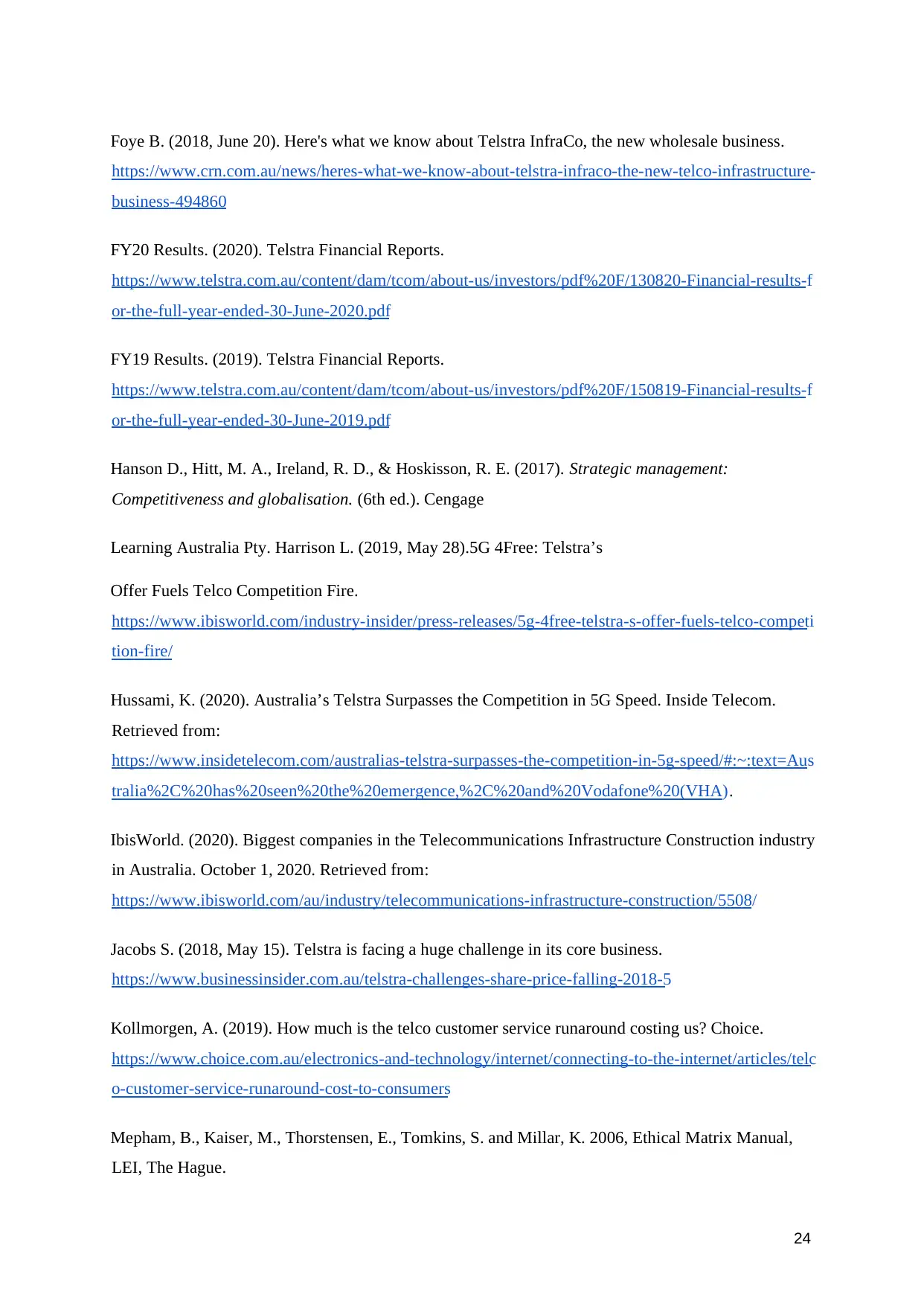
Foye B. (2018, June 20). Here's what we know about Telstra InfraCo, the new wholesale business.
https://www.crn.com.au/news/heres-what-we-know-about-telstra-infraco-the-new-telco-infrastructure-
business-494860
FY20 Results. (2020). Telstra Financial Reports.
https://www.telstra.com.au/content/dam/tcom/about-us/investors/pdf%20F/130820-Financial-results-f
or-the-full-year-ended-30-June-2020.pdf
FY19 Results. (2019). Telstra Financial Reports.
https://www.telstra.com.au/content/dam/tcom/about-us/investors/pdf%20F/150819-Financial-results-f
or-the-full-year-ended-30-June-2019.pdf
Hanson D., Hitt, M. A., Ireland, R. D., & Hoskisson, R. E. (2017). Strategic management:
Competitiveness and globalisation. (6th ed.). Cengage
Learning Australia Pty. Harrison L. (2019, May 28).5G 4Free: Telstra’s
Offer Fuels Telco Competition Fire.
https://www.ibisworld.com/industry-insider/press-releases/5g-4free-telstra-s-offer-fuels-telco-competi
tion-fire/
Hussami, K. (2020). Australia’s Telstra Surpasses the Competition in 5G Speed. Inside Telecom.
Retrieved from:
https://www.insidetelecom.com/australias-telstra-surpasses-the-competition-in-5g-speed/#:~:text=Aus
tralia%2C%20has%20seen%20the%20emergence,%2C%20and%20Vodafone%20(VHA).
IbisWorld. (2020). Biggest companies in the Telecommunications Infrastructure Construction industry
in Australia. October 1, 2020. Retrieved from:
https://www.ibisworld.com/au/industry/telecommunications-infrastructure-construction/5508/
Jacobs S. (2018, May 15). Telstra is facing a huge challenge in its core business.
https://www.businessinsider.com.au/telstra-challenges-share-price-falling-2018-5
Kollmorgen, A. (2019). How much is the telco customer service runaround costing us? Choice.
https://www.choice.com.au/electronics-and-technology/internet/connecting-to-the-internet/articles/telc
o-customer-service-runaround-cost-to-consumers
Mepham, B., Kaiser, M., Thorstensen, E., Tomkins, S. and Millar, K. 2006, Ethical Matrix Manual,
LEI, The Hague.
24
https://www.crn.com.au/news/heres-what-we-know-about-telstra-infraco-the-new-telco-infrastructure-
business-494860
FY20 Results. (2020). Telstra Financial Reports.
https://www.telstra.com.au/content/dam/tcom/about-us/investors/pdf%20F/130820-Financial-results-f
or-the-full-year-ended-30-June-2020.pdf
FY19 Results. (2019). Telstra Financial Reports.
https://www.telstra.com.au/content/dam/tcom/about-us/investors/pdf%20F/150819-Financial-results-f
or-the-full-year-ended-30-June-2019.pdf
Hanson D., Hitt, M. A., Ireland, R. D., & Hoskisson, R. E. (2017). Strategic management:
Competitiveness and globalisation. (6th ed.). Cengage
Learning Australia Pty. Harrison L. (2019, May 28).5G 4Free: Telstra’s
Offer Fuels Telco Competition Fire.
https://www.ibisworld.com/industry-insider/press-releases/5g-4free-telstra-s-offer-fuels-telco-competi
tion-fire/
Hussami, K. (2020). Australia’s Telstra Surpasses the Competition in 5G Speed. Inside Telecom.
Retrieved from:
https://www.insidetelecom.com/australias-telstra-surpasses-the-competition-in-5g-speed/#:~:text=Aus
tralia%2C%20has%20seen%20the%20emergence,%2C%20and%20Vodafone%20(VHA).
IbisWorld. (2020). Biggest companies in the Telecommunications Infrastructure Construction industry
in Australia. October 1, 2020. Retrieved from:
https://www.ibisworld.com/au/industry/telecommunications-infrastructure-construction/5508/
Jacobs S. (2018, May 15). Telstra is facing a huge challenge in its core business.
https://www.businessinsider.com.au/telstra-challenges-share-price-falling-2018-5
Kollmorgen, A. (2019). How much is the telco customer service runaround costing us? Choice.
https://www.choice.com.au/electronics-and-technology/internet/connecting-to-the-internet/articles/telc
o-customer-service-runaround-cost-to-consumers
Mepham, B., Kaiser, M., Thorstensen, E., Tomkins, S. and Millar, K. 2006, Ethical Matrix Manual,
LEI, The Hague.
24
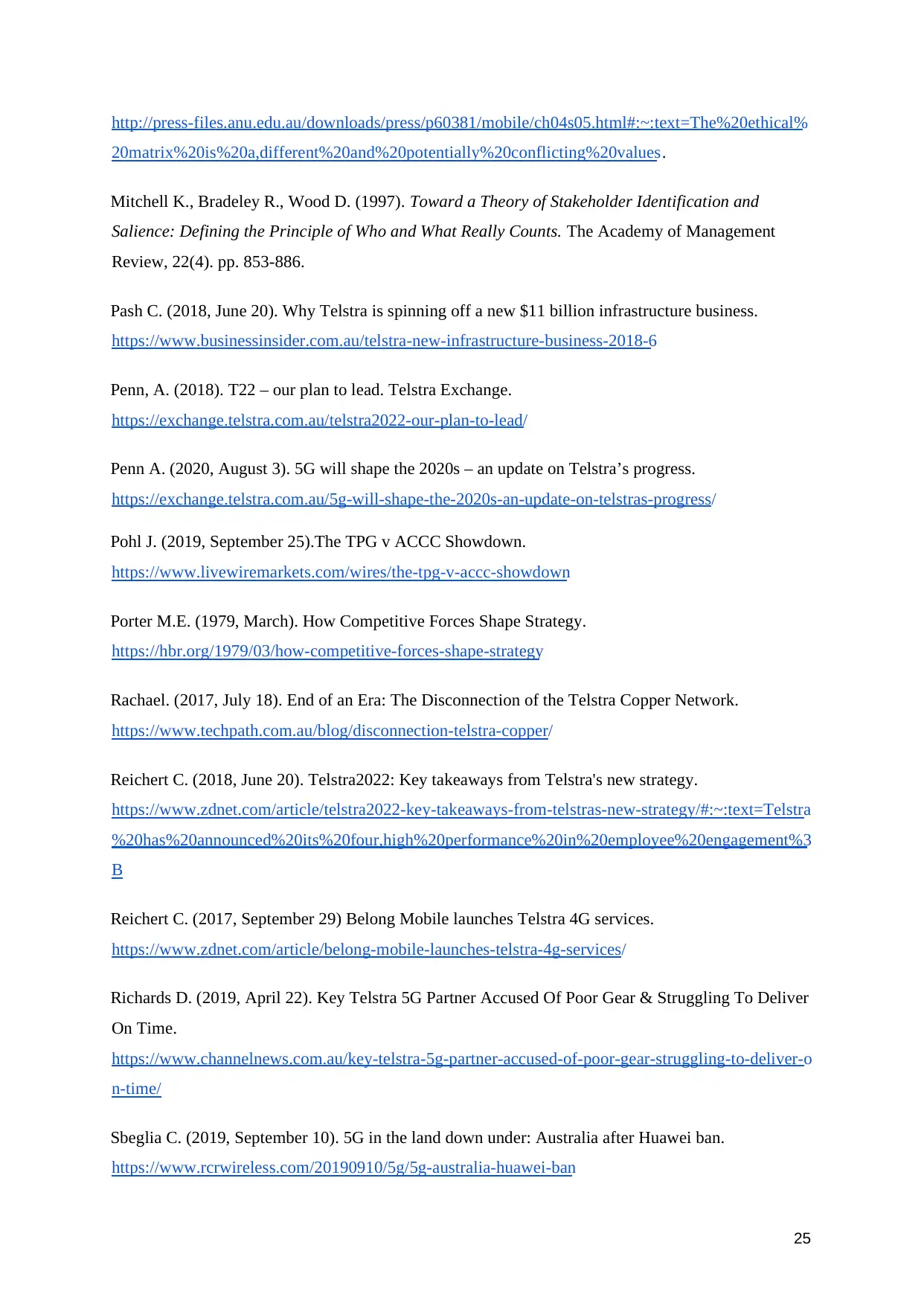
http://press-files.anu.edu.au/downloads/press/p60381/mobile/ch04s05.html#:~:text=The%20ethical%
20matrix%20is%20a,different%20and%20potentially%20conflicting%20values.
Mitchell K., Bradeley R., Wood D. (1997). Toward a Theory of Stakeholder Identification and
Salience: Defining the Principle of Who and What Really Counts. The Academy of Management
Review, 22(4). pp. 853-886.
Pash C. (2018, June 20). Why Telstra is spinning off a new $11 billion infrastructure business.
https://www.businessinsider.com.au/telstra-new-infrastructure-business-2018-6
Penn, A. (2018). T22 – our plan to lead. Telstra Exchange.
https://exchange.telstra.com.au/telstra2022-our-plan-to-lead/
Penn A. (2020, August 3). 5G will shape the 2020s – an update on Telstra’s progress.
https://exchange.telstra.com.au/5g-will-shape-the-2020s-an-update-on-telstras-progress/
Pohl J. (2019, September 25).The TPG v ACCC Showdown.
https://www.livewiremarkets.com/wires/the-tpg-v-accc-showdown
Porter M.E. (1979, March). How Competitive Forces Shape Strategy.
https://hbr.org/1979/03/how-competitive-forces-shape-strategy
Rachael. (2017, July 18). End of an Era: The Disconnection of the Telstra Copper Network.
https://www.techpath.com.au/blog/disconnection-telstra-copper/
Reichert C. (2018, June 20). Telstra2022: Key takeaways from Telstra's new strategy.
https://www.zdnet.com/article/telstra2022-key-takeaways-from-telstras-new-strategy/#:~:text=Telstra
%20has%20announced%20its%20four,high%20performance%20in%20employee%20engagement%3
B
Reichert C. (2017, September 29) Belong Mobile launches Telstra 4G services.
https://www.zdnet.com/article/belong-mobile-launches-telstra-4g-services/
Richards D. (2019, April 22). Key Telstra 5G Partner Accused Of Poor Gear & Struggling To Deliver
On Time.
https://www.channelnews.com.au/key-telstra-5g-partner-accused-of-poor-gear-struggling-to-deliver-o
n-time/
Sbeglia C. (2019, September 10). 5G in the land down under: Australia after Huawei ban.
https://www.rcrwireless.com/20190910/5g/5g-australia-huawei-ban
25
20matrix%20is%20a,different%20and%20potentially%20conflicting%20values.
Mitchell K., Bradeley R., Wood D. (1997). Toward a Theory of Stakeholder Identification and
Salience: Defining the Principle of Who and What Really Counts. The Academy of Management
Review, 22(4). pp. 853-886.
Pash C. (2018, June 20). Why Telstra is spinning off a new $11 billion infrastructure business.
https://www.businessinsider.com.au/telstra-new-infrastructure-business-2018-6
Penn, A. (2018). T22 – our plan to lead. Telstra Exchange.
https://exchange.telstra.com.au/telstra2022-our-plan-to-lead/
Penn A. (2020, August 3). 5G will shape the 2020s – an update on Telstra’s progress.
https://exchange.telstra.com.au/5g-will-shape-the-2020s-an-update-on-telstras-progress/
Pohl J. (2019, September 25).The TPG v ACCC Showdown.
https://www.livewiremarkets.com/wires/the-tpg-v-accc-showdown
Porter M.E. (1979, March). How Competitive Forces Shape Strategy.
https://hbr.org/1979/03/how-competitive-forces-shape-strategy
Rachael. (2017, July 18). End of an Era: The Disconnection of the Telstra Copper Network.
https://www.techpath.com.au/blog/disconnection-telstra-copper/
Reichert C. (2018, June 20). Telstra2022: Key takeaways from Telstra's new strategy.
https://www.zdnet.com/article/telstra2022-key-takeaways-from-telstras-new-strategy/#:~:text=Telstra
%20has%20announced%20its%20four,high%20performance%20in%20employee%20engagement%3
B
Reichert C. (2017, September 29) Belong Mobile launches Telstra 4G services.
https://www.zdnet.com/article/belong-mobile-launches-telstra-4g-services/
Richards D. (2019, April 22). Key Telstra 5G Partner Accused Of Poor Gear & Struggling To Deliver
On Time.
https://www.channelnews.com.au/key-telstra-5g-partner-accused-of-poor-gear-struggling-to-deliver-o
n-time/
Sbeglia C. (2019, September 10). 5G in the land down under: Australia after Huawei ban.
https://www.rcrwireless.com/20190910/5g/5g-australia-huawei-ban
25
Paraphrase This Document
Need a fresh take? Get an instant paraphrase of this document with our AI Paraphraser
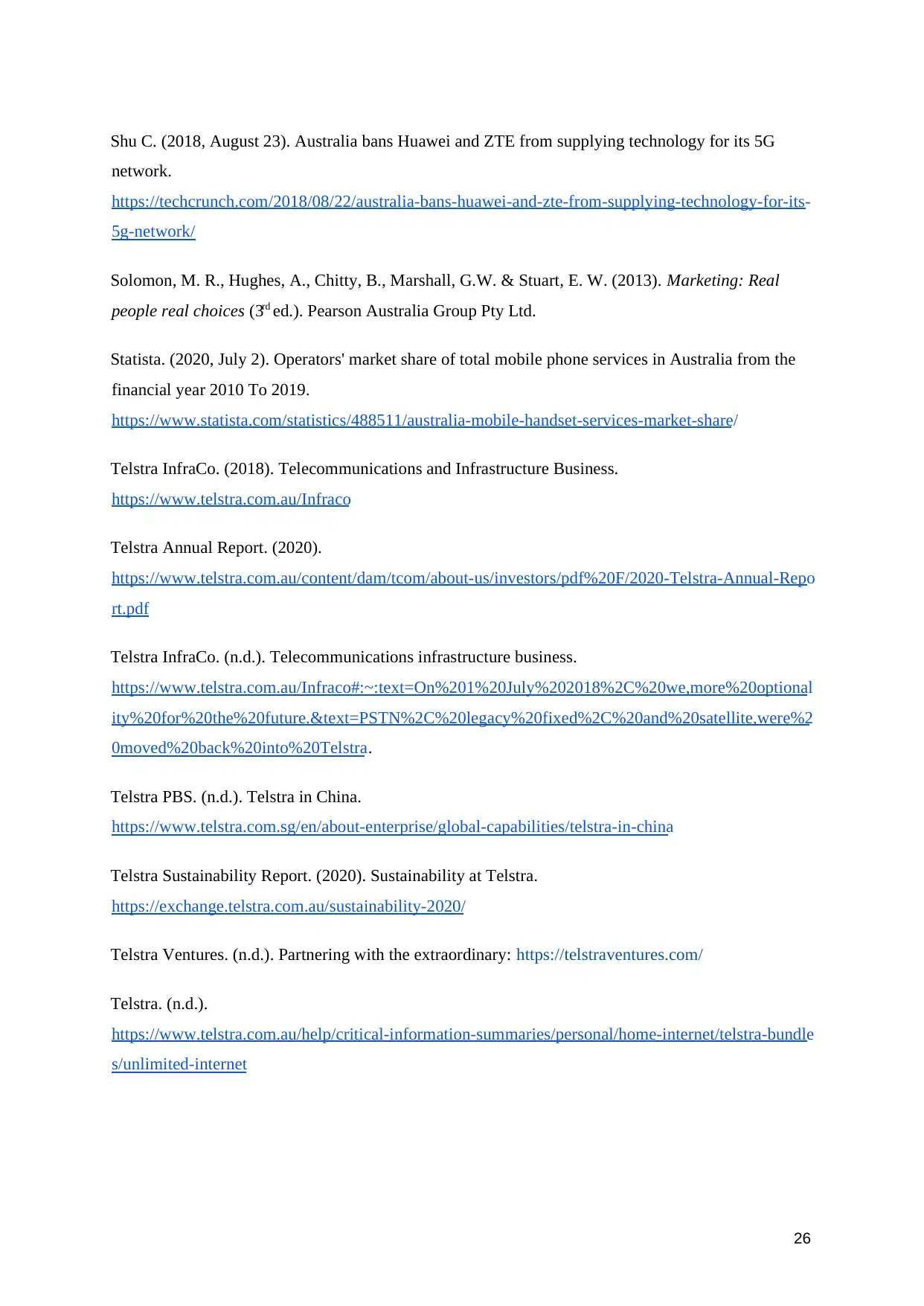
Shu C. (2018, August 23). Australia bans Huawei and ZTE from supplying technology for its 5G
network.
https://techcrunch.com/2018/08/22/australia-bans-huawei-and-zte-from-supplying-technology-for-its-
5g-network/
Solomon, M. R., Hughes, A., Chitty, B., Marshall, G.W. & Stuart, E. W. (2013). Marketing: Real
people real choices (3rd ed.). Pearson Australia Group Pty Ltd.
Statista. (2020, July 2). Operators' market share of total mobile phone services in Australia from the
financial year 2010 To 2019.
https://www.statista.com/statistics/488511/australia-mobile-handset-services-market-share/
Telstra InfraCo. (2018). Telecommunications and Infrastructure Business.
https://www.telstra.com.au/Infraco
Telstra Annual Report. (2020).
https://www.telstra.com.au/content/dam/tcom/about-us/investors/pdf%20F/2020-Telstra-Annual-Repo
rt.pdf
Telstra InfraCo. (n.d.). Telecommunications infrastructure business.
https://www.telstra.com.au/Infraco#:~:text=On%201%20July%202018%2C%20we,more%20optional
ity%20for%20the%20future.&text=PSTN%2C%20legacy%20fixed%2C%20and%20satellite,were%2
0moved%20back%20into%20Telstra.
Telstra PBS. (n.d.). Telstra in China.
https://www.telstra.com.sg/en/about-enterprise/global-capabilities/telstra-in-china
Telstra Sustainability Report. (2020). Sustainability at Telstra.
https://exchange.telstra.com.au/sustainability-2020/
Telstra Ventures. (n.d.). Partnering with the extraordinary: https://telstraventures.com/
Telstra. (n.d.).
https://www.telstra.com.au/help/critical-information-summaries/personal/home-internet/telstra-bundle
s/unlimited-internet
26
network.
https://techcrunch.com/2018/08/22/australia-bans-huawei-and-zte-from-supplying-technology-for-its-
5g-network/
Solomon, M. R., Hughes, A., Chitty, B., Marshall, G.W. & Stuart, E. W. (2013). Marketing: Real
people real choices (3rd ed.). Pearson Australia Group Pty Ltd.
Statista. (2020, July 2). Operators' market share of total mobile phone services in Australia from the
financial year 2010 To 2019.
https://www.statista.com/statistics/488511/australia-mobile-handset-services-market-share/
Telstra InfraCo. (2018). Telecommunications and Infrastructure Business.
https://www.telstra.com.au/Infraco
Telstra Annual Report. (2020).
https://www.telstra.com.au/content/dam/tcom/about-us/investors/pdf%20F/2020-Telstra-Annual-Repo
rt.pdf
Telstra InfraCo. (n.d.). Telecommunications infrastructure business.
https://www.telstra.com.au/Infraco#:~:text=On%201%20July%202018%2C%20we,more%20optional
ity%20for%20the%20future.&text=PSTN%2C%20legacy%20fixed%2C%20and%20satellite,were%2
0moved%20back%20into%20Telstra.
Telstra PBS. (n.d.). Telstra in China.
https://www.telstra.com.sg/en/about-enterprise/global-capabilities/telstra-in-china
Telstra Sustainability Report. (2020). Sustainability at Telstra.
https://exchange.telstra.com.au/sustainability-2020/
Telstra Ventures. (n.d.). Partnering with the extraordinary: https://telstraventures.com/
Telstra. (n.d.).
https://www.telstra.com.au/help/critical-information-summaries/personal/home-internet/telstra-bundle
s/unlimited-internet
26
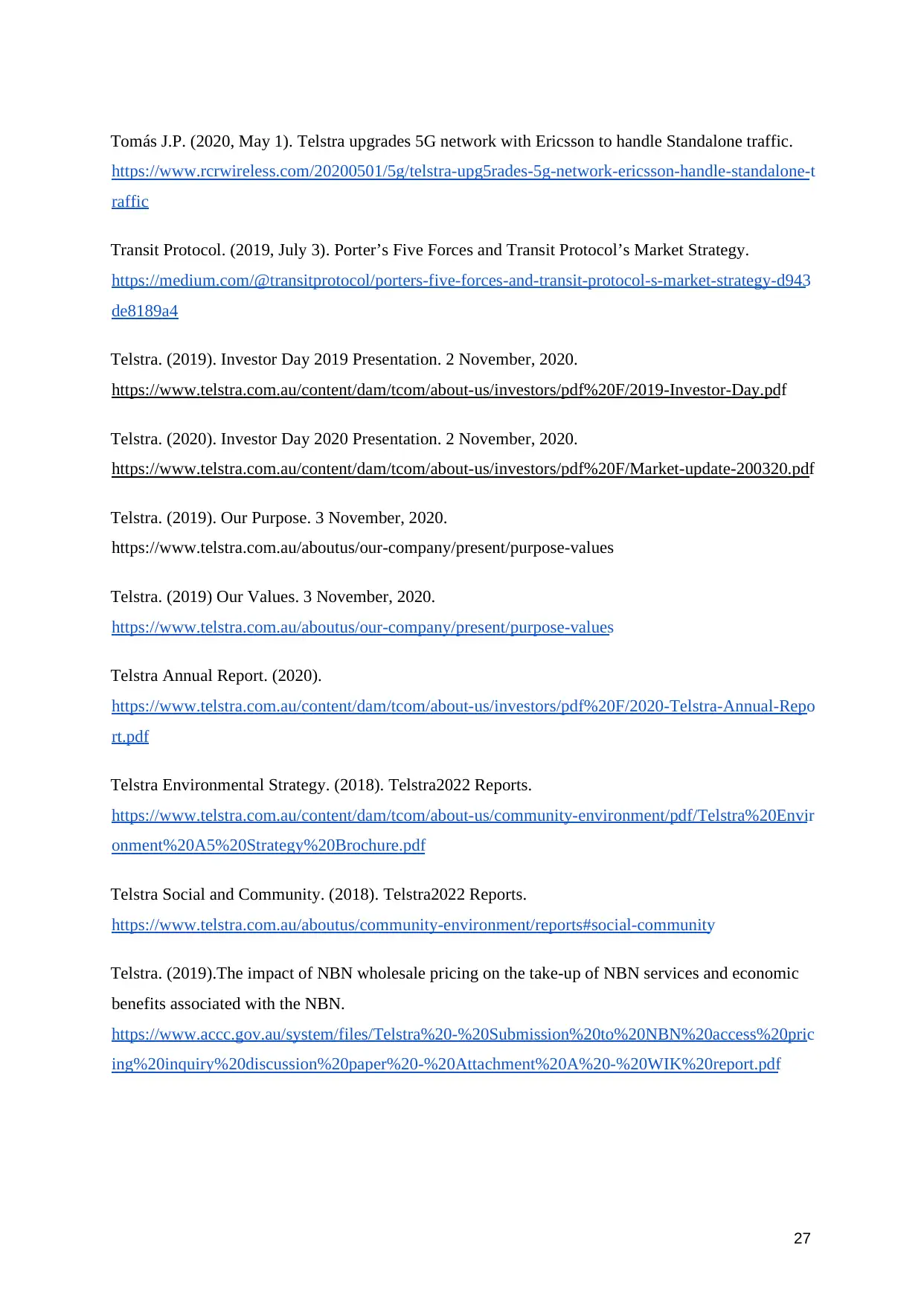
Tomás J.P. (2020, May 1). Telstra upgrades 5G network with Ericsson to handle Standalone traffic.
https://www.rcrwireless.com/20200501/5g/telstra-upg5rades-5g-network-ericsson-handle-standalone-t
raffic
Transit Protocol. (2019, July 3). Porter’s Five Forces and Transit Protocol’s Market Strategy.
https://medium.com/@transitprotocol/porters-five-forces-and-transit-protocol-s-market-strategy-d943
de8189a4
Telstra. (2019). Investor Day 2019 Presentation. 2 November, 2020.
https://www.telstra.com.au/content/dam/tcom/about-us/investors/pdf%20F/2019-Investor-Day.pdf
Telstra. (2020). Investor Day 2020 Presentation. 2 November, 2020.
https://www.telstra.com.au/content/dam/tcom/about-us/investors/pdf%20F/Market-update-200320.pdf
Telstra. (2019). Our Purpose. 3 November, 2020.
https://www.telstra.com.au/aboutus/our-company/present/purpose-values
Telstra. (2019) Our Values. 3 November, 2020.
https://www.telstra.com.au/aboutus/our-company/present/purpose-values
Telstra Annual Report. (2020).
https://www.telstra.com.au/content/dam/tcom/about-us/investors/pdf%20F/2020-Telstra-Annual-Repo
rt.pdf
Telstra Environmental Strategy. (2018). Telstra2022 Reports.
https://www.telstra.com.au/content/dam/tcom/about-us/community-environment/pdf/Telstra%20Envir
onment%20A5%20Strategy%20Brochure.pdf
Telstra Social and Community. (2018). Telstra2022 Reports.
https://www.telstra.com.au/aboutus/community-environment/reports#social-community
Telstra. (2019).The impact of NBN wholesale pricing on the take-up of NBN services and economic
benefits associated with the NBN.
https://www.accc.gov.au/system/files/Telstra%20-%20Submission%20to%20NBN%20access%20pric
ing%20inquiry%20discussion%20paper%20-%20Attachment%20A%20-%20WIK%20report.pdf
27
https://www.rcrwireless.com/20200501/5g/telstra-upg5rades-5g-network-ericsson-handle-standalone-t
raffic
Transit Protocol. (2019, July 3). Porter’s Five Forces and Transit Protocol’s Market Strategy.
https://medium.com/@transitprotocol/porters-five-forces-and-transit-protocol-s-market-strategy-d943
de8189a4
Telstra. (2019). Investor Day 2019 Presentation. 2 November, 2020.
https://www.telstra.com.au/content/dam/tcom/about-us/investors/pdf%20F/2019-Investor-Day.pdf
Telstra. (2020). Investor Day 2020 Presentation. 2 November, 2020.
https://www.telstra.com.au/content/dam/tcom/about-us/investors/pdf%20F/Market-update-200320.pdf
Telstra. (2019). Our Purpose. 3 November, 2020.
https://www.telstra.com.au/aboutus/our-company/present/purpose-values
Telstra. (2019) Our Values. 3 November, 2020.
https://www.telstra.com.au/aboutus/our-company/present/purpose-values
Telstra Annual Report. (2020).
https://www.telstra.com.au/content/dam/tcom/about-us/investors/pdf%20F/2020-Telstra-Annual-Repo
rt.pdf
Telstra Environmental Strategy. (2018). Telstra2022 Reports.
https://www.telstra.com.au/content/dam/tcom/about-us/community-environment/pdf/Telstra%20Envir
onment%20A5%20Strategy%20Brochure.pdf
Telstra Social and Community. (2018). Telstra2022 Reports.
https://www.telstra.com.au/aboutus/community-environment/reports#social-community
Telstra. (2019).The impact of NBN wholesale pricing on the take-up of NBN services and economic
benefits associated with the NBN.
https://www.accc.gov.au/system/files/Telstra%20-%20Submission%20to%20NBN%20access%20pric
ing%20inquiry%20discussion%20paper%20-%20Attachment%20A%20-%20WIK%20report.pdf
27

28
Secure Best Marks with AI Grader
Need help grading? Try our AI Grader for instant feedback on your assignments.
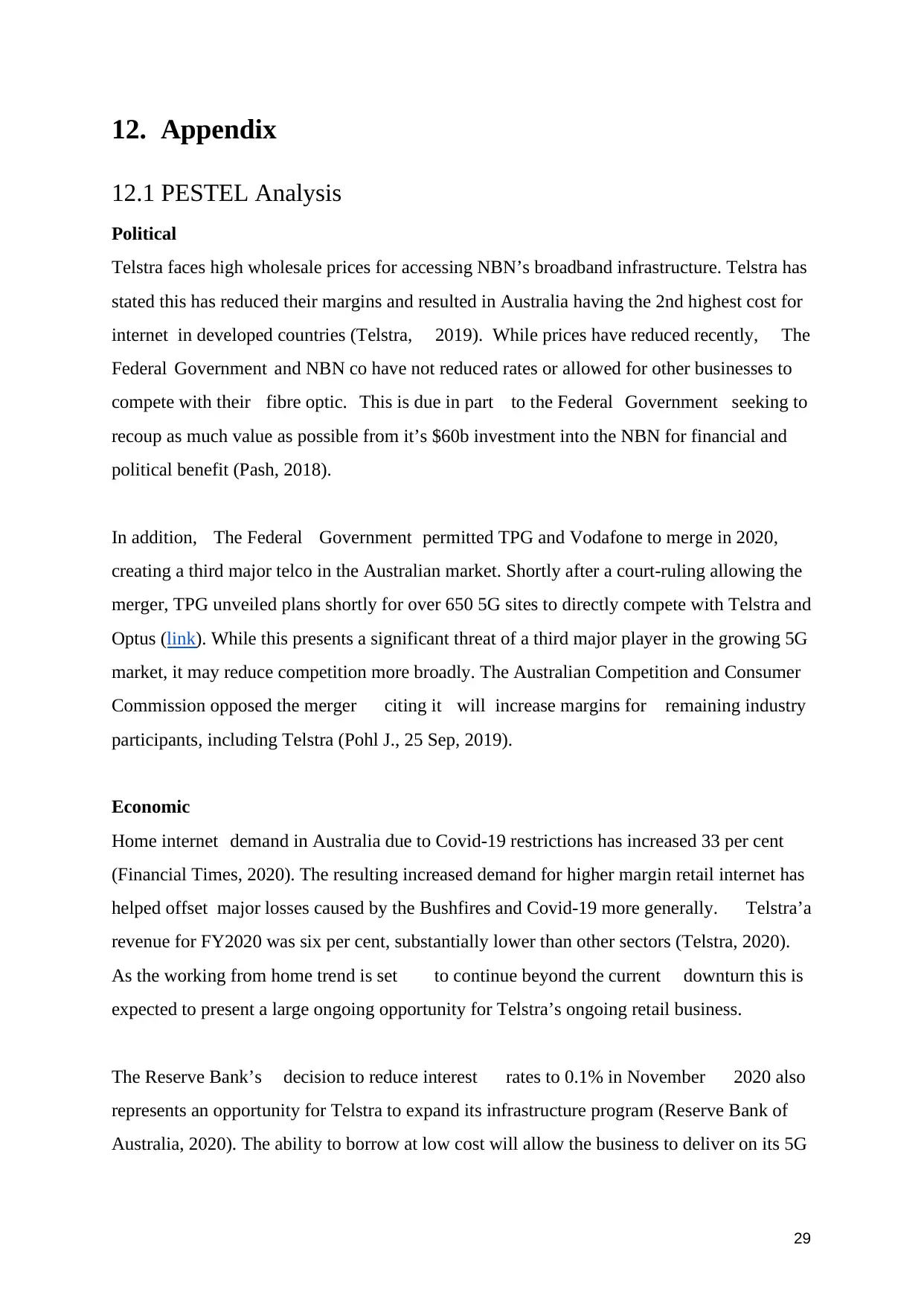
12. Appendix
12.1 PESTEL Analysis
Political
Telstra faces high wholesale prices for accessing NBN’s broadband infrastructure. Telstra has
stated this has reduced their margins and resulted in Australia having the 2nd highest cost for
internet in developed countries (Telstra, 2019). While prices have reduced recently, The
Federal Government and NBN co have not reduced rates or allowed for other businesses to
compete with their fibre optic. This is due in part to the Federal Government seeking to
recoup as much value as possible from it’s $60b investment into the NBN for financial and
political benefit (Pash, 2018).
In addition, The Federal Government permitted TPG and Vodafone to merge in 2020,
creating a third major telco in the Australian market. Shortly after a court-ruling allowing the
merger, TPG unveiled plans shortly for over 650 5G sites to directly compete with Telstra and
Optus (link). While this presents a significant threat of a third major player in the growing 5G
market, it may reduce competition more broadly. The Australian Competition and Consumer
Commission opposed the merger citing it will increase margins for remaining industry
participants, including Telstra (Pohl J., 25 Sep, 2019).
Economic
Home internet demand in Australia due to Covid-19 restrictions has increased 33 per cent
(Financial Times, 2020). The resulting increased demand for higher margin retail internet has
helped offset major losses caused by the Bushfires and Covid-19 more generally. Telstra’a
revenue for FY2020 was six per cent, substantially lower than other sectors (Telstra, 2020).
As the working from home trend is set to continue beyond the current downturn this is
expected to present a large ongoing opportunity for Telstra’s ongoing retail business.
The Reserve Bank’s decision to reduce interest rates to 0.1% in November 2020 also
represents an opportunity for Telstra to expand its infrastructure program (Reserve Bank of
Australia, 2020). The ability to borrow at low cost will allow the business to deliver on its 5G
29
12.1 PESTEL Analysis
Political
Telstra faces high wholesale prices for accessing NBN’s broadband infrastructure. Telstra has
stated this has reduced their margins and resulted in Australia having the 2nd highest cost for
internet in developed countries (Telstra, 2019). While prices have reduced recently, The
Federal Government and NBN co have not reduced rates or allowed for other businesses to
compete with their fibre optic. This is due in part to the Federal Government seeking to
recoup as much value as possible from it’s $60b investment into the NBN for financial and
political benefit (Pash, 2018).
In addition, The Federal Government permitted TPG and Vodafone to merge in 2020,
creating a third major telco in the Australian market. Shortly after a court-ruling allowing the
merger, TPG unveiled plans shortly for over 650 5G sites to directly compete with Telstra and
Optus (link). While this presents a significant threat of a third major player in the growing 5G
market, it may reduce competition more broadly. The Australian Competition and Consumer
Commission opposed the merger citing it will increase margins for remaining industry
participants, including Telstra (Pohl J., 25 Sep, 2019).
Economic
Home internet demand in Australia due to Covid-19 restrictions has increased 33 per cent
(Financial Times, 2020). The resulting increased demand for higher margin retail internet has
helped offset major losses caused by the Bushfires and Covid-19 more generally. Telstra’a
revenue for FY2020 was six per cent, substantially lower than other sectors (Telstra, 2020).
As the working from home trend is set to continue beyond the current downturn this is
expected to present a large ongoing opportunity for Telstra’s ongoing retail business.
The Reserve Bank’s decision to reduce interest rates to 0.1% in November 2020 also
represents an opportunity for Telstra to expand its infrastructure program (Reserve Bank of
Australia, 2020). The ability to borrow at low cost will allow the business to deliver on its 5G
29
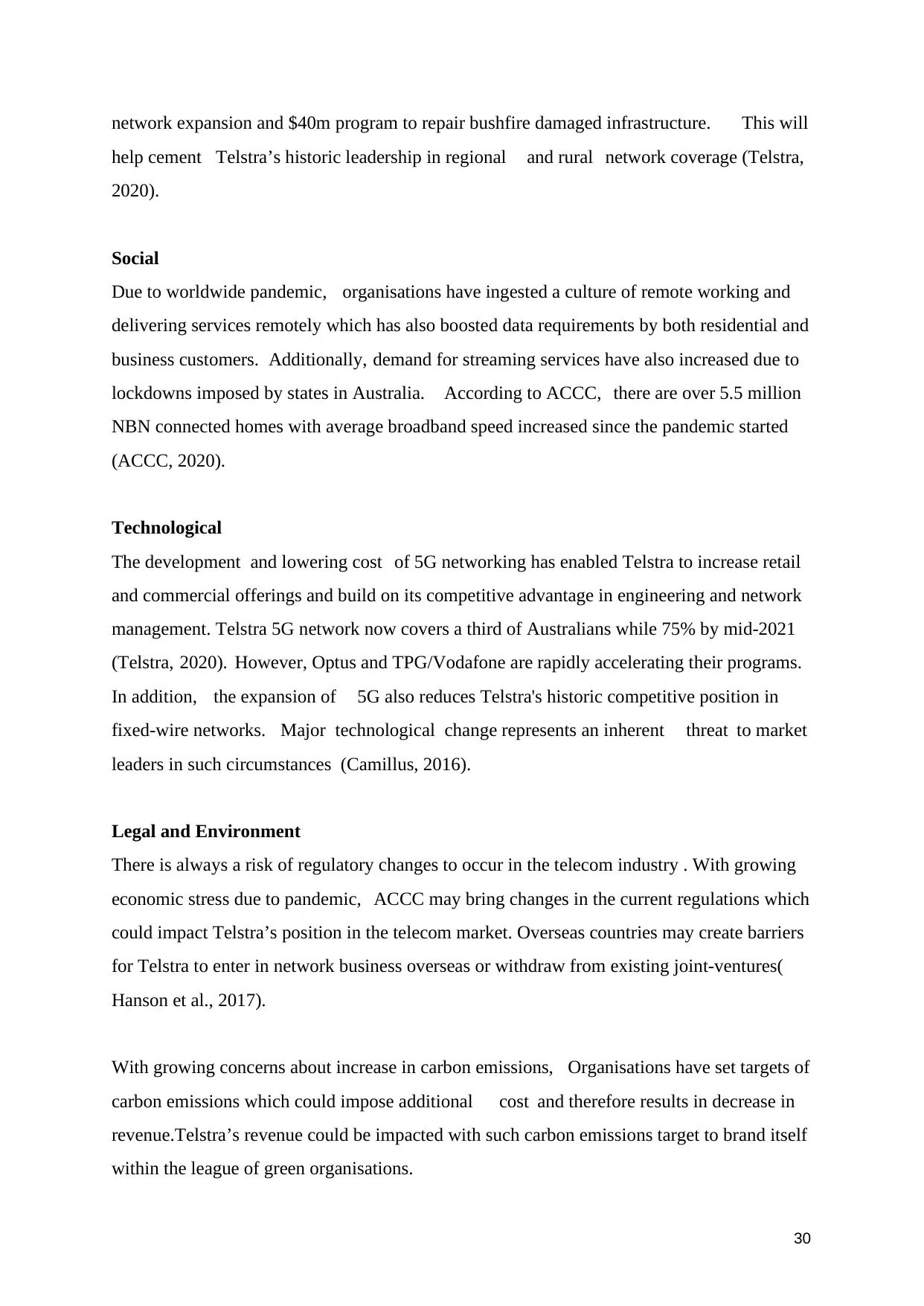
network expansion and $40m program to repair bushfire damaged infrastructure. This will
help cement Telstra’s historic leadership in regional and rural network coverage (Telstra,
2020).
Social
Due to worldwide pandemic, organisations have ingested a culture of remote working and
delivering services remotely which has also boosted data requirements by both residential and
business customers. Additionally, demand for streaming services have also increased due to
lockdowns imposed by states in Australia. According to ACCC, there are over 5.5 million
NBN connected homes with average broadband speed increased since the pandemic started
(ACCC, 2020).
Technological
The development and lowering cost of 5G networking has enabled Telstra to increase retail
and commercial offerings and build on its competitive advantage in engineering and network
management. Telstra 5G network now covers a third of Australians while 75% by mid-2021
(Telstra, 2020). However, Optus and TPG/Vodafone are rapidly accelerating their programs.
In addition, the expansion of 5G also reduces Telstra's historic competitive position in
fixed-wire networks. Major technological change represents an inherent threat to market
leaders in such circumstances (Camillus, 2016).
Legal and Environment
There is always a risk of regulatory changes to occur in the telecom industry . With growing
economic stress due to pandemic, ACCC may bring changes in the current regulations which
could impact Telstra’s position in the telecom market. Overseas countries may create barriers
for Telstra to enter in network business overseas or withdraw from existing joint-ventures(
Hanson et al., 2017).
With growing concerns about increase in carbon emissions, Organisations have set targets of
carbon emissions which could impose additional cost and therefore results in decrease in
revenue.Telstra’s revenue could be impacted with such carbon emissions target to brand itself
within the league of green organisations.
30
help cement Telstra’s historic leadership in regional and rural network coverage (Telstra,
2020).
Social
Due to worldwide pandemic, organisations have ingested a culture of remote working and
delivering services remotely which has also boosted data requirements by both residential and
business customers. Additionally, demand for streaming services have also increased due to
lockdowns imposed by states in Australia. According to ACCC, there are over 5.5 million
NBN connected homes with average broadband speed increased since the pandemic started
(ACCC, 2020).
Technological
The development and lowering cost of 5G networking has enabled Telstra to increase retail
and commercial offerings and build on its competitive advantage in engineering and network
management. Telstra 5G network now covers a third of Australians while 75% by mid-2021
(Telstra, 2020). However, Optus and TPG/Vodafone are rapidly accelerating their programs.
In addition, the expansion of 5G also reduces Telstra's historic competitive position in
fixed-wire networks. Major technological change represents an inherent threat to market
leaders in such circumstances (Camillus, 2016).
Legal and Environment
There is always a risk of regulatory changes to occur in the telecom industry . With growing
economic stress due to pandemic, ACCC may bring changes in the current regulations which
could impact Telstra’s position in the telecom market. Overseas countries may create barriers
for Telstra to enter in network business overseas or withdraw from existing joint-ventures(
Hanson et al., 2017).
With growing concerns about increase in carbon emissions, Organisations have set targets of
carbon emissions which could impose additional cost and therefore results in decrease in
revenue.Telstra’s revenue could be impacted with such carbon emissions target to brand itself
within the league of green organisations.
30
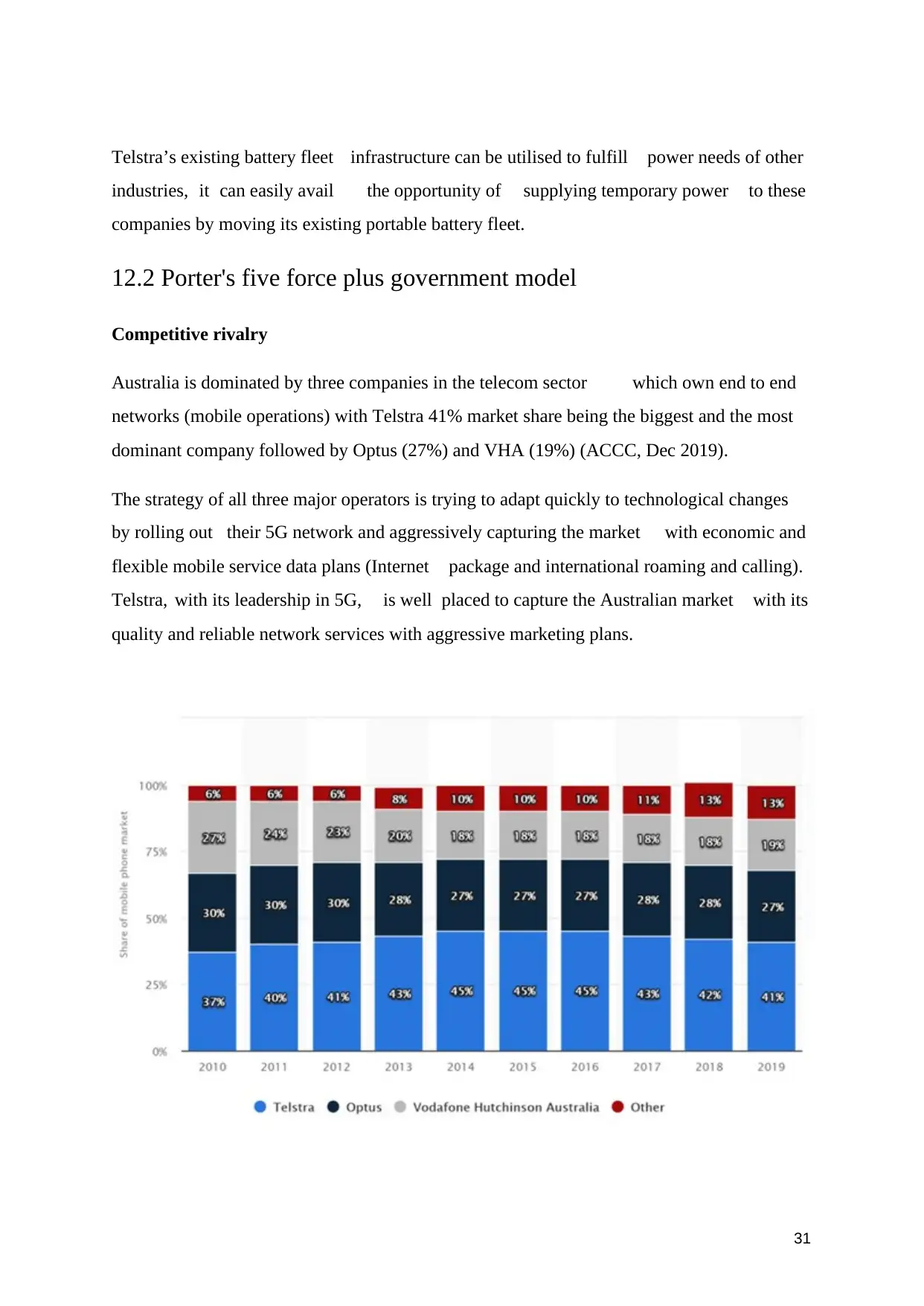
Telstra’s existing battery fleet infrastructure can be utilised to fulfill power needs of other
industries, it can easily avail the opportunity of supplying temporary power to these
companies by moving its existing portable battery fleet.
12.2 Porter's five force plus government model
Competitive rivalry
Australia is dominated by three companies in the telecom sector which own end to end
networks (mobile operations) with Telstra 41% market share being the biggest and the most
dominant company followed by Optus (27%) and VHA (19%) (ACCC, Dec 2019).
The strategy of all three major operators is trying to adapt quickly to technological changes
by rolling out their 5G network and aggressively capturing the market with economic and
flexible mobile service data plans (Internet package and international roaming and calling).
Telstra, with its leadership in 5G, is well placed to capture the Australian market with its
quality and reliable network services with aggressive marketing plans.
31
industries, it can easily avail the opportunity of supplying temporary power to these
companies by moving its existing portable battery fleet.
12.2 Porter's five force plus government model
Competitive rivalry
Australia is dominated by three companies in the telecom sector which own end to end
networks (mobile operations) with Telstra 41% market share being the biggest and the most
dominant company followed by Optus (27%) and VHA (19%) (ACCC, Dec 2019).
The strategy of all three major operators is trying to adapt quickly to technological changes
by rolling out their 5G network and aggressively capturing the market with economic and
flexible mobile service data plans (Internet package and international roaming and calling).
Telstra, with its leadership in 5G, is well placed to capture the Australian market with its
quality and reliable network services with aggressive marketing plans.
31
Paraphrase This Document
Need a fresh take? Get an instant paraphrase of this document with our AI Paraphraser
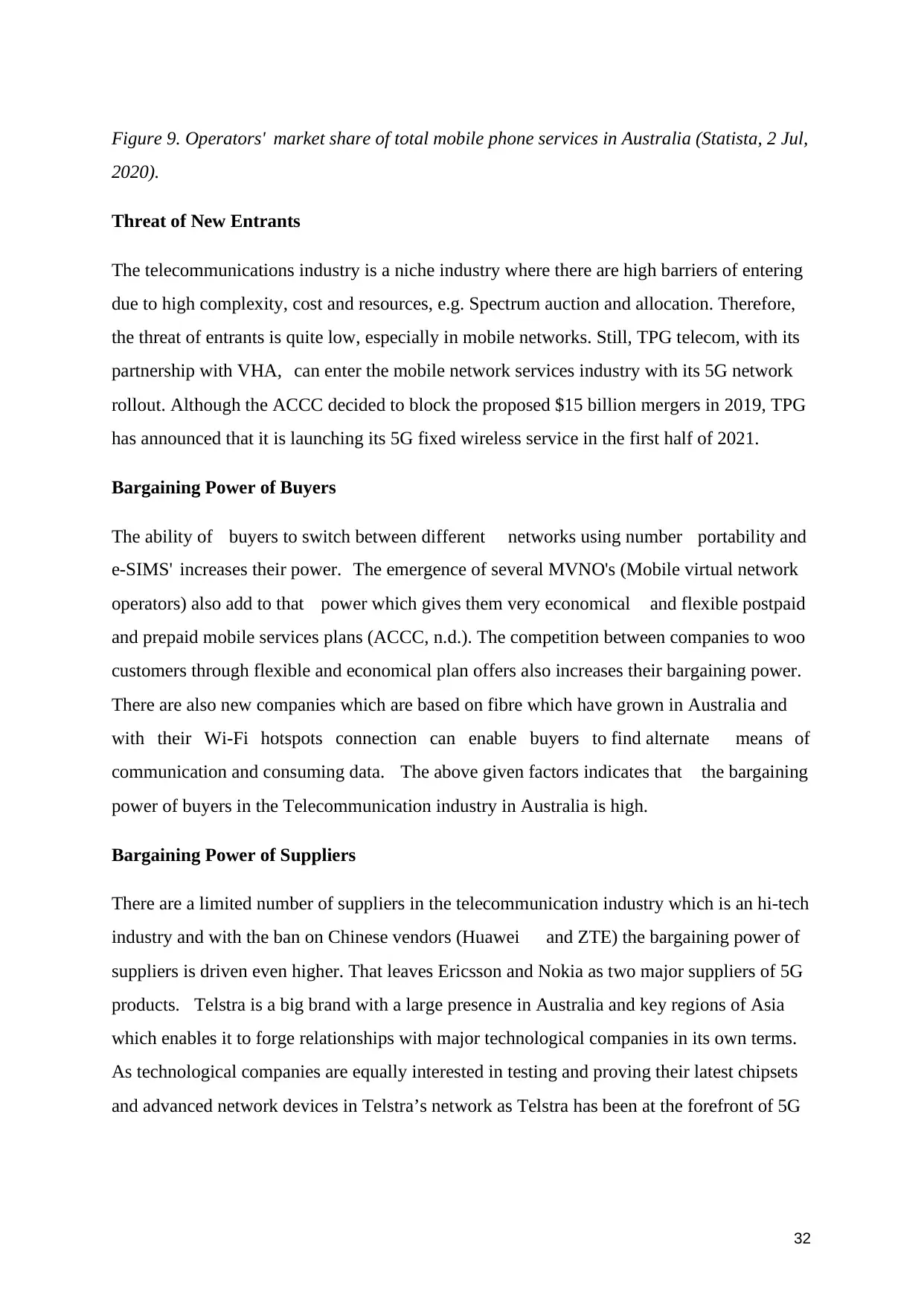
Figure 9. Operators' market share of total mobile phone services in Australia (Statista, 2 Jul,
2020).
Threat of New Entrants
The telecommunications industry is a niche industry where there are high barriers of entering
due to high complexity, cost and resources, e.g. Spectrum auction and allocation. Therefore,
the threat of entrants is quite low, especially in mobile networks. Still, TPG telecom, with its
partnership with VHA, can enter the mobile network services industry with its 5G network
rollout. Although the ACCC decided to block the proposed $15 billion mergers in 2019, TPG
has announced that it is launching its 5G fixed wireless service in the first half of 2021.
Bargaining Power of Buyers
The ability of buyers to switch between different networks using number portability and
e-SIMS' increases their power. The emergence of several MVNO's (Mobile virtual network
operators) also add to that power which gives them very economical and flexible postpaid
and prepaid mobile services plans (ACCC, n.d.). The competition between companies to woo
customers through flexible and economical plan offers also increases their bargaining power.
There are also new companies which are based on fibre which have grown in Australia and
with their Wi-Fi hotspots connection can enable buyers to find alternate means of
communication and consuming data. The above given factors indicates that the bargaining
power of buyers in the Telecommunication industry in Australia is high.
Bargaining Power of Suppliers
There are a limited number of suppliers in the telecommunication industry which is an hi-tech
industry and with the ban on Chinese vendors (Huawei and ZTE) the bargaining power of
suppliers is driven even higher. That leaves Ericsson and Nokia as two major suppliers of 5G
products. Telstra is a big brand with a large presence in Australia and key regions of Asia
which enables it to forge relationships with major technological companies in its own terms.
As technological companies are equally interested in testing and proving their latest chipsets
and advanced network devices in Telstra’s network as Telstra has been at the forefront of 5G
32
2020).
Threat of New Entrants
The telecommunications industry is a niche industry where there are high barriers of entering
due to high complexity, cost and resources, e.g. Spectrum auction and allocation. Therefore,
the threat of entrants is quite low, especially in mobile networks. Still, TPG telecom, with its
partnership with VHA, can enter the mobile network services industry with its 5G network
rollout. Although the ACCC decided to block the proposed $15 billion mergers in 2019, TPG
has announced that it is launching its 5G fixed wireless service in the first half of 2021.
Bargaining Power of Buyers
The ability of buyers to switch between different networks using number portability and
e-SIMS' increases their power. The emergence of several MVNO's (Mobile virtual network
operators) also add to that power which gives them very economical and flexible postpaid
and prepaid mobile services plans (ACCC, n.d.). The competition between companies to woo
customers through flexible and economical plan offers also increases their bargaining power.
There are also new companies which are based on fibre which have grown in Australia and
with their Wi-Fi hotspots connection can enable buyers to find alternate means of
communication and consuming data. The above given factors indicates that the bargaining
power of buyers in the Telecommunication industry in Australia is high.
Bargaining Power of Suppliers
There are a limited number of suppliers in the telecommunication industry which is an hi-tech
industry and with the ban on Chinese vendors (Huawei and ZTE) the bargaining power of
suppliers is driven even higher. That leaves Ericsson and Nokia as two major suppliers of 5G
products. Telstra is a big brand with a large presence in Australia and key regions of Asia
which enables it to forge relationships with major technological companies in its own terms.
As technological companies are equally interested in testing and proving their latest chipsets
and advanced network devices in Telstra’s network as Telstra has been at the forefront of 5G
32
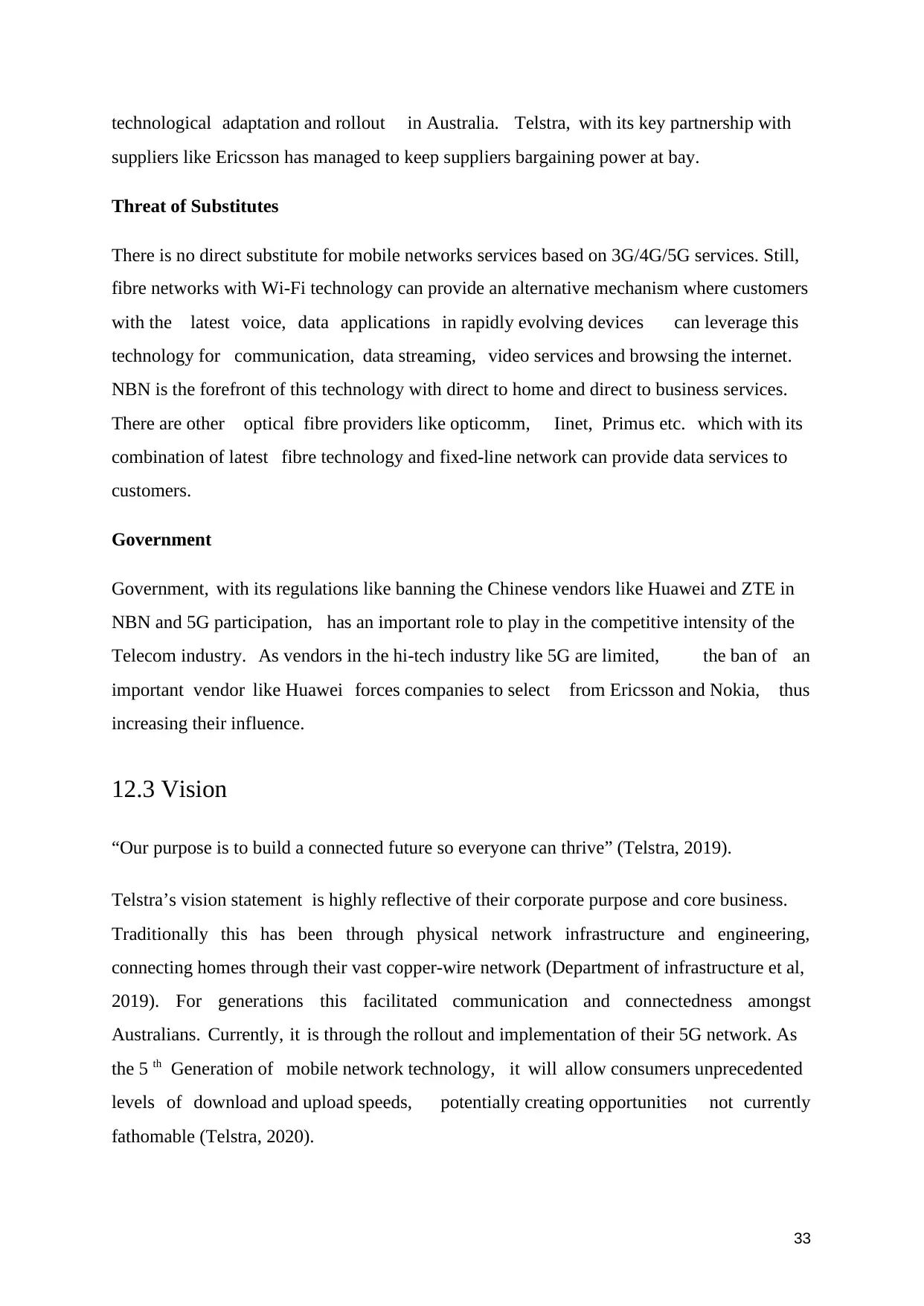
technological adaptation and rollout in Australia. Telstra, with its key partnership with
suppliers like Ericsson has managed to keep suppliers bargaining power at bay.
Threat of Substitutes
There is no direct substitute for mobile networks services based on 3G/4G/5G services. Still,
fibre networks with Wi-Fi technology can provide an alternative mechanism where customers
with the latest voice, data applications in rapidly evolving devices can leverage this
technology for communication, data streaming, video services and browsing the internet.
NBN is the forefront of this technology with direct to home and direct to business services.
There are other optical fibre providers like opticomm, Iinet, Primus etc. which with its
combination of latest fibre technology and fixed-line network can provide data services to
customers.
Government
Government, with its regulations like banning the Chinese vendors like Huawei and ZTE in
NBN and 5G participation, has an important role to play in the competitive intensity of the
Telecom industry. As vendors in the hi-tech industry like 5G are limited, the ban of an
important vendor like Huawei forces companies to select from Ericsson and Nokia, thus
increasing their influence.
12.3 Vision
“Our purpose is to build a connected future so everyone can thrive” (Telstra, 2019).
Telstra’s vision statement is highly reflective of their corporate purpose and core business.
Traditionally this has been through physical network infrastructure and engineering,
connecting homes through their vast copper-wire network (Department of infrastructure et al,
2019). For generations this facilitated communication and connectedness amongst
Australians. Currently, it is through the rollout and implementation of their 5G network. As
the 5 th Generation of mobile network technology, it will allow consumers unprecedented
levels of download and upload speeds, potentially creating opportunities not currently
fathomable (Telstra, 2020).
33
suppliers like Ericsson has managed to keep suppliers bargaining power at bay.
Threat of Substitutes
There is no direct substitute for mobile networks services based on 3G/4G/5G services. Still,
fibre networks with Wi-Fi technology can provide an alternative mechanism where customers
with the latest voice, data applications in rapidly evolving devices can leverage this
technology for communication, data streaming, video services and browsing the internet.
NBN is the forefront of this technology with direct to home and direct to business services.
There are other optical fibre providers like opticomm, Iinet, Primus etc. which with its
combination of latest fibre technology and fixed-line network can provide data services to
customers.
Government
Government, with its regulations like banning the Chinese vendors like Huawei and ZTE in
NBN and 5G participation, has an important role to play in the competitive intensity of the
Telecom industry. As vendors in the hi-tech industry like 5G are limited, the ban of an
important vendor like Huawei forces companies to select from Ericsson and Nokia, thus
increasing their influence.
12.3 Vision
“Our purpose is to build a connected future so everyone can thrive” (Telstra, 2019).
Telstra’s vision statement is highly reflective of their corporate purpose and core business.
Traditionally this has been through physical network infrastructure and engineering,
connecting homes through their vast copper-wire network (Department of infrastructure et al,
2019). For generations this facilitated communication and connectedness amongst
Australians. Currently, it is through the rollout and implementation of their 5G network. As
the 5 th Generation of mobile network technology, it will allow consumers unprecedented
levels of download and upload speeds, potentially creating opportunities not currently
fathomable (Telstra, 2020).
33
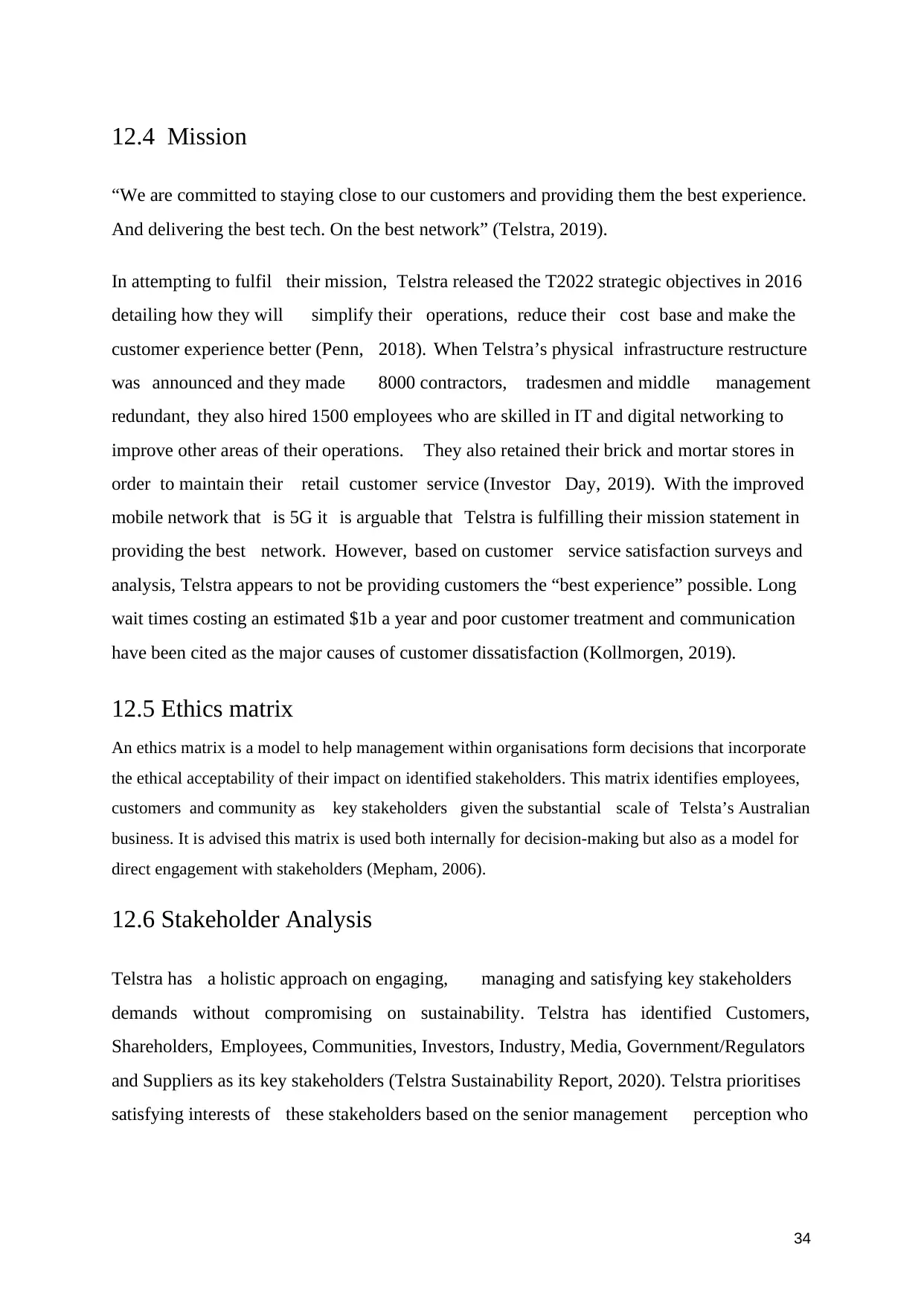
12.4 Mission
“We are committed to staying close to our customers and providing them the best experience.
And delivering the best tech. On the best network” (Telstra, 2019).
In attempting to fulfil their mission, Telstra released the T2022 strategic objectives in 2016
detailing how they will simplify their operations, reduce their cost base and make the
customer experience better (Penn, 2018). When Telstra’s physical infrastructure restructure
was announced and they made 8000 contractors, tradesmen and middle management
redundant, they also hired 1500 employees who are skilled in IT and digital networking to
improve other areas of their operations. They also retained their brick and mortar stores in
order to maintain their retail customer service (Investor Day, 2019). With the improved
mobile network that is 5G it is arguable that Telstra is fulfilling their mission statement in
providing the best network. However, based on customer service satisfaction surveys and
analysis, Telstra appears to not be providing customers the “best experience” possible. Long
wait times costing an estimated $1b a year and poor customer treatment and communication
have been cited as the major causes of customer dissatisfaction (Kollmorgen, 2019).
12.5 Ethics matrix
An ethics matrix is a model to help management within organisations form decisions that incorporate
the ethical acceptability of their impact on identified stakeholders. This matrix identifies employees,
customers and community as key stakeholders given the substantial scale of Telsta’s Australian
business. It is advised this matrix is used both internally for decision-making but also as a model for
direct engagement with stakeholders (Mepham, 2006).
12.6 Stakeholder Analysis
Telstra has a holistic approach on engaging, managing and satisfying key stakeholders
demands without compromising on sustainability. Telstra has identified Customers,
Shareholders, Employees, Communities, Investors, Industry, Media, Government/Regulators
and Suppliers as its key stakeholders (Telstra Sustainability Report, 2020). Telstra prioritises
satisfying interests of these stakeholders based on the senior management perception who
34
“We are committed to staying close to our customers and providing them the best experience.
And delivering the best tech. On the best network” (Telstra, 2019).
In attempting to fulfil their mission, Telstra released the T2022 strategic objectives in 2016
detailing how they will simplify their operations, reduce their cost base and make the
customer experience better (Penn, 2018). When Telstra’s physical infrastructure restructure
was announced and they made 8000 contractors, tradesmen and middle management
redundant, they also hired 1500 employees who are skilled in IT and digital networking to
improve other areas of their operations. They also retained their brick and mortar stores in
order to maintain their retail customer service (Investor Day, 2019). With the improved
mobile network that is 5G it is arguable that Telstra is fulfilling their mission statement in
providing the best network. However, based on customer service satisfaction surveys and
analysis, Telstra appears to not be providing customers the “best experience” possible. Long
wait times costing an estimated $1b a year and poor customer treatment and communication
have been cited as the major causes of customer dissatisfaction (Kollmorgen, 2019).
12.5 Ethics matrix
An ethics matrix is a model to help management within organisations form decisions that incorporate
the ethical acceptability of their impact on identified stakeholders. This matrix identifies employees,
customers and community as key stakeholders given the substantial scale of Telsta’s Australian
business. It is advised this matrix is used both internally for decision-making but also as a model for
direct engagement with stakeholders (Mepham, 2006).
12.6 Stakeholder Analysis
Telstra has a holistic approach on engaging, managing and satisfying key stakeholders
demands without compromising on sustainability. Telstra has identified Customers,
Shareholders, Employees, Communities, Investors, Industry, Media, Government/Regulators
and Suppliers as its key stakeholders (Telstra Sustainability Report, 2020). Telstra prioritises
satisfying interests of these stakeholders based on the senior management perception who
34
Secure Best Marks with AI Grader
Need help grading? Try our AI Grader for instant feedback on your assignments.

determine which stakeholders are salient and therefore will receive attention (Mitchell et al.,
1997).
Telstra key highlights for year 2020 includes helping ~ 2.6 million customers stay connected
through COVID-19 support packages, 55% reduction in emissions, supporting community
with the tune of $150 million through investment programs, certified as carbon neutral,
23,000 persons trained through digital capability programs and 3,923t of e-waste collected
(Telstra Sustainability Report, 2020). Apart from that Telstra has various functional programs
which aligns to its strategic objectives and works on satisfying the key stakeholders interests
and demands.
Foxtel offers a clear focus on increasing customer satisfaction, through its streamlining of
product offerings and transition towards making Telstra a more user friendly and flexible
organisation to interact with. The significant reduction in product lines and no lock in
contracts, indicates an understanding of the primary barriers for customers and a strong intent
to remove these barriers. This is likely, due to the advent of 5G, placing additional
competitive pressure on Foxtel to maintain its market share. Customers are demanding
increasing innovation, service, and choice and pricing flexibility.
The focus on sustained growth demonstrates a commitment to the shareholders as dominant
stakeholders and also an understanding of the increasing need for capital expenditure to
innovate and supports customers as the definitive stakeholder.
Whilst employees are a dominant stakeholder, the significant reduction on staffing levels and
the increase in the employees with the skills set to increase their networking capabilities,
indicates that Telstra employees are not considered to be one monolithic stakeholder, and
employee stakeholders without skills that can progress Telstra’s networking goals have been
deprioritised.
The strategic objectives focus heavily on these three stakeholders , indicating their
importance to Telstra and the necessity of Telstra to provide a highly focussed strategic plan
in the dynamic 5G telco environment.
35
1997).
Telstra key highlights for year 2020 includes helping ~ 2.6 million customers stay connected
through COVID-19 support packages, 55% reduction in emissions, supporting community
with the tune of $150 million through investment programs, certified as carbon neutral,
23,000 persons trained through digital capability programs and 3,923t of e-waste collected
(Telstra Sustainability Report, 2020). Apart from that Telstra has various functional programs
which aligns to its strategic objectives and works on satisfying the key stakeholders interests
and demands.
Foxtel offers a clear focus on increasing customer satisfaction, through its streamlining of
product offerings and transition towards making Telstra a more user friendly and flexible
organisation to interact with. The significant reduction in product lines and no lock in
contracts, indicates an understanding of the primary barriers for customers and a strong intent
to remove these barriers. This is likely, due to the advent of 5G, placing additional
competitive pressure on Foxtel to maintain its market share. Customers are demanding
increasing innovation, service, and choice and pricing flexibility.
The focus on sustained growth demonstrates a commitment to the shareholders as dominant
stakeholders and also an understanding of the increasing need for capital expenditure to
innovate and supports customers as the definitive stakeholder.
Whilst employees are a dominant stakeholder, the significant reduction on staffing levels and
the increase in the employees with the skills set to increase their networking capabilities,
indicates that Telstra employees are not considered to be one monolithic stakeholder, and
employee stakeholders without skills that can progress Telstra’s networking goals have been
deprioritised.
The strategic objectives focus heavily on these three stakeholders , indicating their
importance to Telstra and the necessity of Telstra to provide a highly focussed strategic plan
in the dynamic 5G telco environment.
35
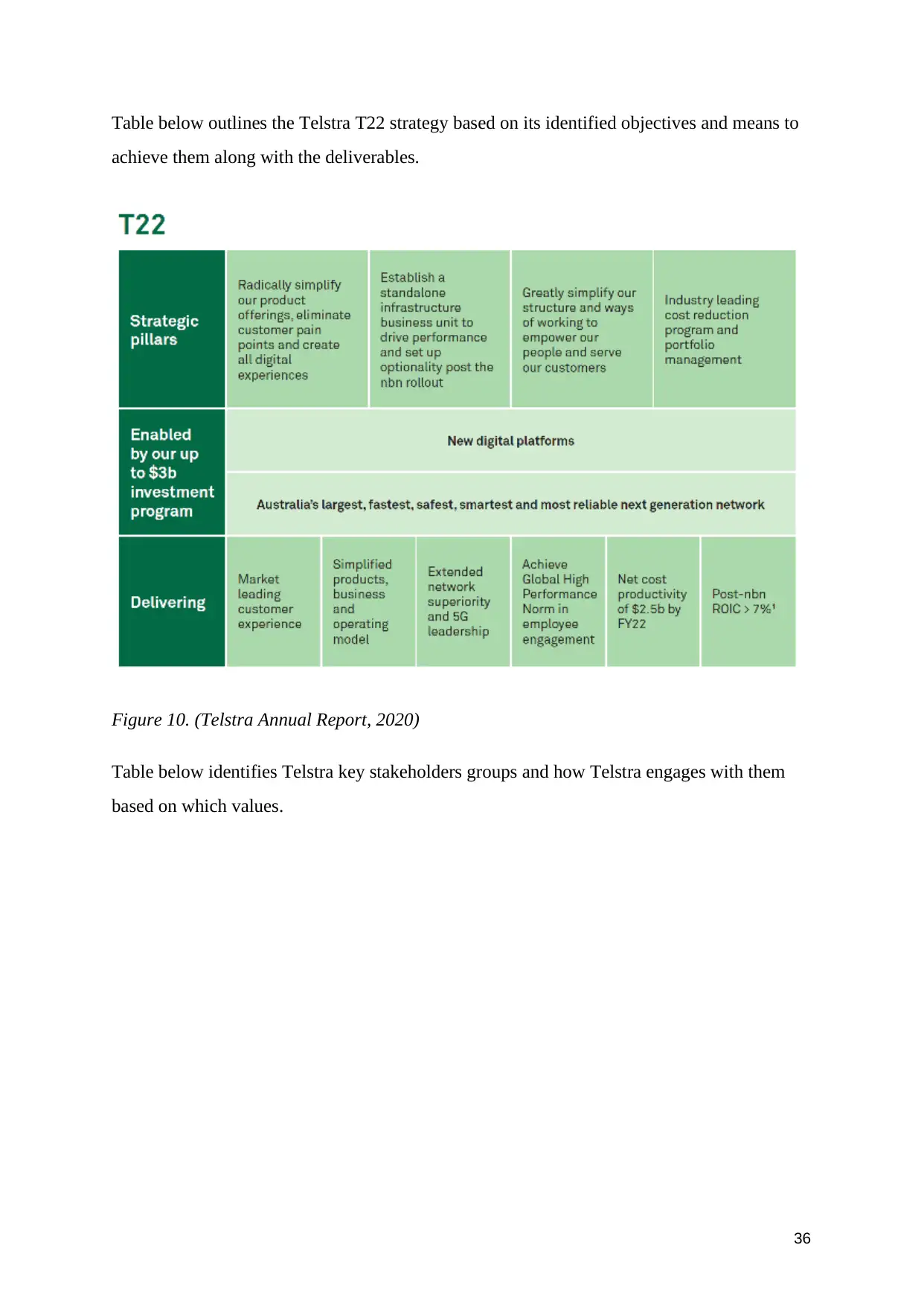
Table below outlines the Telstra T22 strategy based on its identified objectives and means to
achieve them along with the deliverables.
Figure 10. (Telstra Annual Report, 2020)
Table below identifies Telstra key stakeholders groups and how Telstra engages with them
based on which values.
36
achieve them along with the deliverables.
Figure 10. (Telstra Annual Report, 2020)
Table below identifies Telstra key stakeholders groups and how Telstra engages with them
based on which values.
36
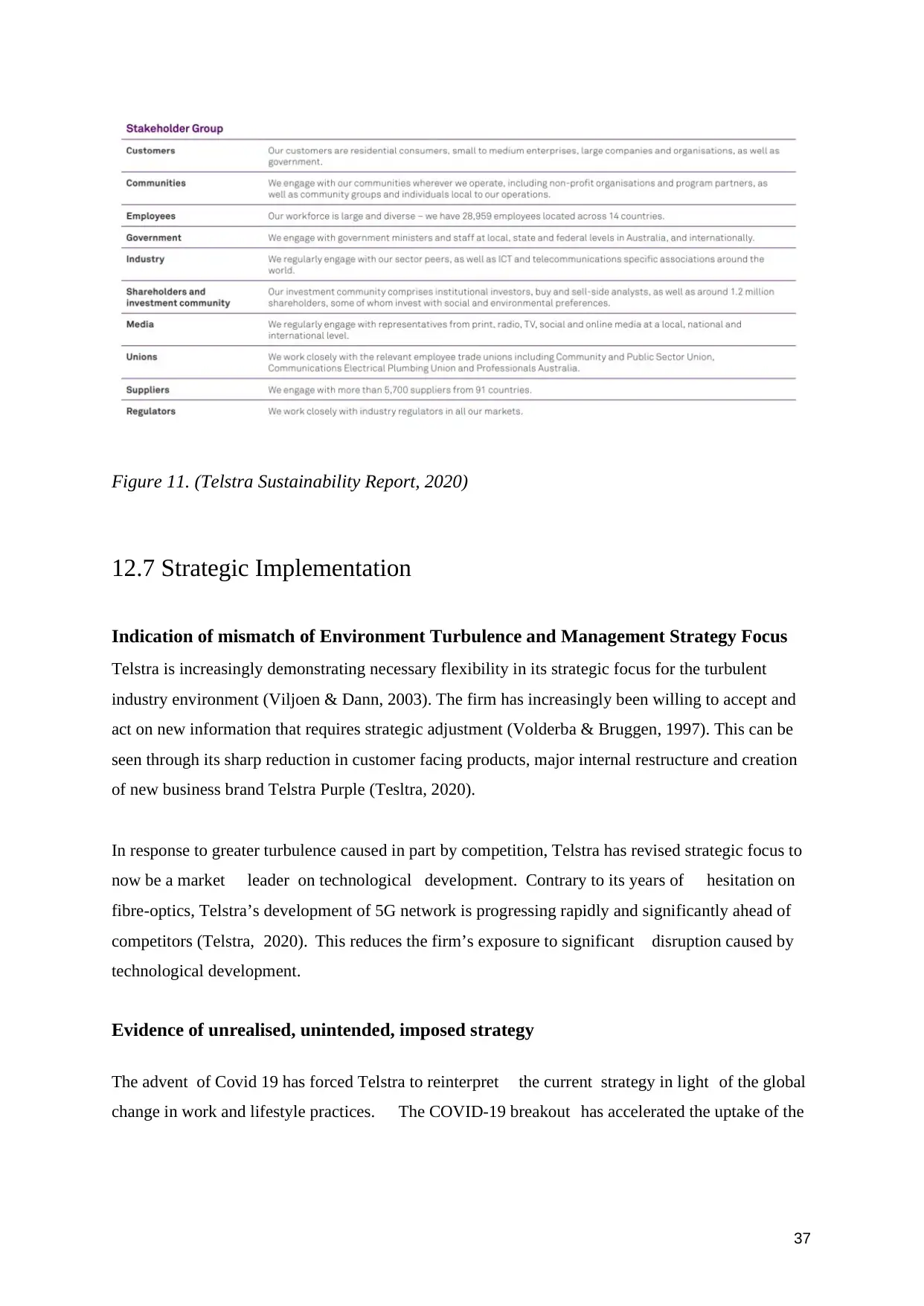
Figure 11. (Telstra Sustainability Report, 2020)
12.7 Strategic Implementation
Indication of mismatch of Environment Turbulence and Management Strategy Focus
Telstra is increasingly demonstrating necessary flexibility in its strategic focus for the turbulent
industry environment (Viljoen & Dann, 2003). The firm has increasingly been willing to accept and
act on new information that requires strategic adjustment (Volderba & Bruggen, 1997). This can be
seen through its sharp reduction in customer facing products, major internal restructure and creation
of new business brand Telstra Purple (Tesltra, 2020).
In response to greater turbulence caused in part by competition, Telstra has revised strategic focus to
now be a market leader on technological development. Contrary to its years of hesitation on
fibre-optics, Telstra’s development of 5G network is progressing rapidly and significantly ahead of
competitors (Telstra, 2020). This reduces the firm’s exposure to significant disruption caused by
technological development.
Evidence of unrealised, unintended, imposed strategy
The advent of Covid 19 has forced Telstra to reinterpret the current strategy in light of the global
change in work and lifestyle practices. The COVID-19 breakout has accelerated the uptake of the
37
12.7 Strategic Implementation
Indication of mismatch of Environment Turbulence and Management Strategy Focus
Telstra is increasingly demonstrating necessary flexibility in its strategic focus for the turbulent
industry environment (Viljoen & Dann, 2003). The firm has increasingly been willing to accept and
act on new information that requires strategic adjustment (Volderba & Bruggen, 1997). This can be
seen through its sharp reduction in customer facing products, major internal restructure and creation
of new business brand Telstra Purple (Tesltra, 2020).
In response to greater turbulence caused in part by competition, Telstra has revised strategic focus to
now be a market leader on technological development. Contrary to its years of hesitation on
fibre-optics, Telstra’s development of 5G network is progressing rapidly and significantly ahead of
competitors (Telstra, 2020). This reduces the firm’s exposure to significant disruption caused by
technological development.
Evidence of unrealised, unintended, imposed strategy
The advent of Covid 19 has forced Telstra to reinterpret the current strategy in light of the global
change in work and lifestyle practices. The COVID-19 breakout has accelerated the uptake of the
37
Paraphrase This Document
Need a fresh take? Get an instant paraphrase of this document with our AI Paraphraser
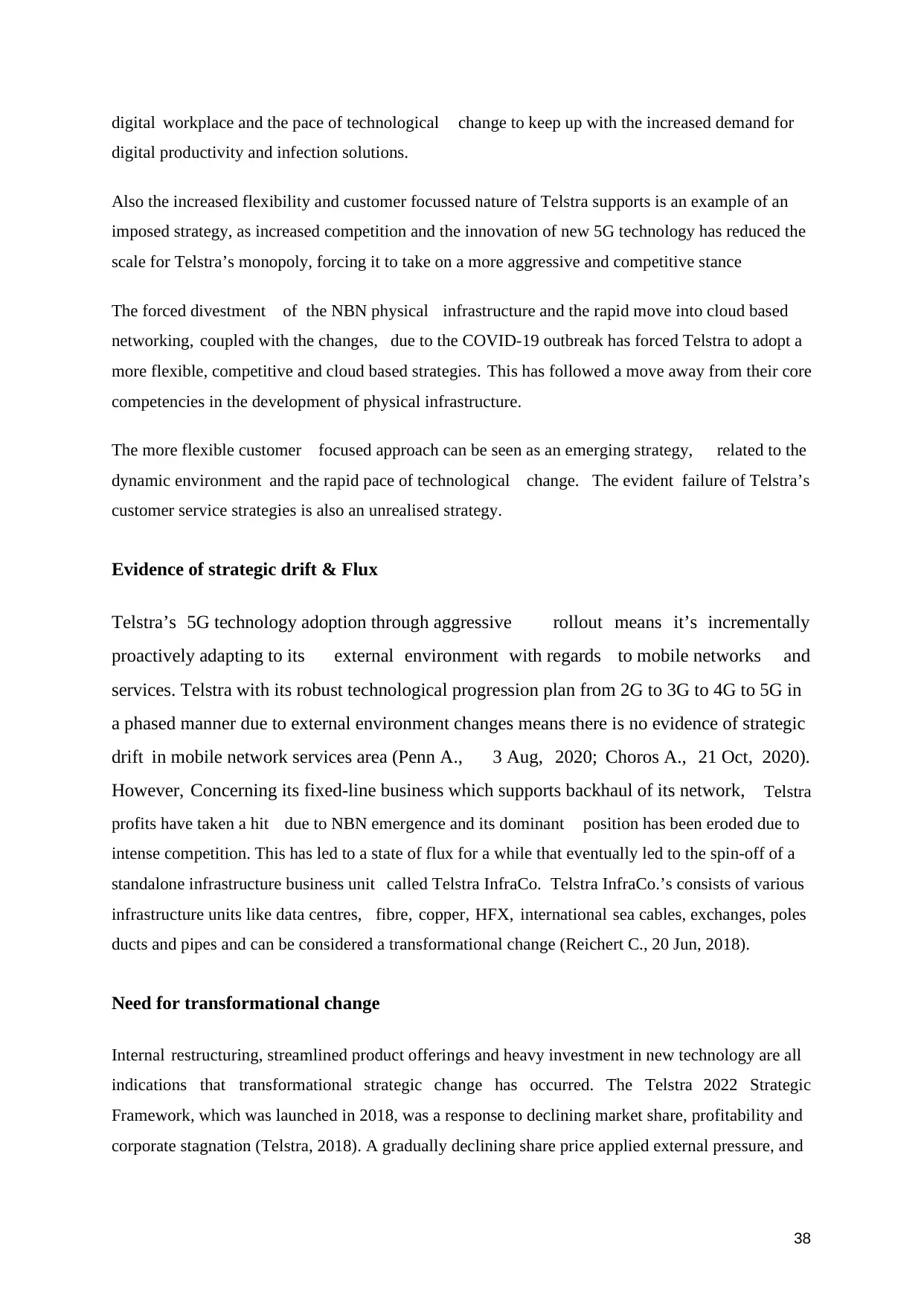
digital workplace and the pace of technological change to keep up with the increased demand for
digital productivity and infection solutions.
Also the increased flexibility and customer focussed nature of Telstra supports is an example of an
imposed strategy, as increased competition and the innovation of new 5G technology has reduced the
scale for Telstra’s monopoly, forcing it to take on a more aggressive and competitive stance
The forced divestment of the NBN physical infrastructure and the rapid move into cloud based
networking, coupled with the changes, due to the COVID-19 outbreak has forced Telstra to adopt a
more flexible, competitive and cloud based strategies. This has followed a move away from their core
competencies in the development of physical infrastructure.
The more flexible customer focused approach can be seen as an emerging strategy, related to the
dynamic environment and the rapid pace of technological change. The evident failure of Telstra’s
customer service strategies is also an unrealised strategy.
Evidence of strategic drift & Flux
Telstra’s 5G technology adoption through aggressive rollout means it’s incrementally
proactively adapting to its external environment with regards to mobile networks and
services. Telstra with its robust technological progression plan from 2G to 3G to 4G to 5G in
a phased manner due to external environment changes means there is no evidence of strategic
drift in mobile network services area (Penn A., 3 Aug, 2020; Choros A., 21 Oct, 2020).
However, Concerning its fixed-line business which supports backhaul of its network, Telstra
profits have taken a hit due to NBN emergence and its dominant position has been eroded due to
intense competition. This has led to a state of flux for a while that eventually led to the spin-off of a
standalone infrastructure business unit called Telstra InfraCo. Telstra InfraCo.’s consists of various
infrastructure units like data centres, fibre, copper, HFX, international sea cables, exchanges, poles
ducts and pipes and can be considered a transformational change (Reichert C., 20 Jun, 2018).
Need for transformational change
Internal restructuring, streamlined product offerings and heavy investment in new technology are all
indications that transformational strategic change has occurred. The Telstra 2022 Strategic
Framework, which was launched in 2018, was a response to declining market share, profitability and
corporate stagnation (Telstra, 2018). A gradually declining share price applied external pressure, and
38
digital productivity and infection solutions.
Also the increased flexibility and customer focussed nature of Telstra supports is an example of an
imposed strategy, as increased competition and the innovation of new 5G technology has reduced the
scale for Telstra’s monopoly, forcing it to take on a more aggressive and competitive stance
The forced divestment of the NBN physical infrastructure and the rapid move into cloud based
networking, coupled with the changes, due to the COVID-19 outbreak has forced Telstra to adopt a
more flexible, competitive and cloud based strategies. This has followed a move away from their core
competencies in the development of physical infrastructure.
The more flexible customer focused approach can be seen as an emerging strategy, related to the
dynamic environment and the rapid pace of technological change. The evident failure of Telstra’s
customer service strategies is also an unrealised strategy.
Evidence of strategic drift & Flux
Telstra’s 5G technology adoption through aggressive rollout means it’s incrementally
proactively adapting to its external environment with regards to mobile networks and
services. Telstra with its robust technological progression plan from 2G to 3G to 4G to 5G in
a phased manner due to external environment changes means there is no evidence of strategic
drift in mobile network services area (Penn A., 3 Aug, 2020; Choros A., 21 Oct, 2020).
However, Concerning its fixed-line business which supports backhaul of its network, Telstra
profits have taken a hit due to NBN emergence and its dominant position has been eroded due to
intense competition. This has led to a state of flux for a while that eventually led to the spin-off of a
standalone infrastructure business unit called Telstra InfraCo. Telstra InfraCo.’s consists of various
infrastructure units like data centres, fibre, copper, HFX, international sea cables, exchanges, poles
ducts and pipes and can be considered a transformational change (Reichert C., 20 Jun, 2018).
Need for transformational change
Internal restructuring, streamlined product offerings and heavy investment in new technology are all
indications that transformational strategic change has occurred. The Telstra 2022 Strategic
Framework, which was launched in 2018, was a response to declining market share, profitability and
corporate stagnation (Telstra, 2018). A gradually declining share price applied external pressure, and
38
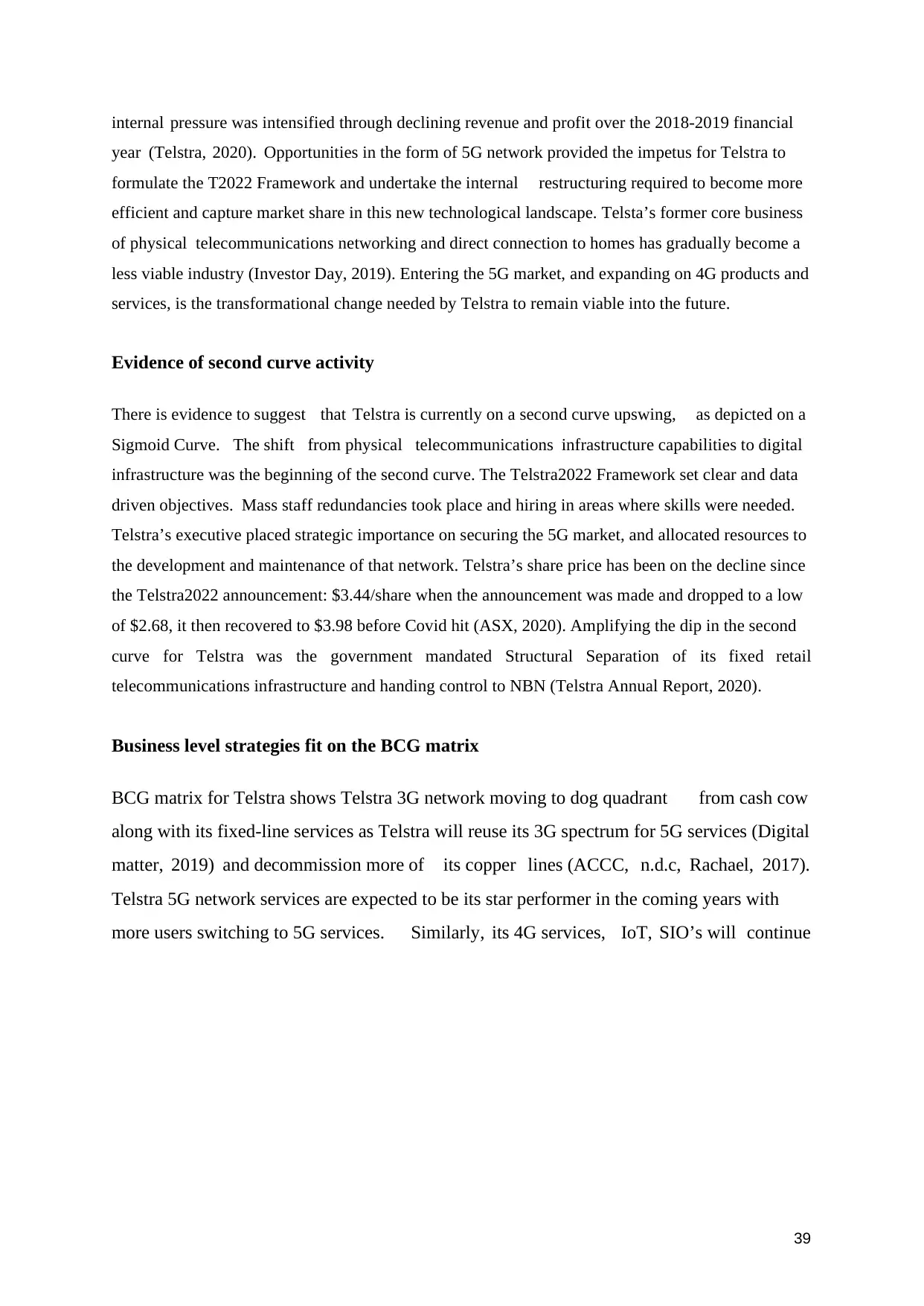
internal pressure was intensified through declining revenue and profit over the 2018-2019 financial
year (Telstra, 2020). Opportunities in the form of 5G network provided the impetus for Telstra to
formulate the T2022 Framework and undertake the internal restructuring required to become more
efficient and capture market share in this new technological landscape. Telsta’s former core business
of physical telecommunications networking and direct connection to homes has gradually become a
less viable industry (Investor Day, 2019). Entering the 5G market, and expanding on 4G products and
services, is the transformational change needed by Telstra to remain viable into the future.
Evidence of second curve activity
There is evidence to suggest that Telstra is currently on a second curve upswing, as depicted on a
Sigmoid Curve. The shift from physical telecommunications infrastructure capabilities to digital
infrastructure was the beginning of the second curve. The Telstra2022 Framework set clear and data
driven objectives. Mass staff redundancies took place and hiring in areas where skills were needed.
Telstra’s executive placed strategic importance on securing the 5G market, and allocated resources to
the development and maintenance of that network. Telstra’s share price has been on the decline since
the Telstra2022 announcement: $3.44/share when the announcement was made and dropped to a low
of $2.68, it then recovered to $3.98 before Covid hit (ASX, 2020). Amplifying the dip in the second
curve for Telstra was the government mandated Structural Separation of its fixed retail
telecommunications infrastructure and handing control to NBN (Telstra Annual Report, 2020).
Business level strategies fit on the BCG matrix
BCG matrix for Telstra shows Telstra 3G network moving to dog quadrant from cash cow
along with its fixed-line services as Telstra will reuse its 3G spectrum for 5G services (Digital
matter, 2019) and decommission more of its copper lines (ACCC, n.d.c, Rachael, 2017).
Telstra 5G network services are expected to be its star performer in the coming years with
more users switching to 5G services. Similarly, its 4G services, IoT, SIO’s will continue
39
year (Telstra, 2020). Opportunities in the form of 5G network provided the impetus for Telstra to
formulate the T2022 Framework and undertake the internal restructuring required to become more
efficient and capture market share in this new technological landscape. Telsta’s former core business
of physical telecommunications networking and direct connection to homes has gradually become a
less viable industry (Investor Day, 2019). Entering the 5G market, and expanding on 4G products and
services, is the transformational change needed by Telstra to remain viable into the future.
Evidence of second curve activity
There is evidence to suggest that Telstra is currently on a second curve upswing, as depicted on a
Sigmoid Curve. The shift from physical telecommunications infrastructure capabilities to digital
infrastructure was the beginning of the second curve. The Telstra2022 Framework set clear and data
driven objectives. Mass staff redundancies took place and hiring in areas where skills were needed.
Telstra’s executive placed strategic importance on securing the 5G market, and allocated resources to
the development and maintenance of that network. Telstra’s share price has been on the decline since
the Telstra2022 announcement: $3.44/share when the announcement was made and dropped to a low
of $2.68, it then recovered to $3.98 before Covid hit (ASX, 2020). Amplifying the dip in the second
curve for Telstra was the government mandated Structural Separation of its fixed retail
telecommunications infrastructure and handing control to NBN (Telstra Annual Report, 2020).
Business level strategies fit on the BCG matrix
BCG matrix for Telstra shows Telstra 3G network moving to dog quadrant from cash cow
along with its fixed-line services as Telstra will reuse its 3G spectrum for 5G services (Digital
matter, 2019) and decommission more of its copper lines (ACCC, n.d.c, Rachael, 2017).
Telstra 5G network services are expected to be its star performer in the coming years with
more users switching to 5G services. Similarly, its 4G services, IoT, SIO’s will continue
39
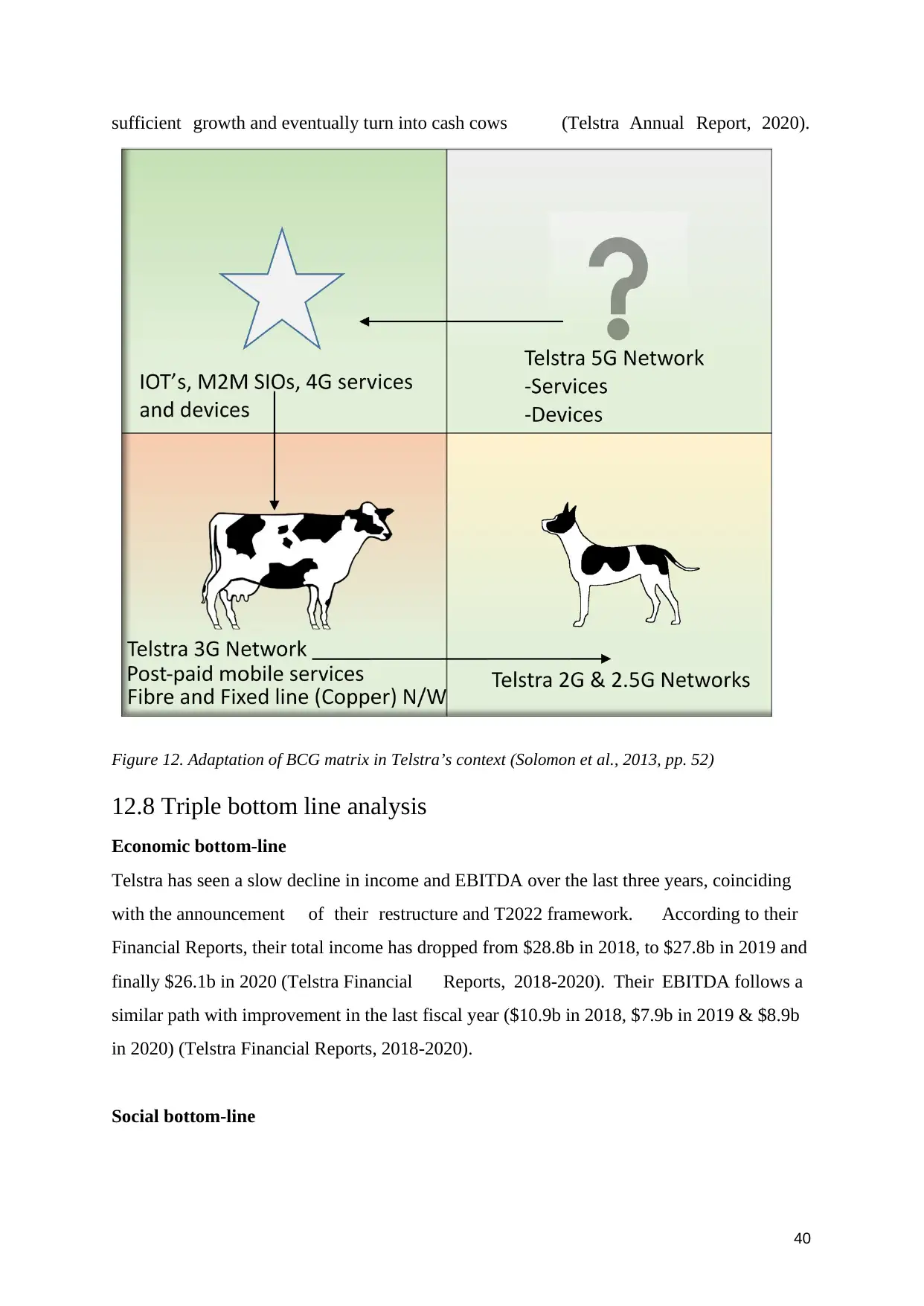
sufficient growth and eventually turn into cash cows (Telstra Annual Report, 2020).
Figure 12. Adaptation of BCG matrix in Telstra’s context (Solomon et al., 2013, pp. 52)
12.8 Triple bottom line analysis
Economic bottom-line
Telstra has seen a slow decline in income and EBITDA over the last three years, coinciding
with the announcement of their restructure and T2022 framework. According to their
Financial Reports, their total income has dropped from $28.8b in 2018, to $27.8b in 2019 and
finally $26.1b in 2020 (Telstra Financial Reports, 2018-2020). Their EBITDA follows a
similar path with improvement in the last fiscal year ($10.9b in 2018, $7.9b in 2019 & $8.9b
in 2020) (Telstra Financial Reports, 2018-2020).
Social bottom-line
40
Figure 12. Adaptation of BCG matrix in Telstra’s context (Solomon et al., 2013, pp. 52)
12.8 Triple bottom line analysis
Economic bottom-line
Telstra has seen a slow decline in income and EBITDA over the last three years, coinciding
with the announcement of their restructure and T2022 framework. According to their
Financial Reports, their total income has dropped from $28.8b in 2018, to $27.8b in 2019 and
finally $26.1b in 2020 (Telstra Financial Reports, 2018-2020). Their EBITDA follows a
similar path with improvement in the last fiscal year ($10.9b in 2018, $7.9b in 2019 & $8.9b
in 2020) (Telstra Financial Reports, 2018-2020).
Social bottom-line
40
Secure Best Marks with AI Grader
Need help grading? Try our AI Grader for instant feedback on your assignments.
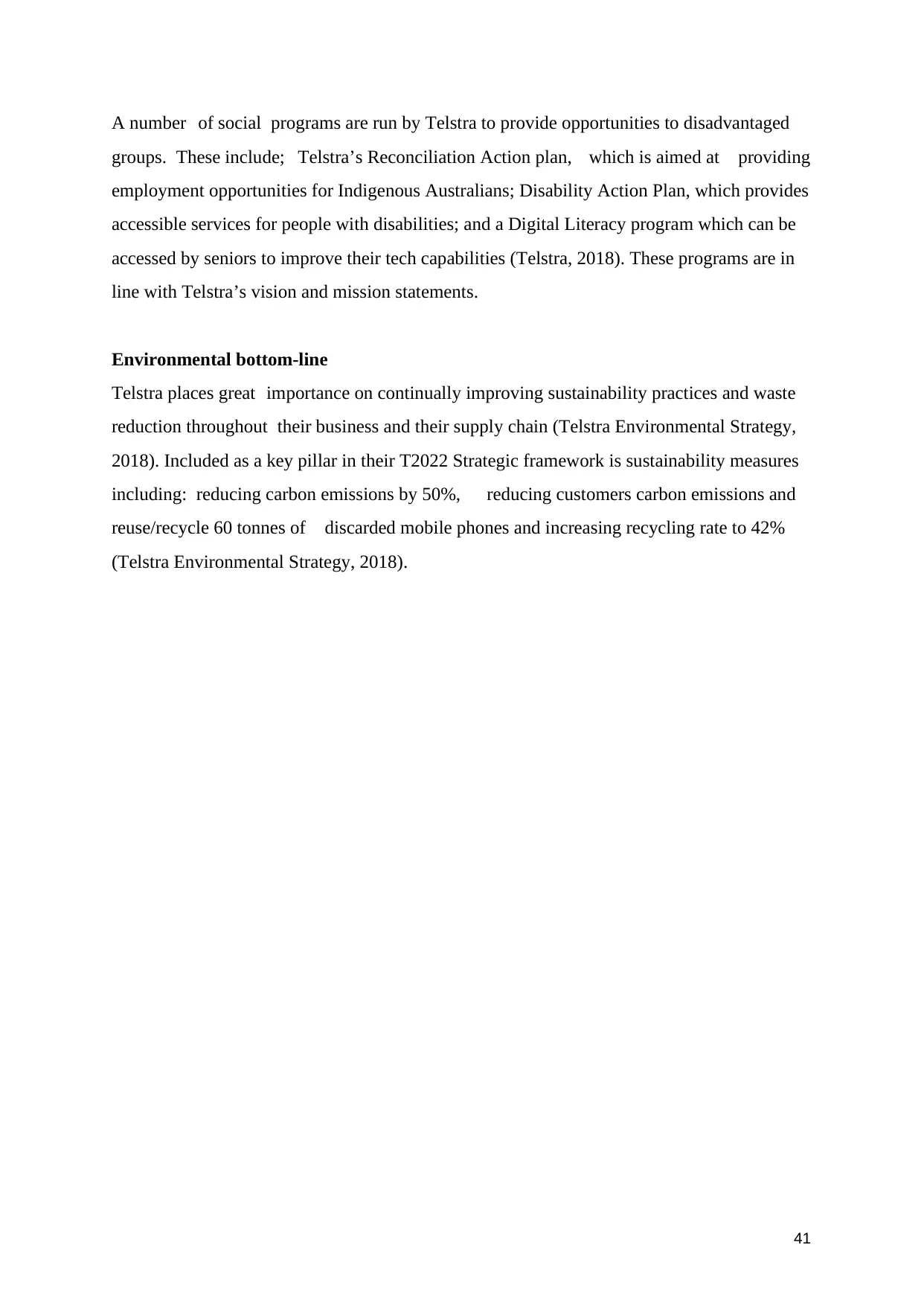
A number of social programs are run by Telstra to provide opportunities to disadvantaged
groups. These include; Telstra’s Reconciliation Action plan, which is aimed at providing
employment opportunities for Indigenous Australians; Disability Action Plan, which provides
accessible services for people with disabilities; and a Digital Literacy program which can be
accessed by seniors to improve their tech capabilities (Telstra, 2018). These programs are in
line with Telstra’s vision and mission statements.
Environmental bottom-line
Telstra places great importance on continually improving sustainability practices and waste
reduction throughout their business and their supply chain (Telstra Environmental Strategy,
2018). Included as a key pillar in their T2022 Strategic framework is sustainability measures
including: reducing carbon emissions by 50%, reducing customers carbon emissions and
reuse/recycle 60 tonnes of discarded mobile phones and increasing recycling rate to 42%
(Telstra Environmental Strategy, 2018).
41
groups. These include; Telstra’s Reconciliation Action plan, which is aimed at providing
employment opportunities for Indigenous Australians; Disability Action Plan, which provides
accessible services for people with disabilities; and a Digital Literacy program which can be
accessed by seniors to improve their tech capabilities (Telstra, 2018). These programs are in
line with Telstra’s vision and mission statements.
Environmental bottom-line
Telstra places great importance on continually improving sustainability practices and waste
reduction throughout their business and their supply chain (Telstra Environmental Strategy,
2018). Included as a key pillar in their T2022 Strategic framework is sustainability measures
including: reducing carbon emissions by 50%, reducing customers carbon emissions and
reuse/recycle 60 tonnes of discarded mobile phones and increasing recycling rate to 42%
(Telstra Environmental Strategy, 2018).
41
1 out of 41
Related Documents
Your All-in-One AI-Powered Toolkit for Academic Success.
+13062052269
info@desklib.com
Available 24*7 on WhatsApp / Email
![[object Object]](/_next/static/media/star-bottom.7253800d.svg)
Unlock your academic potential
© 2024 | Zucol Services PVT LTD | All rights reserved.




